#especially when han and bon are dating
Text


jurassic park // june gloom
stand atlantic hot milk
#these song parallels just get better and better#especially when han and bon are dating#stand atlantic#hot milk#bonnie fraser#david potter#jonno panichi#miki rich#hannah mee#jim shaw#hardy deller#tom paton#pop punk#music#lyrics#lyric parallels
63 notes
·
View notes
Text
The Usual Shows I am Watching List
For the next week or so at least (obviously, I am unlikely to watch every single one on the list, but they are all in the running; it’s like a preview for posts I am likely to make).
The Abyss (Korea) - I am a few eps behind and, frankly, the drama about two dead people brought back into different bodies, hunting a serial killer and finding love, should be more engaging and smarter than it is, but it’s a pleasant easy watch and I am very fond of the two leads.
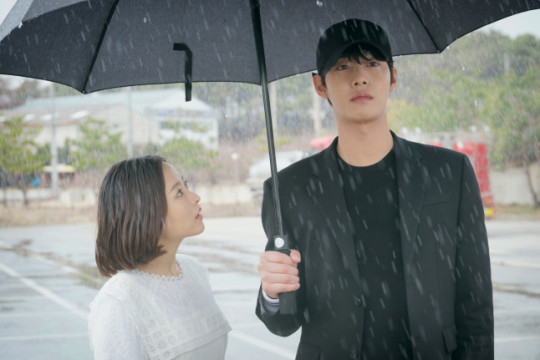
Angel’s Last Mission (Korea) - I am only two eps in, but the gorgeous intensity reminds me of old-school kdrama melos that I love so much. A bitter blind ballerina and an angel who is supposed to help her find love but falls for her instead is probably doomed for disaster in terms of happy ending, but I will be eating up all the pain!

Arthdal Chronicles (Korea) - grim (but not too grim) cool and otherwordly fantasy. I still don’t care for any characters, but the drama itself is great to watch.

Cage of Love (China) - surprisingly, not a BDSM tale. Hawick Lau wears amazing outfits and seeks revenge while trying to clear himself from being framed on a regular basis and dealing with heroine who sometimes loves him and sometimes thinks he is the resident serial killer. I started it years ago and now feel like continuing.
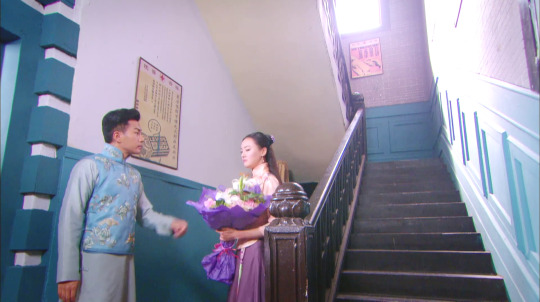
The Crowned Clown (Korea) - I need a sageuk in my life and watching Yeo Jin Gu in the pretty inferior Absolute Boyfriend made me remember how impressed I was by him playing both a psycho king and a sweet acrobat doppleganger who replaces him, so I restarted it.
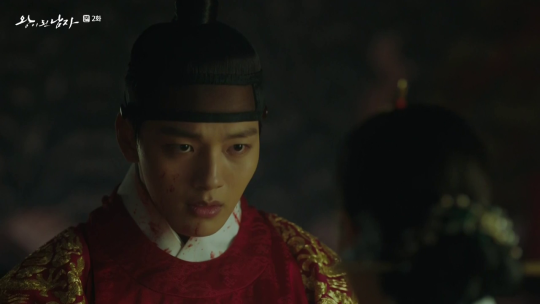
Good Omens (UK) - loved the book when I read it a gazillion years ago and the first ep was good!

Heart of Stone/Hua Jai Sila (Thailand) - basically a 1980s romance crack about a pimp who comes back for revenge on his stepmom and falls for his childhood friend, this is insane! But addictive! Also make-outs!

Here to Heart (China) - it’s on my list and I may or may not get to it. I like the angsty premise and credits (they used to be lovers until she broke his heart in what I am sure is either a misunderstanding or noble idiocy), now he is mega rich and she is hired as his assistant, but Zhang Han has never clicked with me for some reason. He’s good-looking, he’s an OK actor, but for whatever reason he just doesn’t have that “it” for me. Maybe this drama will change that.

Just Between Lovers (Korea) - when it was airing and people were falling madly in love with it, I was in a kdrama slump that no kdrama could cure. But now - oh, this is so achingly, perfectly, emotionally gorgeous. Only one ep in, but I already know this will be a keeper.
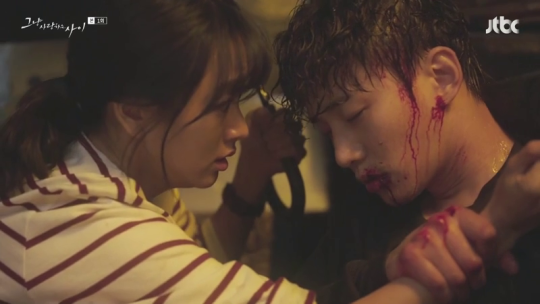
Kimse Bilmez (Turkey) - the one Turkish entry on this list! Starts on Tuesday, promises angst, women in danger, macho traditional men who defend them blah blah blah. As a modern feminist, I should probably be appalled, but I like what I like and gimme gimme gimme!

Le Coup de Foudre (China) - I just want to see the aristocrat daughter and the hot constable from An Oriental Odyssey be an OTP, all right?

Legend of Fuyao (China) - am on ep 22 I think. It’s pretty and shippy and I won’t stay awake freaking out about characters or plot twists, but watching Ethan Ruan worship the ground Yang Mi walks on never gets old.
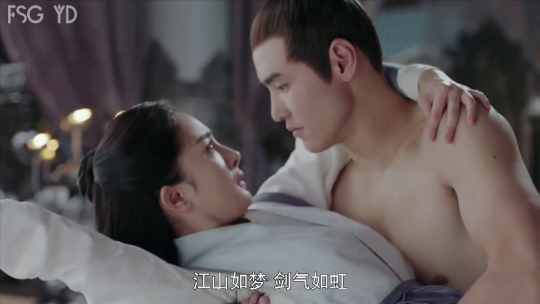
Legend of the Phoenix (China) - on ep 4! Get subbed quicker for my sanity, pls. Love story, scheming courtiers, angst, period costumes. What more does a girl need? Jeremy Tsui looking scrumptious, apparently.

The Legends (China) - finally hit ep 20! I like it and it’s a relaxing, fun, cute watch. Though if Zhao Yao figures out Demon Boy likes her before at least a dozen eps pass, despite him doing everything but carving “I love Zhao Yao” into his chest, I would faint from shock.
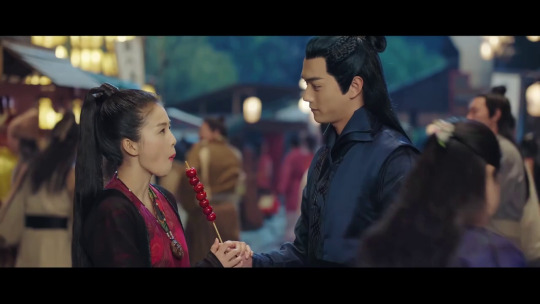
Letting You Float Like a Dream (China) - I am excited Young Lord from Minglan gets to be the hero of his own story and get the girl he wants (even if he has to reincarnate a couple of times first), plus look cool in 1930s duds. This is very much my thing.

Likit Ruk/The Crown Princess (Thailand) - sometimes a lady just wants to watch a good, old-fashioned princess x bodyguard romance, especially when said princess and bodyguard are hot enough to set the Chao Praya river on fire.

Listening Snow Tower (China) - on ep 38 now. Gorgeous visuals, awesome fights, and the Victorian duality of the chaste and almost unspoken but frighteningly intense romance is so my jam. But if they kill the hero, I will riot. Let him and Lady Badass wuxia into sunset together, pls.
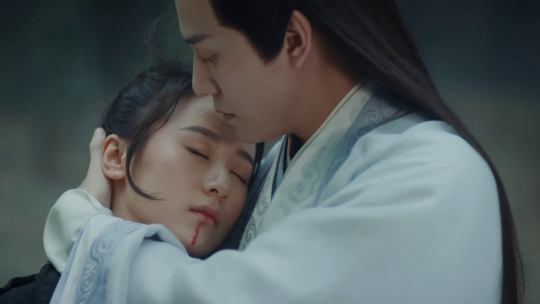
My Absolute Boyfriend (Korea) - I am all up to date with this one. Which is weird because I am not up to date on other dramas I like more. This is a giant meh emotionally, and wastes some really good actors, but it is so good-naturedly unoffensive, I can’t even complain. Still, perhaps the story of a lady buying a lovebot should have stayed solely in manga form because I’ve never seen an amazing adaptation of it.
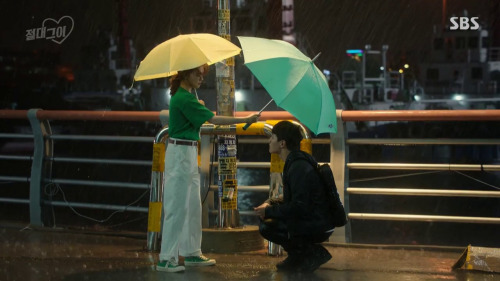
Pretty Man (China) - I liked the first ep, and you have no idea how rare it is for me to say that about a contemporary cdrama. Childhood loves who find second chances yes pls.

Princess Silver (China) - Yuu Watase, is that you? Did you write this? Cracky, not too serious, but seriously addictive, this is a chocolate bon bon in drama form. PS Pls cure the prince of his touch phobia through LOTS of skinship, princess!
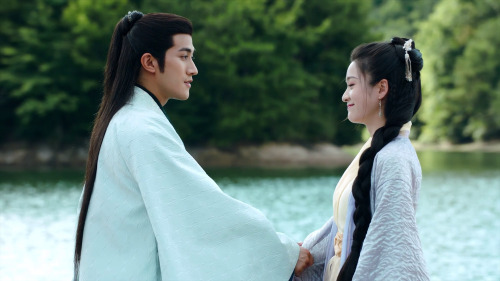
Siege in Fog (China) - romantic dysfunction reigns supreme, even more so than gorgeous 1930s outfits and people. Elvis Han and Sun Yi boil my blood in amazingly pleasant ways as two people in a marriage of inconvenience, where he pines for her but won’t show it and she loves another, until she wakes up and realizes that HELLO IT’S SEX ON LEGS ELVIS, I NEED TO GET SOME OF THAT! And the civil war says, “not so fast!”
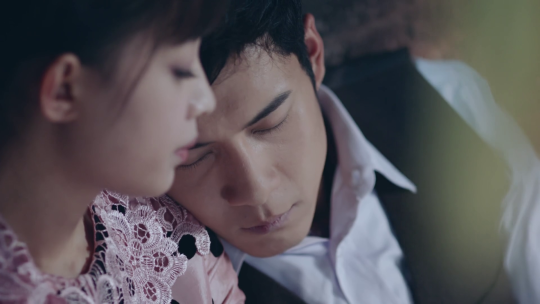
Too Late To Say I Love You (China) - I started it years ago when it was not fully subbed and loved it because in my secret heart-of-hearts, I too want a mega hot warlord who looks like Wallace Chung and has stylish 1930s cars and a private army to sweep me off my feet and obsess over me in an unhealthy but hormonally incredible fashion as if I am the only woman in the world. SiF reminded me of this so here we are.
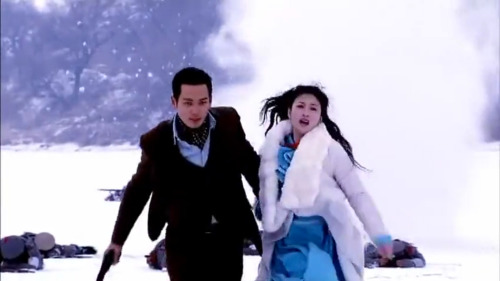
Tried and dropped:
The Plough Department of Song Dynasty (China) - watched one episode, felt my brain leaking out of my ears and bailed. Granted, I watch plenty of dumb stuff so far be it from me to act high and mighty about a bit of brainless fun, but I don’t like mysteries, there was no angst, and I couldn’t care less if all the characters fell into a giant pit, so here we go...
Well Intended Love (China) - people didn’t like it because the male lead was a sociopath. I didn’t like it because it was cutesy and boring and nobody in it bothered to act (or couldn’t.) I bailed long before the dysfunction, that’s how bored I was.
#cdrama#kdrama#lakorn#too late to say i love you#siege in fog#arthdal chronicles#the abyss#my absolute boyfriend#absolute boyfriend#the plough department of song dynasty#well intended love#the legend of fuyao#legend of fuyao#legend of the phoenix#the legends#angel's last mission: love#angel's last mission#princess silver#listening snow tower#snow tower#pretty man#le coup de foudre#here to heart#likit ruk#hua jai sila#the crown princess#letting you float like a dream#heart of stone#cage of love#kimse bilmiz
2K notes
·
View notes
Text
Goodbye 2019. Hello 2020.
To celebrate the new year - which a lot of people are celebrating right now, I’m sure, unfortunately not me yet - I decided to create this post. I don’t know how to explain it but if you like kpop, keep reading!
My Top 3 Songs of 2019
1. SKZ - Miroh
This song got me into my now ult group, Stray Kids. Those 9 boys have honestly made this year 10x better for me. Chan’s VLives definitely helped me when I was upset, and the members made me feel emotions by their side. I’m so glad that add of Miroh appeared and I chose to watch it because I may have not gotten into Stray Kids without it.
2. ATEEZ - Wave
Again, another song that got me into the group. I heard the song in a video where they played huge jenga at Kcon... I think? Anyways, this song is another banger and you completely fall in love with it first listen. You won’t regret listening to this.
3. TWICE - Fancy
I got into TWICE when they released YES OR YES, but FANCY is the song that you can’t not fall in love with. I did on my 2nd listen and man, if you’re saying you didn’t learn the dance and bopped to this song, you are LYING because- let’s be honest - everyone said FANCY SOTY.
Groups I began stanning in 2019 its felt like forever tho
Stray Kids - March 26th. You think I would forget?
ATEEZ - August 18th. Another date I remember, because I spent a good 2 hours getting to memorize the members name and faces. Was so happy when I finally did it.
iKON - Honestly, I was more of a Double B stan since January until Hanbin left. I loved their songs but I never got to know the rest of the members, except for Jinhwan.
ChungHa - Snapping dragged me in. That’s all I gotta say. Although, ngl, Gotta Go was something I always tried to dance to.
KARD - Again, Bomb Bomb just pulled me into the fandom. The rest of their discography made me stay. I sang along to Bomb Bomb everyday for a good 3 months. It was honestly EVERYTHING to me and then Dumb Litty came and stole my heart and KARD did it AGAIN.
Mamamoo - gogobebe. Do I really need to say anything else?
GOT7 - I’m pretty sure I got into them because, well everyone knows GOT7. They’re a name everyone knows if you like kpop, so I just wanted to get into them. Eclipse and You Calling My Name are songs I’ll dance and singalong to in the right mood and right part of the song. But their personalities dragged me in. I’m pretty sure BamBam also attracted me when he was on Stray Kids reality show.
Day6 - Time Of Our Life. I decided to listen to it because Seungmin of Stray Kids was a big fan of them and I was like, it shouldn’t hurt to try. Seungmin made me want to watch and Day6 made me want to stay. They don’t make ANY bad songs.
Everglow - March 18. Listened to Bon Bon Chocolat when it came out, and I was honestly scared ppl were gonna sleep on them cause ITZY debuted a month before. Fortunately, everyone noticed their talent.
BigBang - I dunno just listened to one of their songs. And, of course, I fell in love. Too late to stan them while they were active, but I’m expecting something in 2020... just saaying.
NCT - All of the subunits. Honestly there were so many of them, I spent time taking tests to tell them apart. The struggle to stan these boys. Instantly fell in with the Dreamies. And then I found out they weren’t a fixed unit... My heart shattered. It’s still breaking because 4 OF THEM ARE LEAVING. or left. I dunno.
Tomorrow by Together - They were probably the most anticipated group of this year. I remember ppl hyping them up in October of 2018! Predebut stan right here. (I just remembered that I thought the preview of each member was coming out in age order and thinking that Beomgyu was the youngest. And I was just like WHERE IS HEUNINGKAI FROM?!?!)
ITZY - remember when everyone thought that itzy’s debut was rushed because info about them was leaked. yeah, i forgot too. anyways, again I was a predebut stan.
(G)- idle - i always listened to their title tracks and I began stanning them during Queendom after their Fire cover im listening to 2ne1 2015 mama fire performance rn lol.... omg bom’s han cover just started playing. spotify is watching me guys.
Somi - Birthday was a bop. fight me. outfits sucked, gotta agree with that opinion I didn’t rlly know much about IOI but I started stanning because Jenchu were fangirling to it i mean jennie twerked for it!
Jimin Park - I’m out here still streaming STAY BEAUTIFUL. honestly she’s so loveable. her personality and her voice are everything. how can you not like her
My Top 5 Groups of the Year
1. STRAY KIDS - A lot of the reasons I luv them are the same as ATEEZ. That’s why ateez are close to being my number one, but honestly these 9 boys are everything to me. 9 or NONE FOREVER. They have been through so much this year and I hope they STAY strong for 2020. In their 2020 seasons greeting they announced a full album next year, so I’m ready to follow these boys on their journey no matter how many stay or leave. I’m a STAY for a reason.
2. ATEEZ - PERSONALITY. I’m also a sucker for groups that shove their love for each other in your face. 8 makes 1 team, y’know? Hongjoong and Mingi are amazing rappers, Jongho, Wooyoung and San’s vocals tho, Yunho and Seonghwa’s deep voices are the death of me, and Yeosang dancing. They’re talented and luvable and that’s all I need for an ult group. also all their songs are bops
3. Mamamoo - Honestly would’ve tied with Twice but these I’m a sucker for them as ppl as well, and I need that to luv a group. they ain’t fake, they slap information in your face and they are POWERFUL WOMAN. (Not saying twice aren’t ofcourse) And these girls vocals are on POINT. Moonbyul is rapper material, but have you heard the girl song? What an angel. Their songs are all slaps, especially the most recent ones.
4. TWICE - This was their year? yes or yes. Fancy soty. Feel Special was a great title track, don’t get me wrong, bUT HAVE YOU HEARD THE FULL ALBUM. Every song is my AMAZING. omg rainbow is playing
5. NCT DREAM - These boys stole my heart, I only stanned nct because of them. Honestly seeing the 00 line leave breaks my heart.
My Top 5 girl group and boy group songs
gg songs were honestly so hard to pick, they thrived and SO many good songs were made in 2019. But here is my list.
1. Fancy - soty
2. Hip - this song was everything from the choreo to the song itself to the girls energy performing it
3. Psycho - came out like last week but it’s in everyone's top 10 of this year. Beautiful song that won’t get outta my head. getwellsoonwendy.
4.Violeta - this is another song that won’t get out of my head. honestly none of these songs will. ok so the final dance part after the drop of violeta pisses me off because the dance could is so powerful and that part comes and it’s such a disappointment but it’s the only part I can do so i shouldn't complain but the song itself is very catchy. I don’t want these girls to disband even if the votes were rigged because they make a good group and sing bangers. i don't want them to leeeave.
5.Lion - the song is just so powerful. other songs they’ve made are good, but the chorus is usually a disappointment because the pre chorus is so good but EVERYTHING is great about Lion. Didn’t like it at first for some reason, i dunno why, but once you give it a few more listens you’ll fall in love.
Now onto the boy groups. They made quite a few bangers this year as well.
1. Miroh - It’s my no.1 of the year. watchu expect?
2. Wave - and this is my no.2. Again, what else would I put here?
3. Run Away - what. a. bop. still can’t get out of my head. Crown was a disappointment to me after 1000 listens but not Run Away. A bonus is the Harry Potter references. With that I just was head over heels in love. Txt didn’t fail to disappoint with their comeback even if it was pushed back.
4. Boom - This song made me fall in love with the talent that NCT DREAM holds despite being so young. Sang along for a few months. Actually, it’s still in my head.
5. Make It Right - I was doing title tracks for all these but then I realised there has to be an exception because I just really like this song, especially the one featuring Lauv. Boy with luv wasn’t it for me but every other song on Persona is a straight up masterpiece (ok an exaggeration but u get what i mean)
Now onto the soloists (they’re all female, sry not sry)
1. Chica - I was debating whether to put Snapping or this but decided with Chica. Honestly the vocals, the song, the dance, the MESSAGE, is everything. I love it, it empowers woman, it makes ME feel good, and it’s what some people really need sometimes. So, thank you ChungHa.
2. Gotta Go - another bop by our queen ChungHa, she really ruled this year. I didn’t stan her when it came out but that doesn’t mean I didn’t do the ‘deulshi’ part whenever I heard it. iconic.
3. Twit - Again another iconic bop from this year. (i thought this masterpiece came out last year, i dunno why but it just is so 2018 for some reason? I dunno) Hwasa’s solo debut really was everything. So was Moonbyul’s which unfortunately didn't make it on the list but I would say it’s in between 5th to 7th for me.
4. Stay Beautiful - Such a beautiful song, it was a shame Jamie had to leave but she left JYP saying that they lost smth PRECIOUS and they would regret it and she conveyed all that in one song without hinting at it. So many quote worthy lyrics were in the song and it just bring up my mood and my standard for vocals. Don’t sleep on this girl, y’all.
5. Birthday - the song brought out mixed reactions from everyone but i LOVED IT. It did get a bit old but it’s still something you’ll find me singing along to every now and then.
ARTISTS THAT STOOD OUT TO ME THIS YEAR
1. Bang Chan of Stray Kids. I love him. He’s such a great leader, he’s a loveable person, he’s all rounded and he fucks up sometimes but he acknowledges it and fixes it. He went through so much shit this year and he deserves so much more. I, along with many other STAYs are gonna make 2020 a better year for him and all of his group. Stay strong Chan! But besides his personality his stage presence, his rapping, his singing, his producing, his energy, his personality, it all made him someone who was always on my mind.
2. Yeonjun of Tomorrow x Together. He’s also very well rounded and he really stands out to me from all the other 4th gens. Whenever I see a performance by TXT he always grabs my attention even when he’s not the main focus. I love his dancing, it’s very eye catching to me, along with his stage presence. He never loses his energy on stage and I expect a lot from him in 2020! His rapping and singing are amazing as well, especially for a rookie. Also when they first debuted he cried a lot, which was very heartwarming to me because idols showing emotion other than happy is something I appreciate, because it lets me remember they’re human too.
3. Seulgi of Red Velvet. She’s, again, very well rounded. I’m not really a Reveluv, but Wendy and Seulgi are vocalists who really stand out to me so those to kind of make me want to listen to Red Velvet’s songs. She’s an amazing vocalist, like words can’t express how much a love this woman's voice. Her stage presence is amazing as well, she’s just a really good performer imo.
4. Jihyo and Nayeon of TWICE. First of all I really like their personality and how powerful they are. Honestly a wink from them and I’m falling of my chair. Secondly, I don’t know if anyone's noticed but I really like powerful female vocals, and these two have extremely POWERFUL vocals. Have you heard them sing? Just... POWERFUL, that’s all I can really say to describe their voices.
5. Mingi and Hongjoong of ATEEZ. They are rapper that are gonna blow away the whole industry with 3racha, I mean they already have. Did y’all see their performance in MAMA. The RAWEST vocals I heard that whole show. They were obviously not lip syncing, you could hear Mingi panting and he didn’t rap a whole line, and I LOVE that because it is RAW and we need more raw vocals or atleast breaths heard when the artists are dancing because it makes the performance more REAL. also stage presence is amazing from these two, they really know how to hype up a crowd.
ROOKIE GROUPS I EXPECT A LOT FROM NEXT YEAR
sorry my expectations are high for them, but they have stood out tome so much and i couldn’t stand to see them flop.
1. TOMORROW X TOGETHER - they’ve been on this list quite a lot, and I really appreciate their individual talents along with them as a group. I REALLY want to see them improve and grow more next year because they were really pushed this year, being BTS’s juniors. I’m sure they were really stressed but I want them to become TOMORROW BY TOGETHER not BTS’s juniors. Probably won’t happen in a year but hopefully in the next decade.
2. ITZY - another group really known for theing the juniors of TWICE this time. The title tracks they released so far have all been listen to it the first time, you don;t like it, but listen to it the 2nd time and it’s stuck in your head for the next 7 months. Honestly if they keep going like this, it would be like a ITZY thing, and I honestly wouldn’t mind.
3. EVERGLOW - i think everyone just saw bon bon chocolat, gave it a listen, and loved it. but i also heard it was produced by someone who helped produce Crown by TXT and Spring Day by BTS, so there’s another reason ppl may have liked it so much. Adios wasn’t a disappointment at all. Of course, I would also love it if Everglow kept up the “nanana” thing in each of their title tracks.
4. ATEEZ - I don’t think they’ll flop at all next year. I know they just had their 1st year anniversary, but I wouldn’t mind a full album... either way, Imma stick with them because they’ve only released that good shit so far and I’m honestly expecting a somewhat mediocre song at least once in their career next year. Not expecting it though.
5. ONEUS - I haven’t’t talked about them yet but all of oneus’s title tracks are absolute gold. I am a mess for Valkyrie, Twilight AND Lit. They’re all just AMAZING songs. I mean, what did we expect from Mamamoo’s juniors but. They are REALLY good. Just go listen to all their title tracks rn.
And finally, wishes for 2020
- Of course, Wendy to recover after her tragic incident at SBS. Again, I hope she recovers well
- Mina to come back from her hiatus, only if she’s ready to, of course
- BLACKPINK FULL ALBUM. ROSE SOLO. PLEASE.
- Of course, 4th gen to thrive along with 3rd gen and 2nd gen groups
- A full album from stray kids (which was confirmed) and again, maybe for ATEEZ? just maybe?
- More attention for Mamamoo. They are underrated queens.
- Less hate for Tomorrow By Together. People bash them just because they’re BTS’s juniors. they would be praised a less but definitely not doubted way more if they weren’t under Bighit. Yeah, they get luxuries other groups won’t but that doesn’t mean people should degrade them for it.
And with that
I wish everyone a Happy New Year. May your next decade be filled with happiness and joy! omg fancy started playing
also i didn’t have time to properly edit this. then again i am a rambling blog, so what are you expecting?
#kpop#twice#mamamoo#txt#bts#kpop 2020#ateez#everglow#itzy#oneus#jyp#kpop 4th gen#chung ha#somi#queen hwasa#jimin park#chica#snapping#gotta go#twit#stay beautiful#birthday#stray kids#got7#bang chan#choi yeonjun#kang seulgi#im nayeon#park jihyo#song mingi
20 notes
·
View notes
Text
Nampō Roku, Book 2 (26): (1587) Third Month, Third Day, Midday.

26) Third Month, Third Day; Midday¹.
It was agreed that [only] kashi [would be served]².
◦ 4.5-mat [room]³.
◦ [Guests:] Jōko [紹古]⁴, Sōkei [宗惠]⁵.
[Sho [初].]⁶
﹆ Shunkyo [舜擧]⁷, painting of peach[-blossoms]⁸.
◦ Bon-san [盆山] Kiji [紀路]⁹.
◦ Kiri-gama [桐釜], [suspended on the] small[-linked] chain¹⁰.
◦ On the kyū-dai [弓臺]¹¹:
below:
﹆ mizusashi mu-mon [水指 無紋]¹²;
﹆ momo-jiri [モヽ尻]¹³;
﹆ kuchi-boso [口細]¹⁴;
﹆ guru-guru [クル〰]¹⁵;
◦ fukusa [服サ]¹⁶;
above:
◦ On a kō-bon [香盆]¹⁷: kōro Usu-gumo [香爐 薄雲]¹⁸, kōgō futae ao-gai [香合 二重青貝]¹⁹, kyōji-tate [キヤウシ立]²⁰;
◦ Habōki [羽帚]²¹.
After the kōro was passed around, a set of charcoal [was laid in the ro]²².
▵ Sakemono ju-ju [サケ物重〻]²³.
▵ Yomogi no mochi [ヨモキノモチ]²⁴.
▵ Nimono [煮物] tori ・ kushi-awabi ・ shiitake ・ mame ・ musubi-me [鳥 ・ 串アハヒ ・ 椎茸 ・ マメ ・ ムスヒメ]²⁵.
▵ Mizu-kuri [水栗]²⁶.
▵ Sake, two rounds.
Go [後]²⁷.
◦ The toko [was left] as it was.
◦ Kyū-dai [弓臺]:
below:
◦ as it was;
above:
﹆ chaire sasa-mimi [茶入 サヽ耳]²⁸;
◦ on a naka-bon [中盆]²⁹: natsume ・ kasane-chawan ・ ori-tame [ナツメ ・ カサネ茶碗 ・ 折タメ]³⁰.
_________________________
¹San-gatsu mikka, hiru [三月三日、晝].
The Gregorian date of this chakai was April 10, 1587. It was thus nearly high spring, and the earliest of the cherry blossoms would have been getting ready to open.
The occasion for this chakai was the Momo-no-seku [桃の節句], or peach-blossom festival (hence the kakemono). The occasion was also known as the Hina-matsuri [雛祭り], because on this day the girls of the household displayed their collection of hina-ningyō [雛人形] -- small dolls that were dressed and arranged to reproduce the scene of the Imperial court.
Because the morning was occupied with inspecting the dolls (many of which were precious antiques -- especially in the households of the wealthy machi-shū), and partaking of a morning meal replete with festive delicacies, Rikyū and his guests agreed beforehand to limit the food served during this chakai to kashi only (according to his notation).
Rikyū uses an impressive set of utensils, but his focus seems to be on the Peach Festival aspect of the day.
²Kashi ni te, yakusoku [菓子ニて、約束].
That is, he arranged with the guests beforehand that he would only serve kashi. (Though the selection of kashi actually seems at least as substantial as many of his fuller kaiseki -- probably to give the kama time to return to a boil after a new set of charcoal had been added to the fire, while making it clear that the limitation to kashi only was not a sign of parsimony.)
This gathering is what is now called a kashi-chaji [菓子茶事]. Whether it was also an impromptu chakai (as Shibayama Fugen suggests) cannot be known -- Rikyū does not mention when the agreement over the kashi was made -- though the rather large number of different kinds of kashi (most of which were cooked, and some of which required several hours of preparation time) served, along with the special utensils that Rikyū used, argues against this.
³Yojō-han [四疊半].
This was the 4.5-mat room in Rikyū's residence.
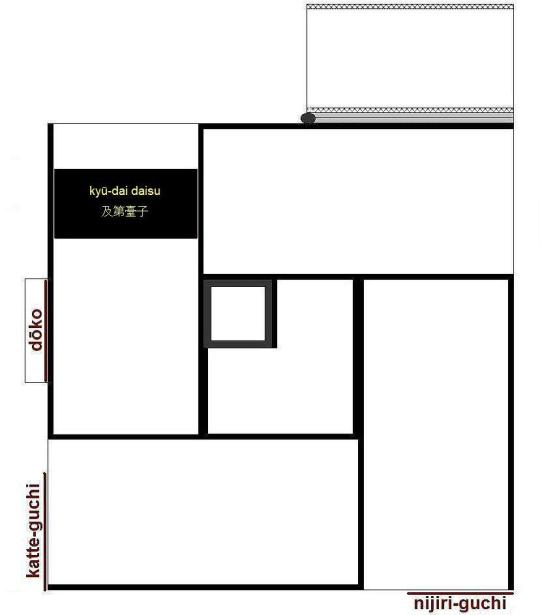
He is still in Sakai.
⁴Jōko [紹古].
Nothing is known about this person*.
That said, however, it is important to point out that both Shibayama Fugen and Tanaka Senshō give a different name: Jōsa [紹佐]†.
Jōsa [紹佐] would refer to the man known as Abura-ya Jōsa [油屋紹佐], the wealthy Sakai machi-shū and chajin who appears to have been a disciple of Jōō. Some scholars identify this person with the man who affected the (Japanese-style) name Date Jōyū [伊達常祐; ? ~ 1579] -- though, given the fact that the present gathering took place in 1587, this could not be him. Perhaps Jōsa was Jōyū’s son‡. The wealthy Abura-ya [油屋] firm, which dealt in oils, was headquartered in Sakai.
At any rate, in addition to his being mentioned several times as a guest in Rikyū's several kaiki, Jōsa is also said to have been closely connected to Kokei oshō -- and presented the monk with thirty strings of coins** for expenses when Kokei moved from Sakai to the Daitoku-ji in Kyōto.
__________
*This name is found only in the Enkaku-ji version of Book Two of the Nampō Roku (and in Kumakura Isao's modern Japanese rendering, which more or less follows the Enkaku-ji text).
Neither Hisamatsu Shin-ichi (the editor of the Sadō Koten Zen-shu [茶道古典全集] edition of the Enkaku-ji text), nor Kumakura Isao, do any more than list this name without comment.
The fact that the other manuscripts generally agree on a different name (as has been mentioned before, Tanaka Senshō had access to Jitsuzan's original notes -- the same notes from which Jitsuzan himself copied) suggests that Tachibana Jitsuzan may have made a mistake when he transcribed this kaiki from his notes into the notebook that he was preparing for presentation to the Enkaku-ji.
†Tanaka Senshō also includes a note suggesting that some other copies give the name as Jōrin [紹林] -- though he seems to feel that this is not credible.
Jōrin [紹林] would refer to Tateishi Jōrin [立石紹林; his dates of birth and death unknown], another machi-shū chajin from Sakai, who had apparently studied chanoyu with Jōō (as attested to by his name). Jōrin was a guest at chakai that Rikyū gave on the 25th of the Second Month, the 26th day of the Twelfth Month of the previous year; and he is also mentioned as having introduced Maruyama Bansetsu [丸山晩雪] to Rikyū (Bansetsu was entertained by Rikyū on the 27th Day of the First Month), suggesting that Jōrin and Rikyū were close friends.
‡And so Jōsa would have assumed the name of Jōyū when he succeeded to the headship of the Abura-ya firm -- as was customary in many families during that period.
Jōyū certainly studied chanoyu from Jōō; but Jōsa is held, by certain scholars, to have been a disciple of Rikyū. This conundrum could be explained quite easily if the two were indeed father and son.
**“Zeni san-jū kanmon” [錢卅貫文]: 30,000 copper coins -- weighing some 112.5 kg.
⁵Sōkei [宗惠].
This was Mizuochi Sōkei [水落宗惠; his dates of birth and death are unknown], a respected machi-shū chajin from Sakai*. He is also said to have been the father of Rikyū's son-in-law, the man usually known as Sen no Jōji [千紹二]†.
Sōkei is mentioned as having been a guest at several other chakai that are recorded in Rikyū's kaiki (his most recent previous appearance having been on the 5th day of the Second Month, together with Kokei oshō and Nambō Sōkei‡), as well as in many other documents that have survived from this period.
__________
*Some suggest that he was also one of Rikyū's disciples (though it is more likely that he was a member of the group that formed around Rikyū in the years after Jōō’s death -- given Sōkei’s contemporary reputation as a chajin).
†He is usually known as Sen no Jōji because Rikyū adopted him into the Sen family upon his marriage to his daughter (a common enough practice at that time when a man had fathered few or no sons).
‡Implying that he may have been a member of their circle as well.
⁶Sho [初].
This notation, which means the shoza, is not found in the Enkaku-ji manuscript -- though both Tanaka Senshō's and Shibayama Fugen's manuscripts are so marked.
With respect to the kane-wari:
- the toko contained the kakemono, with a bon-san arranged on the floor in front of it, and so was chō [調];
- the room had the kama in the ro, meaning it was han [半];

- and as for the daisu, the kaigu were han [半] (because, while there were four objects, either the futaoki, or the koboshi, shared a kane with the shaku-tate), while the kō-bon and habōki on the ten-ita were chō [調] (each contacted yang-kane), giving a total of han [半] for the tana.
Chō + han + han is chō, which is appropriate for the shoza of a gathering held during the daytime.
⁷Shunkyo [舜擧].
Shùn-jǔ [舜擧] is one of the names used by the Chinese painter Qián Xuǎn [錢選; 1235 ~ 1305], who is also known as Yù-tán [玉潭], and who was active from the late Song into the early Yuan dynasty.
It is said that, though Qián Xuǎn was trained as a scholar, he did not succeed in advancing in the Song officialdom satisfactorily; while the collapse of the regime followed by the establishment of the Yuan dynasty, lead to a refusal to consider aiding the new overlords out of a sense of loyalty to Song (and so, China).
After 1276 Qián Xuǎn devoted himself to painting, and became famous for his realistic depiction of various textures (“fur and feathers”), as well as depictions of natural subjects. His works frequently display a nationalistic inclination, and harp back to the works of the Tang and Song dynasties.
⁸Momo[-no-]e [桃繪].
Among Qián Xuǎn's surviving paintings is one that is known as “a broken-off branch of peach blossoms” (Zhézhī táo-huā [折枝桃花]), shown below, though it is not certain whether this was the painting displayed by Rikyū on this occasion or not.
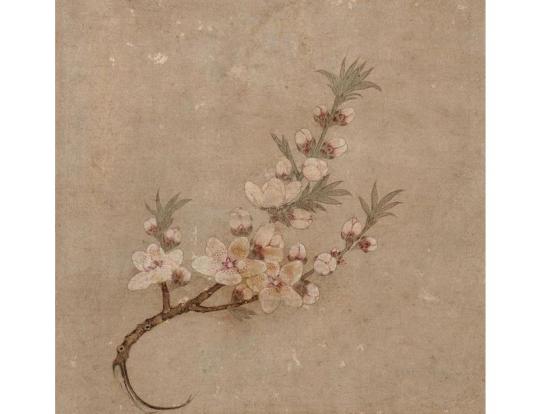
This painting, nevertheless, well illustrates Qián Xuǎn's technique.
⁹Bon-san Kiji [盆山 紀路].
Kiji [紀路]* was the name of a famous bon-san [盆山]†. Below is a photograph of a different bon-san, known as Sue no matsu-yama [末ノ松山], which it may have resembled, arranged in the naka maru-bon [中丸盆] that was made for Ashikaga Yoshimasa by Haneda Gorō‡.
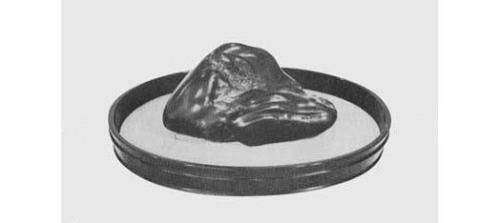
The Kiji viewing stone has never been located, if it still exists.
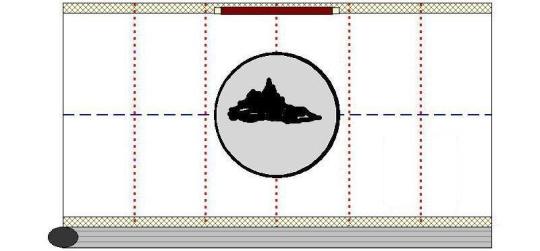
On this occasion it was displayed on the floor of the toko, in front of the scroll, as shown above.
__________
*This was the name of a road traversing the mountains, that was renowned for its scenic beauty, in the Province of Kii (Kii-no-kuni [紀伊の國]).
†Bon-san [盆山] means a mountain[-shaped stone] arranged in a tray. They are also known as bon-seki [盆石] (stones arranged on a tray), and sui-seki [水石] -- an abbreviation of the word sansui-seki [山水石], which means a landscape stone (that is, a stone whose shape evokes a landscape in miniature).
‡The original karamono naka maru-bon [中丸盆] was identical in size and shape to the tray seen in the photo. However, rather than being plain black lacquer, the Chinese tray had a brass plate (crafted to resemble a dragon) inlaid in the face, and a brass fuku-rin [覆輪] around the rim. While used for chanoyu (at the suggestion of the great dōbō [同朋] Nōami [能阿彌; 1397 ~ 1471]), the original tray seems to have been made for transporting hot dishes from the kitchens to the residential apartments (in China).
The original tray (along with the other five meibutsu trays) was lost when Yoshimasa's storehouse was destroyed by fire during the Ōnin wars.
In fact, many of these great treasures were originally mundane objects in their homelands; and their being esteemed in Japan suggests the lower technical level of native crafts, coupled with a fascination with the exotic.
¹⁰Kiri-gama ko-kusari [桐釜 小クサリ].
This was the small kama, originally made for use with a small kimen-buro, that had formerly belonged to Jōō.

The kama was suspended over the ro on a chain with small links that has subsequently come to be known as Rikyū's azuki-kusari [小豆鎖].

This chain, along with Rikyū’s bronze tsuru and kan, is shown above.
¹¹Kyū-dai ni [弓臺ニ].
This refers to the kyū-dai daisu [及第臺子].

The ten-ita of this daisu is 2-shaku 9-sun 5-bu wide and 1-shaku 4-sun from front to back, while the ji-ita is 2-shaku 7-sun 5-bu wide and 1-shaku 3-sun deep. It, thus, can only be used in a room covered with kyōma-tatami and, because it has only two legs, it was originally not used with the furo (because the legs would interfere with the raising and lowering of the kimen-buro’s kan).
When arranged on the utensil mat, this daisu is placed 5-sun from the far end of the mat (rather than 4-sun 5-bu, as was the case with the shin-daisu), which means that there is 1-shaku 2-sun 5-bu between the upper corner of the ro and the front of the daisu. Consequently, the naka maru-bon [中丸盆] (which was 1-shaku 2-sun 3-bu in diameter) was the largest tray that can be used with this daisu.
¹²Mizusashi mu-mon [水指 無紋].
This was Rikyū's bronze mizusashi with kimen kan-tsuki [鬼面鐶付].

¹³Momo-jiri [モヽ尻].
This refers to the meibutsu hishaku-tate shown below.
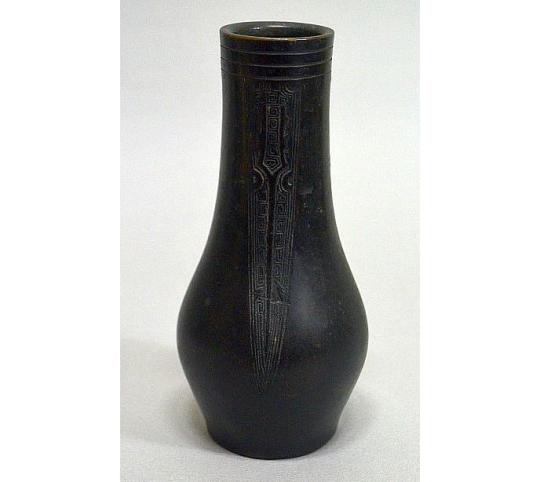
Two kinds of momo-jiri shaku-tate are known from the time of Ashikaga Yoshimasa: one with bas relief decoration (shown above), and one without decoration (i.e., “mu-mon” [無紋], like the mizusashi)*. It is not known which of them Rikyū owned.
__________
*These pieces were originally made in pairs, for use as flower vases that were placed on the family altar. As this was something that almost every Chinese family had in the main sitting room of their house, both sorts of momo-jiri were easily available on the continent.
¹⁴Kuchi-boso [口細].
This was Rikyū's narrow-mouthed mizu-koboshi.
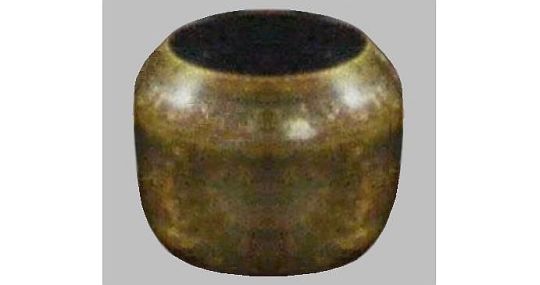
¹⁵Guru-guru [クル〰].
This was a ceramic ya-gaku [夜學] futaoki, probably of dark green ceramic (rather than the celadon shown in the photo).

The name suggests that the piece was etched with a stylus to look as if string had been coiled around it (before the openings were cut out). It has not been identified.
¹⁶Fukusa [服サ].
This was an ordinary temae-fukusa [手前袱紗]*. The fukusa, whatever its size, was folded in half, and then it was folded into thirds, as shown below†.

The fukusa was then knotted around the left leg of the daisu‡.
__________
*That said, it is actually not known what sort of cloth Rikyū used for his fukusa. Jōō and the chajin of his generation used Chinese donsu, of a size determined by the native width of the cloth from which it was made (people bought an entire roll of cloth, and made fukusa by cutting a length that was twice the width, which, when stitched, resulted in a not-quite-square wiping cloth); while Furuta Sōshitsu (and the tea men who came after him) used Japanese silk that was dyed dark purple. While this fukusa was copied from the small furoshiki that Rikyū used to wrap natsume of gift tea (and was identical to these in both size and color), it is unclear whether Rikyū eventually imitated Oribe's lead by using these cloths as temae-fukusa or not -- since surviving reports are contradictory, and should be considered propaganda intended to support the Edo period conventions espoused by the Sen families rather than historically accurate information.
The fukusa was (and, even in the present, should be) used for only one temae, and then discarded. And since it was a personal item, apparently none of Rikyū's ended up in any of his admirers' hands, and so none have survived.
†As always, the wasa [輪差] (the folded edge) is on the right, and the fukusa is folded in half away from you. Then the right hand slides from the upper corner to the lower one, so the wasa is in front, and at the top. Then the fukusa is folded in thirds, starting from the top (like a chakin).
‡The fukusa is held horizontally behind the leg of the daisu (with two folds at the bottom), and the knot is tied in front.
¹⁷Kō-bon ni [香盆ニ].
A “kō-bon” [香盆] could be any sort of tray that was large enough for the incense burner, kōgō, and (in this case) kyōji-tate [香筋建]* to fit on comfortably. In the present day small naga-bon (which does not conform with the dimensions of any of the classical trays described in the Nampō Roku) seem to be preferred by the modern schools, but in the classical period, square and round trays were used as well.
__________
*The kyōji-tate [香筋建] (it can also be written kyōji-tate [香箸立] -- though this form was considered rather inelegant) is like a miniature shaku-tate, in which the implements necessary for burning kyara [伽羅] incense in a hand-held censer are stood.
While the list may be abbreviated (and in the context of chanoyu, almost always is), the full set consist of:
- gin-yō-basami [銀葉挾] (a pair of pincers with flat heads that are used to handle the gin-yō [銀葉] -- mica squares on which the incense rests while being burned);
- kō-saji [香匙] (a sort of spoon used to scoop up the pieces of kyara when transferring them from the chopping block to the kōgō: incense wood is split into small pieces using a razor-sharp steel chisel, and the pieces are then handled with a special spoon in order to avoid contamination by the oils in the human hand);
- kyōji [香筋] (ebony chopsticks used to move one piece of kyara from the kōgō onto the gin-yō, in the kōro);
- an object called an uguisu [鶯], or uguisu-kushi [鶯串] (a flat platform, often shaped like a plum blossom, through which a long toothpick-shaped needle is poked: the uguisu is used to create a flat top to the mound of ash in the kōro where the gin-yō will rest; and, simultaneously, a chimney through which the heat from the charcoal rises upward: the name comes from the fact that the uguisu [鶯] feeds on the pollen of the plum blossom, hence the platform is shaped like a plum blossom, while the needle poking through suggests the bird's beak penetrating deep into the flower);
- koji [火筋] (metal chopsticks used to handle the burning tadon [炭團] -- the little briquettes made of processed charcoal that were used to heat the kōro);
- hai-oshi [灰押] (an object, shaped like a closed folding-fan, that is used to press the ash in the kōro into a conical shape after the burning charcoal has been put inside);
- and a miniature habōki [羽箒] (a feather duster used to clean the rim of the kōro after the ashes have been shaped).
¹⁸Kōro Usu-gumo [香爐 薄雲].
Usu-gumo [薄雲] is the name of a famous variety of kyara incense wood (not a kōro). Tanaka Senshō's manuscript (which was the document copied by Jitsuzan with the Shū-un-an papers before him) reads kō-bon ni kōro ・ usu-gumo mei-kō ・ kōgō futae aogai [香盆ニ香爐 ・ 薄雲 名香 ・ 香合 二重青貝], suggesting that Tachibana Jitsuzan made a mistake when transferring this information from his original notes to the notebook that he intended to present to the Enkaku-ji*.
As for the kōro itself, since Rikyū does not give a name, it was probably not the celadon Chidori kōro [千鳥香爐] that had been one of Jōō's treasures. Most likely, it was the ido-kōro [井戸香爐], that is shown below.

This kōro is now known as Kono-yo [此世], the name he wrote on its box (and presumably gave to it) just before his death.
__________
*While Shibayama Fugen states that Usu-gumo [薄雲] is the name of the kōro, it must be remembered that Fugen was relying on a set of notes set down by one of the auditors during the discussion of the Enkaku-ji manuscript that took place after Tachibana Jitsuzan had presented his text to that temple. In order to preserve the secrecy of the text, it appears that it was forbidden for the participants to write anything down while they were in the Enkaku-ji. Thus, this document was set down only after the person had returned to his home. (As such, it is rather remarkable that, on the whole, the text is exactly the same as the Enkaku-ji version. Copies taken from this manuscript circulated around Kyōto for many years, until the authentic Enkaku-ji version was finally published in the middle of the 20th century, and I have had the chance to inspected several of these copies on different occasions.)
¹⁹Kōgō futae ao-gai [香合 二重青貝].
Ao-gai [青貝]* is mother-of-pearl inlay.
Most surviving ao-gai kōgō from Rikyū's period are of the usual sort. A much smaller number have three levels (mie-kōgō [三重香合]). Kōgō with two levels (futae-kōgō [二重香合]) are all but unknown today, since they do not meet the modern demands as established by the tea schools†.
__________
*More commonly known as raden [螺鈿] today.
†A kōgō with two levels usually held the incense (enclosed within small envelopes) in the upper level, and a supply of gin-yō [銀葉] in the lower. Burned out incense pieces (which were fused to the gin-yō on which they were heated) were discarded into a separate taki-gara-ire [炷空入] -- often the kind of container used as a ceramic kōgō today.
A three-level kōgō includes a silver-, pewter-, or copper-lined lower level into which the burned-out incense is discarded.
It appears that Rikyū intended that the kōro be placed in the toko after the guests had finished appreciating the incense, so that it would continue to perfume the room during the remainder of the chakai. In fact, it may have been to suggest this intention that he did not arrange a taki-gara-ire on the kō-bon -- as would have been customary.
²⁰Kyōji-tate [キヤウシ立].
This is a vase-like object, usually made of metal, in which the implements used when preparing the kōro* are kept when not in use.
___________
*See footnote 17 for a complete listing of these things, including a description of their purposes. Rikyū probably abbreviated the number of things, since some of their functions could be performed by the utensils used during the sumi-temae (the regular ro-yō hibashi, for example, would have been used to transfer the burning tadon from the ro to the kōro; and the large habōki to dust the rim of the kōro).
²¹Habōki [羽帚].
This was an ordinary habōki, made from feathers around 1-shaku in length.

While it is not possible to know what kind of feathers were used, it was the season when the geese were flying north, and so these birds would have been taken from time to time by Hideyoshi's hawkers, with the feathers available to Rikyū for his purposes.
²²Kōro mawarite issumi ari [香爐マハリテ一炭アリ].
In other words, the tadon [炭團] (a small briquette of high-quality processed charcoal that is used to heat the kōro) were placed in the ro just before the guests entered the room for the shoza*, so Rikyū began the gathering by inviting the guests to appreciate incense, then prepared the kōro and offered it to them.
After they were finished, the kōro was placed in the tokonoma (probably by Rikyū)†, and Rikyū turned his attention to the ro. Because, according to san-tan san-ro [三炭三爐] practice, the fire in the ro should be rebuilt at midday (after having been laid at dawn), the charcoal would have burned down to mostly hot embers by this time‡, thus Rikyū would have added a more or less full set of charcoal, as he notes (rather than the several pieces added during the sumi-temae at a morning or evening gathering**). His use of the term issumi [一炭] implies that Rikyū had not replenished the fire prior to the arrival of his guests.
__________
*The use of the small tsuri-gama would have helped facilitate the insertion and removal of the tadon without having to take the kama out of the ro first.
When a large ro-gama was used, Jōō said that the gotoku should be moved diagonally toward the far left corner when the ro was set up, thus leaving more space in the front right corner for the host to reach in (with the ro-yō hibashi) to remove the tadon. (The koji [火筋] would never have been long enough to reach the tadon kindling deep in the ro.)
†The piece of kyara would not have been anywhere near exhausted by the time that the two guests finished passing it back and forth three times -- one piece of kyara (about 5-bu square) was intended to last long enough for five or six (or even up to ten) people to appreciate it three times each before its fragrance began to disappear. Therefore, to remove the kōro from the room would have been wasteful. The fact that Rikyū did not prepare a taki-gara-ire [炷空入] suggests that the idea of placing the kōro in the toko was planned beforehand (and the kane-wari for the goza also bears this out -- since the kōro was left in the toko until the end of the chakai).

Rikyū would have gone out to the katte and brought a small tray of some sort into the room that would serve as a base for the kōro when it was lifted into the toko. It would have been placed between the bon-san and the toko-bashira, forward of the midline of the toko, and associated with a yang-kane, as shown in the sketch.
‡Dawn occurs around 5:08 on April 10 in this part of Japan. Thus, the fire in the ro would have been burning for at least seven hours when this chakai began. The charcoal would have been reduced to ash-covered mounds (referred to as shira-zumi [白炭] by Jōō in the Hundred Poems), with perhaps only the large dō-sumi [胴炭] still partially intact. The dō-sumi would have been broken in half with the hibashi and moved to the middle of the ro, with the remaining embers (knocked free of their white ash coating) piled around it, after which shimeshi-bai would have been sprinkled over the white ash to make the ro look tidy. Then the wa-dō would have been placed on the right side of the pile of embers, toward the right-front corner of the ro, and then gitchō and wari-gitchō were added in a circle around the embers. This was how Rikyū arranged the charcoal.
During the ro season, the white eda-zumi [枝炭] -- carbonized azalea twigs coated with gesso -- were not used by Rikyū. These were used only during the furo season (if they were used at all by him), when laying the fire around a shita-bi of three burning gitchō. It is completely wrong to call the eda-zumi “shira-zumi” [白炭], and this mistake has lead to much confusion over the meaning of several of Jōō's verses in the Hundred Poems.
**The fire was added to the ro at dawn, so by the time of a morning gathering, the fire would still be fairly strong, with much of the charcoal still unburnt.
Likewise, the ro was emptied, cleaned, and a new fire was laid at dusk. Thus, when an evening chakai was scheduled, the fire would still be fairly strong, necessitating the addition of only a little charcoal to bring the kama back to a boil and keep it boiling until the service of usucha was concluded.
In the case of this chakai, however, the fire in the ro when the guests entered would have been the one laid at dawn (and, since a morning chakai had not preceded this one, the charcoal would have mostly burned down by this time). Consequently, the sumi-temae started with the collection of the burning embers into the middle of the ro, followed by the addition of a wa-dō [輪胴] -- the large circular piece cut from the thickest end of the long piece of charcoal as received from the charcoal shop -- which had to be retrieved from the bottom of the sumi-tori (unlike now, Rikyū placed the large pieces on the bottom and then piled gitchō and wari-gitchō on top to fill the sumi-tori; meaning that a number of these smaller pieces had to be moved into the haiki before the large piece on the bottom could be accessed, and the rest of the sumi-temae took place using the smaller pieces from the haiki) as the foundation for the new fire. Then a number of gitchō and wari-gitchō were used to encircle the embers. The arrangement, therefore, was much simpler than what evolved during the Edo period; but the very lack of strict rules meant that it also required careful thought on the part of the host -- so that he would add enough charcoal, yet not too much.
The elaborate sets of charcoal of different sizes and shapes concocted by the various tea schools during the Edo period were intended to make the task of building the fire as easy as possible -- so that even an incompetent host (someone with no real interest in chanoyu, for example) could manage to get the kama boiling without too much difficulty. And the go-sumi-temae [後炭手前], performed between the koicha-temae and the usucha-temae, meant that he did not have to worry that the kama would stop boiling before the service of tea was finished.
²³Sakemono jū-jū [サケ物重〻].
Both Tanaka Senshō and Shibayama Fugen have Sagemono-jū ni [サゲ物重ニ = 提げ 物 重 ニ] for this entry. A sagemono-jū [提げ 物 重] -- or sage-jūbako [提げ重箱] -- is a set of multi-tiered food boxes that can be carried by hand (such as to a picnic -- the purpose for which such sets of boxes were originally created). The particle ni [ニ], of course, means “in.” That is, the kashi enumerated below were all arranged in a stacked set of boxes, from which the guests were free to help themselves.
²⁴Yomogi no mochi [ヨモキノモチ].
This was mochi (steamed rice-cake) made with yomogi [艾] (mugwort, Artemisia princeps), which makes the mochi dark green and gives it an herbal flavor and smell. Yomogi-mochi were traditionally served on the Third Day of the Third Month.
In the old days, large sheets or cakes of mochi made with yomogi were cut into small pieces and simply served in that way. By the Edo period, mochi dough was wrapped around a ball of sweetened anko [餡子] made from the red azuki [小豆] bean. It is not known which sort of yomogi-mochi Rikyū offered to his guests during this chakai.
²⁵Nimono tori ・ kushi-awabi ・ shiitake ・ mame ・ musubi-me [煮物 鳥 ・ 串アハヒ ・ 椎茸 ・ マメ ・ ムスヒメ].
These “kashi” were all cooked by boiling in broth (nimono [煮物]). However, they would have been drained (and probably allowed to cool off) before being put into the box. These offerings consisted of:
- tori [鳥]: probably small birds (such as sparrows or finches), mashed into a paste and formed into dango [團子] (meatballs) that were threaded on a skewers in threes and so boiled;
- kushi-awabi [串鮑]: abalone that had been dried on skewers, rehydrated by boiling in broth, and then sliced;
- shiitake [椎茸]: probably dried shiitake mushrooms that were boiled in the broth after having been soaked in water overnight (the drying process makes them sweeter and more flavorful, and so better for boiling than the fresh mushrooms);
- mame [豆]: probably the large, white ōfuku-mame [大福豆], an especially large variety of the common ingen-mame [隠元豆] type of beans;
- musubi-me [結び芽]: wakame [ワカメ = 若芽] (a type of green seaweed, Undaria pinnatifida, that resembles a small size kelp), cut into short lengths that were then tied into decorative knots.
²⁶Mizu-kuri [水栗].
Raw chestnuts that have had part of the brown pellicle carved away with a knife, then soaked in water for several hours to remove the bitterness from the remaining pellicle before serving.
According to Tanaka Sensho, the pellicle was scratched away from half of the chestnut in a coma shape, resulting in a three dimensional futatsu-tomoe [二つ巴] design (the “yin-yang symbol”).
²⁷Go [後].
The go-za.
In terms of kane-wari:
- the toko, which now contains the scroll, the bon-san, and the kōro, would be han [半];
- the room remained han [半], since all it contained was the kama in the ro;

- and the daisu was also han [半]*.
Han + han + han is han. This is correct for the goza of a chakai held during the daytime.
___________
*The ji-ita remained han, and the ten-ita, with the sasa-mimi and a naka-bon bearing the kasane-chawan and a natsume, would have been chō. Han + chō is han.
²⁸Chaire sasa-mimi [茶入 サヽ耳].
The sasa-mimi [笹耳]* is a rather exaggeratedly etiolated chaire, originally made as a vessel for perfumed beauty-oil (the shape allowed it to be poured out without splashing); the pair of ears were there so that a cord could be tied onto one, crossed over several times as it passed over the stopper, and then tied onto the other ear to secure the lid and prevent spillage. Chinese sasa-mimi containers came in several different colors, with brown (as seen below) and egg-shell-white being most common.
Rikyū has marked this chaire with a red dot, indicating that it was one of the featured utensils -- probably as a nod to the fact that it was the Hina-matsuri.
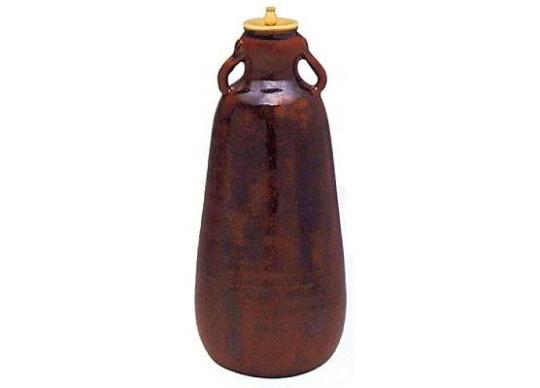
Though described first, the tea in the sasa-mimi was used to serve usucha. Therefore, though the sasa-mimi was usually provided with a shifuku, the shifuku was removed and placed flat on the daisu on this occasion (to protect the lacquer of the ten-ita from being scratched by the foot of the chaire) with the sasa-mimi standing on top of it.
___________
*Sasa-mimi [笹耳] means “ears shaped like the leaves of the bamboo-grass.”
²⁹Naka-bon ni [中盆ニ].
This could have been either be a square tray or a round one.
³⁰Natsume ・ kasane-chawan ・ ori-tame [ナツメ ・ カサネ茶碗 ・ 折タメ].
The natsume (probably a ko-natsume [小棗], since there were only two guests) contained tea for the koicha*.

It is not possible to guess which chawan Rikyū used on this occasion†, though the chakin, chasen, and chashaku (shown below) would have been arranged in the upper of the two bowls.
The chashaku was one of Rikyū’s ori-tame, and example being shown below.

As for how the chashaku may have been displayed, there are two possibilities:
1) it may have been placed across the rim of the smaller chawan, as shown in the left sketch;

2) or, it may have been placed on the tray, with the handle resting on the front rim, between the kasane-chawan and the natsume, as shown on the right‡.
___________
*The tea in the container displayed on the tray was considered to rank above that in the container that was not placed on a tray.
†The word kasane-chawan [カサネ茶碗] appears several times in the Nampō Roku, but the particular chawan used by Rikyū for this purpose, or their sizes, are not discussed.
Somewhat later he used a pair of black Raku-chawan (known as o-guro [オグロ, 小黒], “small black,” and ō-guro [オーグロ, 大黒], “large black” – the smaller bowl, which still exists, is around 3-sun 8-bu in diameter; while the larger, which has disappeared, was a little over 4-sun in diameter) as his kasane-chawan; but at the time of this chakai Chōjirō does not seem to have started producing his black bowls yet. (They first appeared during the summer -- according to a questionable entry in this kaiki -- or early autumn of 1587, perhaps making a sort of debut to the tea world at the Kitano ō-cha-no-e [北野大茶會], which opened on the First Day of the Tenth Month of that year.) . As mentioned above, only the smaller bowl survives now, and somehow it has acquired the name of the larger of the pair.
In the sketch I suggested one of the ido bowls as the larger chawan, with an aka-chawan as the smaller, but this is pure speculation.
1 note
·
View note
Text
Us, April 8
Cover: Jennifer Lawrence Quits Hollywood for Love

Page 2: Red Carpet -- Black and White -- Candice Swanepoel, Charlize Theron, Viola Davis, Angela Sarafyan, Leighton Meester
Page 3: Julia Roberts, Sandra Oh, Nicole Kidman, Rosamund Pike, Amber Heard
Page 4: Who Wore It Best? Ellie Goulding vs. Jasmine Sanders, Lili Reinhart vs. Sara Foster, Angelina Jolie vs. Gal Gadot
Page 6: Lily James vs. Leslie Grossman, Sonequa Martin-Green vs. Paloma Faith, Bella Hadid vs. Halsey
Page 8: Alicia Silverstone vs. Kimberly Schlapman vs. Liza Koshy
Page 10: Loose Talk -- Kelly Ripa responding to her daughter, Winston Duke on how his mom keeps him grounded, Mandy Moore on Queer Eye’s Karamo Brown, Lin-Manual Miranda on watching Hamilton with Prince Harry, Kate Beckinsale on her cat
Page 13: Contents

Page 14: Hot Pics -- Nickelodeon Kids’ Choice Awards -- Fuller House stars Candace Cameron Bure and Andrea Barber and Jodie Sweetin showed their support for Lori Loughlin, Chris Pratt got slimed
Page 15: Will Smith, Heidi and Spencer Pratt and son Gunner, Janelle Monae, Jennifer Hudson, Lana Condor and Noah Centineo
Page 16: Nick Jonas and Joe Jonas and Kevin Jonas and Priyanka Chopra Jonas and Sophie Turner in Miami
Page 19: Prince Charles and Duchess Camilla, Taylor Kinney and Wilder Valderrama, Becca Kufrin and Caroline Lunny and Tia Booth and Garrett Yrigoyen
Page 20: Ariana Grande, Serena Williams and Roger Federer, Dolly Parton
Page 22: Lupita Nyong’o and Evan Alex and Shahadi Wright Joseph and Winston Duke and Jordan Peele at the premiere of Us, Amy Poehler, Machine Gun Kelly and Tommy Lee at the premiere of The Dirt
Page 24: 10 Things I Hate About You on it’s 20th anniversary -- Heath Ledger, Joseph Gordon-Levitt, Gabrielle Union, Larisa Oleynik
Page 25: Julia Stiles, Allison Janney, Andrew Keegan, David Krumholtz, Susan May Pratt
Page 26: Highlighter-colored chic -- Ashley Graham, Jordyn Woods, Chanel Iman, Kendall Jenner
Page 27: Sailor Brinkley-Cook, Tinashe, Blake Lively, Bella Hadid, Dorit Kemsley
Page 30: Stars They’re Just Like Us -- Fergie, Dwayne Wade and Gabrielle Union, Jamie Chung
Page 31: Bella Thorne, Ron Howard, Katherine Schwarzenegger, Natalie Portman
Page 32: Furry Friends -- Martha Stewart and dog Han, Colton Underwood and cat Maverick, Andy Cohen and dog Wacha, Isla Fisher and her dog Busta, Halle Berry and dog Jackson -- Please adopt, don’t shop
Page 34: Hollywood Moms -- Brooklyn Decker on being a mom to two kids with Andy Roddick
Page 35: Chrissy Teigen and John Legend are gearing up for their daughter Luna’s third birthday, Edie Falco’s kids are run-of-the-mill preteens, Morena Baccarin tries to be a good role model to her daughter
Page 36: Love Lives -- Miley Cyrus’ brother Trace thinks Liam Hemsworth is awesome

Page 37: Justin Verlander knows he scored big when we won over Kate Upton, Karamo Brown planning his wedding to Ian Jordan to be like Priyanka Chopra and Nick Jonas, Dylan Sprouse couldn’t be prouder that girlfriend Barbara Palvin just earned her Victoria’s Secret wings
Page 38: Hot Hollywood -- Ben Affleck and Lindsay Shookus going strong
Page 39: Felicity Huffman and William H. Macy on the rocks over the college admissions scandal, Lori Loughlin’s daughters are upset with her and husband Mossimo Giannulli for the fallout of the college admissions scandal especially Olivia Jade who has lost endorsement deals, Melanie “Mel B” Brown admits she hooked up with fellow Spice Girl Geri Halliwell
Page 40: Christina Anstead expecting a baby with husband Ant Anstead in September, Paris Hilton dating British comedian Jack Whitehall, stars who have gotten into the wine business -- Sarah Jessica Parker, the Vanderpump gals, Ayesha Curry, Jon Bon Jovi, Kurt Russell
Page 41: Jessica Simpson’s third baby Birdie, VIP Scene -- Don Lemon and Debi Mazar, James Franco, Owen Wilson, Alex Rodriguez, Michelle Williams, Rami Malek, Elle Fanning, John Stamos
Page 42: What’s in My Bag? Sofia Carson
Page 43: Jenny McCarthy was miserable on The View, Jameela Jamil claps back at body shamers and bullies like Khloe Kardashian, Piers Morgan, Cardi B, Kim Kardashian, Quentin Tarantino
Page 44: Cover Story -- How Jennifer Lawrence finally found happiness
Page 47: Other stars who left Hollywood -- Phoebe Cates, Jonathan Taylor Thomas, Mischa Barton, Leelee Sobieski, Taylor Momsen, Jack Gleeson, Cameron Diaz
Page 48: Amanda Stanton and Bobby Jacobs happily ever after
Page 50: She’s headed toward age 50 but Jennifer Lopez has never looked better
Page 54: The Wellness Hacks of Other Ageless Stars -- Jennifer Garner, Padma Lakshmi, Diane Kruger, Elizabeth Hurley, Angela Bassett, Jennifer Aniston, Heidi Klum
Page 56: Hot Couple Alert -- Lady Gaga and Jeremy Renner
Page 60: Style -- Timepieces -- Kate Upton
Page 61: Mandy Moore
Page 62: Beauty -- Rosie Huntington-Whiteley, Joan Smalls, Ashley Benson
Page 63: Beyonce, Kat Graham, Karlie Kloss
Page 65: AJ McLean’s Hot Tracks
Page 66: Lorraine Toussaint on The Village
Page 67: Chase and Savannah Chrisley on their spinoff Growing Up Chrisley, Buzzzz-o-Meter -- Lea Michele, Taylor Swift, Paris Hilton
Page 70: Fashion Police -- Poppy, Carson Kressley, Betty Who
Page 71: Shania Twain, Ta’rhonda Jones, Keira Knightley
Page 72: 25 Things You Don’t Know About Me -- Luann de Lesseps
2 notes
·
View notes
Text
The NYC Hit List The Best New Restaurants In NYC added to Google Docs
The NYC Hit List The Best New Restaurants In NYC
Wondering where you should be eating in New York City right now? You’re in the right place. The Infatuation Hit List is your guide to the city’s best new restaurants.
And when we say “best new restaurants,” we mean it. Because we’ve tried every single one of these places - and we’ve also left off countless spots that simply aren’t as worthy of your time and money.
The Hit List is our record of every restaurant that’s opened in the past year that we’d highly recommend you try. This guide is sorted chronologically, so at the top you’ll find our latest entries to this list (the newest spots), and as you keep scrolling you’ll find the places that are on the older side - but are great enough that we still haven’t stopped talking about them.
New to The NYC Hit List (as of 2/19/20): Quality Bistro, Jua, Peoples Wine
Some spots you might have heard about that didn’t make the cut: American Bar, 232 Bleecker, Būmu, Torien, Nowon, Portale, Leo, Il Fiorista, and Gotham Bar And Grill
And for more in-depth guides to the best new Brooklyn or Uptown spots, check out the Brooklyn Hit List and the Uptown Hit List.
The Spots Quality Bistro $$$$ 120 W 55th St
Quality Bistro is a massive French restaurant in Midtown that has about as much gold detailing as the Salon of Venus at Versailles. The 400-bottle French wine list and the four filet mignon options might make it sound like a place to send in-laws before 6pm tickets for Chicago, but this place - from the people behind Don Angie, Quality Meats, and about 10 other popular spots - isn’t stuffy. There’s a casual bar area that gets packed with after-work crowds, and dining rooms that are louder and darker than your typical spin class. Share big portions of excellent French-leaning food with a date who you want to impress, or clients who purposefully didn’t book early flights tomorrow.
Peoples Wine $ $ $ $ Wine Bar in Lower East Side $$$$ 115 Delancey St
We’re currently more impressed with Peoples Wine than we are with any candidate running for president or the poodle who won the Westminster Dog Show. The first reason being, this bar from the Contra and Wildair team serves great snacks as well as natural wine you either haven’t heard of or you already love. And the second is that Peoples has somehow created a space where you’ll want to spend multiple hours, despite the fact that it’s located in the basement of a LES food hall.
Dan Ahn Jua $$$$ 36 E 22nd St
Jua is from the group behind Atomix and one of our all-time Greatest Hits, Her Name Is Han. What we’re trying to say is, we can’t remember the last time we were so excited to go to Flatiron. This Korean restaurant’s space falls somewhere between special-occasion Atomix and group-friendly Her Name Is Han, but with food that has something in common with both - we’re still thinking about it long after leaving. Dinner starts with deep-fried seaweed wrapped around uni and a ton of caviar, and the next eight dishes on the $95 tasting menu, including a bunch of things cooked on the wood-fired grill, are just as memorable. While you can order a la carte, you should come here for the two-hour set menu and share a bottle of natural wine with a date.
Verōnika $ $ $ $ European in Flatiron , Gramercy $$$$ 281 Park Ave S Not
Rated
Yet
If there were an Oscars ceremony for restaurants, we’d feel comfortable nominating Verōnika for several categories, like Best Borscht, and Best Impression Of a 19th-Century Aristocrat’s Clubhouse. Even if Verōnika’s Eastern European food weren’t elegant and delicious (it is), the room alone could make your night - from portraits of powerful women on the walls and little Bauhaus-style lamps on every table, to ceilings so high it’s almost inappropriate not to have a firehouse pole. Verōnika is unquestionably formal, but after a few visits, the food is what stands out here compared to other special occasion spots in the city. You’ll find Eastern European classics, like porky borscht, lamb goulash with nicely chewy spätzle, as well as black cod dish with a lemony beurre blanc sauce that will be memorialized in our hearts and minds for years to come.
Chikarashi Isso Chikarashi Isso $ $ $ $ Japanese in Financial District $$$$ 38 Rector St Not
Rated
Yet
Like Richie and Chas Tenenbaum, you wouldn’t know Chikarashi and Chikarashi Isso were related if it weren’t for the name. Whereas Chikarashi draws long lunch lines for fast-casual poke bowls, Chikarashi Isso is a high-end Japanese restaurant in FiDi where you’ll find wagyu with caviar and wok lobster with soft shell shrimp. And despite a diverse menu with tempura, yakitori, and soba, each of these dishes could pass as the restaurant’s specialty. That’s especially the case with the yakitori, and it’s why the chef’s selection of six delicious skewers of chicken and vegetables needs to be on your table. Come here for a laidback business meal the next time you’re near the Stock Exchange.
Itay Paz Zizi $ $ $ $ Middle Eastern in Chelsea $$$$ 182 8th Ave Not
Rated
Yet
The first law of thermodynamics states that energy cannot be created or destroyed, but that it can change forms and locations. While we never understood it in high school, we think we get it now after eating at ZiZi. What Williamsburg lost when Zizi Limona (a utility spot that worked for everything from group brunch to dinner with parents) closed in September, Chelsea gained when ZiZi opened there a month later. The menu at this casual Middle-Eastern spot is almost identical, including a fantastic shawarma plate with juicy chicken and lamb over creamy hummus, and the space even looks similar, with lots of exposed brick, a small bar lined with wine bottles, and a couple of tables on the sidewalk outside.
Melissa Hom Piggyback $ $ $ $ Thai , Filipino in Chelsea , Koreatown $$$$ 140 W 30th St Not
Rated
Yet
People are constantly asking us where they can sit down and grab a dinner that won’t make them sad around Penn Station. Koreatown has a bunch of great spots, and Farida is only about six blocks away - but Piggyback is now the best option within several hundred feet. It’s from the same people behind Pig and Khao, and the menu is a mix of mostly Southeast Asian things like lumpia, Thai fried rice, and a big bowl of crudo with grapefruit, cashews, and crunchy strips of pork. We especially like the flaky curry puffs stuffed with a very large handful of heavily-spiced beef, and we suggest you stop by the next time you find yourself around 30th street to get them. Bring a few friends. It’s a fun spot with loud music and murals on the walls, and they make some solid cocktails.
Tyson Greenwood Kindred $ $ $ $ Pasta , Mediterranean , Wine Bar in East Village $$$$ 342 E 6th St Not
Rated
Yet
Ruffian is one of our favorite wine bars in NYC, and the only reason we hesitate to recommend it to everyone is the fact that the 19-seat space tends to fill up before most people get out of work. But you don’t need to run the risk of a two-hour wait for excellent Mediterranean food and natural wines in the East Village anymore because Kindred, which is from the same people, opened around the corner. The small bar area up front is great for small plates and Happy Hour drinks, but unlike Ruffian, there’s also a full dining room. Come here with a date, and share some Slovenian orange wine and housemade pasta.
Rachel Vanni Ernesto's $ $ $ $ Spanish , French in Lower East Side $$$$ 259 E Broadway Not
Rated
Yet
Ernesto’s is the new restaurant we’re getting asked about the most. It’s a Basque-inspired place that’s already packed with people eating pinxtos, sitting in leather chairs we’d like to own, surrounded by red brick and gold fixtures and globe lights. On a first visit, we weren’t blown away by the food - with the exception of a tower of housemade potato chips and iberico ham - but the restaurant experience made up for it. It’s a place where you want to hang for a while, or as long as the sommelier/wine whisperer keeps suggesting different half-glasses of French and Spanish natural wines for you to try.
Noods n' Chill Noods n’ Chill $ $ $ $ Thai in Brooklyn , Williamsburg $$$$ 170 S 3rd St Not
Rated
Yet
Let’s get one thing out of the way: Noods n’ Chill is not a great name. It sounds like an upstate retreat with a lax dress code or a text you’d receive from an unsaved number at 12am. But none of that matters. Because Noods N’ Chill is where you’ll find the best Thai food in Williamsburg. This tiny counter-service spot is from the same people behind Look By Plant Love House (one of our favorite Thai restaurants in the city), and most things here cost less than $15. The guay tiao tom yum soup - with its spicy broth, tender fish balls, and abundant noodles - is an excellent choice, and you should go ahead and get a few pork buns to start your meal. Try this place for a casual weeknight dinner (that’s better than most) or stop by for brunch, when there’s stuff like kaya toast and porridge.
Marko Macpherson Bar Bête $ $ $ $ French in Carroll Gardens , Cobble Hill $$$$ 263 Smith St Not
Rated
Yet
Bar Bête is NYC’s latest restaurant serving roast chicken on marble tables beneath large hanging globe lights. But this trendy Cobble Hill spot has more to offer than the possibility of a Bon Appetit staff member sighting. It’s where you should absolutely have dinner with a date in the area. The simple reason being, they serve thoughtful and delicious French food (like a peekytoe crab omelette) that makes ordering the roast chicken seem about as inspiring as proposing to someone at a Yankees game. So don’t write it off as just another trendy roast chicken restaurant.
Noah Fecks Banty Rooster $ $ $ $ American in West Village $$$$ 24 Greenwich Ave Not
Rated
Yet
The Banty Rooster is a rare example of a West Village place that exceeded our expectations. At first glance, this casual American spot feels like countless other places in the area serving potato fritters and short rib. But then you’ll notice that the fritters are served with salt cod aioli and the short rib crumbles when you dip it in the side of ancho barbecue sauce. Between the food, big space, and affordable wine offerings, this place should be at the top of your list for your next group dinner in the West Village.
Melissa Hom Kochi $ $ $ $ Korean in Hell's Kitchen , Midtown $$$$ 652 10th Ave Not
Rated
Yet
We’ve long championed eating things on sticks. But while seven of the nine courses at Kochi are served on skewers, that’s not the reason we’re telling you to go. You should go to this Korean tasting menu spot in Hell’s Kitchen because everything from the raw scallops and fluke at the beginning of the meal to the black sesame ice cream pop at the end is delicious. You’ll leave feeling full, and considering the variety and quality of everything here (including bibimbap topped with tons of uni), the $75 price tag feels reasonable, especially while it’s still BYOB.
Liz Clayman Le Crocodile $ $ $ $ French in Brooklyn , Williamsburg $$$$ 80 Wythe Ave 8.2 /10
The restaurant space in the bottom of the Wythe Hotel has always been one of our favorites. It has huge windows, high ceilings, and brick walls that wouldn’t feel out of place in a rural castle from the fifteenth century. And now that Le Crocodile has moved in, we’d like to eat there every day. This French restaurant is from the people behind Chez Ma Tante in Greenpoint, and the menu is equal parts traditional and exciting. You’ll find escargots and steak tartare, for example, and it also has a pork chop covered in burrata and some roast chicken with several fistfuls of fries on the side. Order all of these things. And be sure to book a table before more people realize they should eat here.
Anton's $ $ $ $ American , Italian in West Village $$$$ 570 Hudson St 8.2 /10
Anton’s might have only just replaced Frankie’s 570 in the West Village, but it feels like this Italian restaurant has both been around forever and is here to stay. On our first visit a week into service, it was already running like a well-oiled machine, and almost everything we tried we’d want to eat again. With its dark wood, long bar, and ideal amount of candlelight, it’s the kind of place that makes you want to become a regular who has a standing martini and steak and/or pasta order. Speaking of which, the pastas are where we’d recommend you focus your order.
Flora Hanitijo Mina's $ $ $ $ Greek in Long Island City $$$$ 22-25 Jackson Ave Not
Rated
Yet
Not all museum restaurants are created equal. And Mina’s, the new Greek small plates spot in MoMA PS1, is proof. Unlike most museum cafeterias or upscale restaurants that feel like museums themselves, Mina’s is both casual and pleasant. The bright space is ideal for a brunch or snack involving things like a creamy muhammara, perfectly oily anchovies, and an excellent Greek egg and cheese boat peinirli. Take someone here who likes natural wine, Sally Rooney books, and the color seafoam. They’ll want to move in.
The Riddler The Riddler $ $ $ $ American , French , Raw Bar in West Village $$$$ 51 Bank St 8.1 /10
While we were drinking from a Chambong at The Riddler in the West Village, the couple at the table over stared at us, so transfixed by what they were seeing that they forgot they were holding shrimp cocktail in midair. Whether you want to have a classy evening involving raw bar and several glasses of Champagne, or debauchery by way of Chambong and glasses of wine filled to the literal brim, you’ll have a good time at this Champagne bar in the West Village. Just be sure to order the raclette burger and to make a reservation - the space is small and there’s very little room for walk-ins.
Zooba $ $ $ $ Middle Eastern , Egyptian in Nolita $$$$ 100 Kenmare St 8.5 /10
Zooba is a fast-casual restaurant in the same way that Bob Ross is a watercolor painter. It’s technically true, but there’s a lot more exciting context. This is the first US location of an Egyptian spot with several locations in Cairo, and it’s officially where you should be getting lunch or a quick dinner in the Soho area. The ceiling in here is covered with neon signs and it’s pretty difficult not to admire the flashing lights above you while you wait in line. But the food is more memorable than any of that. The specialty is the ta’ameya (fried balls made out of fava beans), which you can and should order spicy, but we also love the hawawshi beef patty sandwich with cheese. Most things come on a soft homemade Egyptian pita called baladi and everything costs under $15. If you work anywhere downtown - we suggest beelining here.
Nami Nori $ $ $ $ Sushi in West Village $$$$ 33 Carmine St 7.6 /10
Nami Nori feels like a tiny West Village boutique or a cinematic version of the afterlife. It’s a bright and attractive space on Carmine Street with two bars and just a handful of tables, and pretty much everything is either white, off-white, or a soothing shade of light brown. They specialize in hand rolls that are left open like tacos (instead of being cylindrical or cone-shaped). And of the 20 different kinds - like tuna poke with crispy shallots, lobster tempura with yuzu aioli, and a few classic varieties - the least-complicated ones are the best. For $28 you can get a chef’s selection of five rolls, and there are also a bunch of small plates like shishito peppers and miso clam soup, most of which cost less than $10. Start with one or two of those, get the chef’s selection, and you’ll have a very good and reasonably priced (for sushi) meal.
Noah Devereaux Sushi Jin $ $ $ $ Japanese , Sushi in Upper East Side $$$$ 316 E 84th St 8.1 /10
You’ll know you’ve reached Sushi Jin when you see a koi fish flag hanging outside of a brownstone on 84th Street on the UES. This is the most exciting new omakase place we’ve been to this year, especially because dinner here will involve an uni handroll and won’t cost more than $100. The $95 option comes with 12 pieces of fish (including that handroll) presented like a valuable collection of baseball cards - as well as soup, dessert, and green tea. Each piece of sushi - like sea eel from the Tokyo Bay, cherry sea bream, or seared Japanese barracuda - is thoughtfully dressed with dabs of sauce, yuzu zest, or tiny flakes of hard-boiled egg yolk.
Llama San $ $ $ $ Japanese , Peruvian in West Village $$$$ 359 Avenue of the Americas 8.5 /10
Llama San is the latest place from the people behind Llama Inn, a Peruvian restaurant in Williamsburg we’ve been recommending on repeat since it opened several years ago. But unlike Llama Inn, Llama San serves the type of Japanese-influenced Peruvian food known as Nikkei. There’s a plate of raw hamachi with matcha foam and tiny cubes of coconut, for example, as well as some Japanese eggplant with little mounds of fresh cheese and some bisected red grapes - and both of these dishes are bright, complex, and worth seeking out. We’re also fans of the space, which has a lot of blonde wood and ambient lighting, and we feel compelled to mention that we wanted to steal the plates and other ceramic dishware. So book a table, and bring a date or a friend who wants to have a special dinner. And don’t steal the plates.
Win Son Bakery $ $ $ $ Taiwanese in East Williamsburg $$$$ 164 Graham Ave 8.7 /10
The name Win Son Bakery is a little misleading. Because in addition to some excellent doughnuts and other baked goods, this counter-service spot from the Win Son people also serves a few salads and bunch of different sandwiches like a burger with raclette on a milk bun. They also have some crunchy fried chicken covered in a sweet and sour sauce, and it’s one of our favorite things here. However, we could easily just sit in a corner and eat some of Win Son Bakery’s plain scallion pancakes for an hour or two. That’s how much we like the food here. So grab a table in the bright, cafe-like space. It’s open for breakfast, lunch, and dinner, and it’s right across the street from Win Son in East Williamsburg.
Bread And Salt $ $ $ $ Pizza , Italian in Jersey City , New Jersey $$$$ 435 Palisade Ave 8.6 /10
If you’re hesitant to travel to Jersey City for a counter-service slice shop, know that we’d make the trip just for the crust. They don’t serve the light, charred crust on its own, though, and most of it comes with perfectly acidic and sweet tomato sauce, and/or mozzarella that’s pulled in-house. The slice variety changes every few minutes, so your choices are entirely dependent on whatever recently came out of the oven. But if you see them, prioritize the sausage and pepper or anchovy and green tomato slices, as well as the rossa and margherita. Since Bread And Salt is BYO, we suggest bringing some red wine, and hanging out for an hour or two so that you can order slice-after-slice without feeling like you’re missing out on whatever’s coming out of the oven.
Sorry—looks like you screwed up that email address
INFATUATION NEWSLETTER Get our newest guides & reviews first,
plus more restaurant intel you won't find anywhere else. ATL ATX BOS CHI LDN LA MIA NYC PHL SF SEA DC Subscribe Smart move. Excellent information will arrive in your inbox soon. Do you have friends and family who also eat food? Enter their emails below and we’ll make sure they’re eating well. (Don’t worry, we won’t subscribe them to our newsletter - they can do that themselves.) Help Your Friends No Thanks Well done. You’re a good person. All good. We still like you. Want to quickly find restaurants on the go? Download The Infatuation app. Maison Yaki $ $ $ $ Japanese , French in Brooklyn , Prospect Heights $$$$ 626 Vanderbilt Ave 8.3 /10
Maison Yaki, the second restaurant from the people behind Olmsted (across the street), is a place of miniatures. Instead of entrees, there are skewers. Instead of normal-sized cocktails, there are slightly shrunken ones. Even the wine and beer glasses make you look at your hands to make sure you haven’t suddenly become a giant. Luckily, the prices at this French-Japanese mashup are downsized too - nothing costs more than $9. The setup makes it easy for you to try a lot on the menu, without spending a crazy amount of money. And while you’ll eat things like duck à l’orange and lobster Americaine skewers, the whole experience feels fun and relaxed. If you’re in a restaurant rut, this is a great place to come and mix it up.
Nicole Franzen Wayla $ $ $ $ Thai in Lower East Side $$$$ 100 Forsyth St 8.6 /10
Like most animals on this planet, we enjoy eating outside - and that’s part of the reason why we like Wayla, a new Thai restaurant on the LES that has a backyard filled with potted plants, string lights, and some patio furniture that’s probably nicer than a lot of the stuff you choose to keep indoors. The food here also happens to be excellent, especially the pork sausage and fried branzino. But we’d be keeping secrets if we didn’t tell you to order the noodle-wrapped meatballs and the daily curry too. Bring a few people, so you don’t have to waste time trying to decide between all of these things.
Helen Lee Golden Diner $ $ $ $ Diner in Two Bridges $$$$ 123 Madison St 8.7 /10
It takes a lot for us to tell you to go out of your way for a diner. But we would advise you do so in the case of Golden Diner, a little spot underneath the Manhattan Bridge with big windows, yellow booths, and lace curtains. The short (for a diner, at least) menu here is what sets it apart - there’s a club sandwich stuffed with chicken katsu, an avocado toast topped with turmeric, thai basil, and galangal, and a bibimbap-style bowl of creamy barley covered in enough vegetables, fruits, and flowers to look and taste like a field that you definitely want to frolic through. Make your next lunch-outside-of-the-office plans here, or stop by for a great tuna melt or burger at night for dinner.
Chris Payne Crown Shy $ $ $ $ American in Financial District $$$$ 70 Pine St 9.1 /10
Crown Shy is one of a few new places (like Manhatta) that make us actually excited about getting dinner in FiDi. This new American spot off the lobby of a landmarked luxury apartment building has high ceilings and huge windows, and is perfect for clients or in-laws or anyone you generally want to convince that you have your sh*t together. The food - like hummus that comes with ’nduja and sugar-coated puffed bread, and crispy farro with bone marrow and chunks of oxtail - will also impress just about everyone. But while it’s certainly upscale, Crown Shy doesn’t feel stuffy - the walk-in-only bar area, as well as the open kitchen and surprisingly affordable prices (most dishes are under $20), make it the kind of spot you could go anytime you want to get a little dressed up for a nice night out.
via The Infatuation Feed https://www.theinfatuation.com/new-york/guides/best-new-new-york-restaurants-hit-list Nhà hàng Hương Sen chuyên buffet hải sản cao cấp✅ Tổ chức tiệc cưới✅ Hội nghị, hội thảo✅ Tiệc lưu động✅ Sự kiện mang tầm cỡ quốc gia 52 Phố Miếu Đầm, Mễ Trì, Nam Từ Liêm, Hà Nội http://huongsen.vn/ 0904988999 http://huongsen.vn/to-chuc-tiec-hoi-nghi/ https://trello.com/userhuongsen
Created February 20, 2020 at 01:08AM
/huong sen
View Google Doc Nhà hàng Hương Sen chuyên buffet hải sản cao cấp✅ Tổ chức tiệc cưới✅ Hội nghị, hội thảo✅ Tiệc lưu động✅ Sự kiện mang tầm cỡ quốc gia 52 Phố Miếu Đầm, Mễ Trì, Nam Từ Liêm, Hà Nội http://huongsen.vn/ 0904988999 http://huongsen.vn/to-chuc-tiec-hoi-nghi/ https://drive.google.com/drive/folders/1xa6sRugRZk4MDSyctcqusGYBv1lXYkrF
0 notes
Text
Seven signs you’re dating a softboi
Would you be able to tell? (Picture: Ella Byworth for Metro.co.uk)
He’s played you his Hans Zimmer playlist, told you he has not one but five poetry collections scribbled down in Moleskines, and takes photos on a 35mm Olympus Trip.
Ringing any bells? If so, you might be caught up with a softboi (or softboy).
The softboi is a relative of the well-known fuckboy, with a sprinkling more sensitivity thrown into the mix. Unlike the latter, the softboi acts like he cares about your feelings, but in reality he’ll ditch you as soon as he’s bored.
From alternative interests to emotional intensity, these are the telltale signs of a softboi.
He’s an outsider
Or so he tells you.
He doesn’t fit in with most crowds, he explains. Instead, he finds himself drifting into his own thoughts when groups are making conversation.
This ‘misunderstood’ charade is enough to tempt even the best of us into feeling sympathetic.
He avoids anything mainstream
This comes with his outsider complex. He has bizarre taste in films, music and books – in fact, you’ve never really heard of any of the things he recommends to you. Where does one even find Algerian jazz fusion?
This nicheness makes him intriguing and ‘different to other guys’. This all works in his favour in gaining your interest.
He has a superiority complex
That being said, having alternative interests doesn’t automatically make you a softboi, but thinking these interests make you superior to everyone else does.
No doubt he’s open about his emotions
Maybe he’s sent you song lyrics or a recording of a song he’s written for you on the banjo. What a sensitive guy.
Now, of course it’s important for men to be open about their feelings, in fact that’s encouraged (especially with the dangers of toxic masculinity). But the difference between a nice guy who is in touch with his feelings and a softboi, is that the latter will exploit this to work to their advantage.
Typically a softboi will seem more emotionally intelligent than any other guy you’ve ever dated, but he’ll be using it as a ploy for you to get close to him – so he can get what he wants from you and then scarper off.
If you hear the dreaded: ‘you’re so different to other girls,’ it’s likely you’re in trouble.
A softboi will seem more emotionally intelligent than any other guy you’ve ever dated (Picture: Ella Byworth)
He’s educated, and he wants you to know it
Keats, Hemingway, Woolfe – you name it, he’s read it.
Of course, being well-read is sexy, very sexy (especially if he can spontaneously quote Oscar Wilde passages). But a softboi thrives on intellectualism and loves nothing better than shoving his education in your face.
He’s also not at all interested in your thoughts or opinions on literature and philosophy.
He’s got a ‘good guy’ attitude
Of course he’s a feminist.
He just has so many feelings it makes perfect sense for him to be so passionate about gender equality and helping minorities. What a progressive guy.
His speeches are pretty convincing too, like the one about freeing the nipple and legalising drugs.
But the deception will soon become clear.
A few hookups will result in him eventually ghosting you, and you’ll be left wondering whatever happened to that ‘caring disposition’.
More: Showbiz
Does First Dates' maître d' Fred Sirieix have a wife or partner?
Homeless people's tents set on fire in city centre
Coronation Street reveals Christmas special
He’s convinced he discovered x, y and z
He tells you he was listening to Bon Iver back in 2006.
This obsession with finding things before they became popular is another way he feeds his ego.
Came up with the idea for environmentally-friendly paper straws? Sure you did, hon.
MORE: What is a softboy, and are you one?
MORE: Facebook launches first dating service to help you secretly find love
MORE: What are the benefits of having an orgasm?
0 notes
Text
Instagram vs. facebook: what’s the better marketing avenue?
When Facebook bought Instagram in 2012, were they preparing to train a successor?
Back then, the billion-dollar acquisition was a bold move, and many criticized Facebook for spending so much on a dinky photo app run by just 13 employees. No one questions the move now, however; although exact amounts are unknown, rough estimates put Instagram’s current value at around $102 billion, ten times the acquisition cost.
Is Instagram the new Facebook?
To be fair, Instagram can’t compete with Facebook on the sheer number of users. Instagram’s 800 million monthly users may have made it the third most popular social media channel, but it’s still a far cry from reigning-champion Facebook’s 2 billion monthly users. So why not invest all your digital marketing money in Facebook and reach twice as many people?
Because, as we explain below, it’s not about the quantity of impressions, it’s about the quality. And for digital brands targeting younger (< 30 y.o.) groups, your marketing dollars might go further on Instagram, especially for visual industries like fashion, beauty, or even architecture.
Later, we’ll explain how to shift your strategies to make the most out of marketing on both platforms. But first, let’s look at how a relatively smaller channel can make bigger waves. It’s all about their DNA, which for social media is another way to say, their algorithms.
Instagram vs. Facebook: the algorithms
—
Long story short, it’s not about your visibility per se, but more about your visibility with the right people.
Getting back to basics for a moment, the algorithm for a social media feed refers to the actual code that determines which posts are seen by which users, and in what order. Long gone are the days of chronological feeds where posts appear in the order they were published—and good riddance, frankly, considering this organization structure doesn’t scale well when you follow hundreds of accounts.
The seeming randomness of your social media feed makes strange partnerships, like Garry Shandling and the Pope. Via Facebook.
So, social media channels use algorithms to give you a more fulfilling experience, where you see more posts you actually like, and less of the irrelevant ones from your weird aunt. But don’t pat these channels on the back for their altruism—the algorithm also gives them more control over their advertising ventures.
As you can imagine, this isn’t an exact science, so each social media channel has to shoot in the dark a little when determining the right criteria on which to organize their feeds. Therein lies the difference between marketing on Facebook versus marketing on Instagram.
So what does Instagram’s algorithm do better for marketing? The actual algorithms are unknown trade secrets, but Alfred Lua of Buffer researched both the algorithms for Facebook and Instagram, and came up with some speculations that proved accurate when tested. These are the factors that determine a single (non-advertisement) post’s rank.
Instagram’s Algorithm
Engagement. How many hearts and comments on each post.
Relevancy. Are the post’s genres relevant to the user?
Relationships. Posts from accounts that the user interacts with more frequently are ranked higher.
Timeliness. More recent posts are ranked higher.
Profile searches. Posts from accounts that users search for regularly are ranked higher.
Direct shares. Posts from accounts the user directly shares with others are ranked higher, and the person who receives the shared posts gets a rank boost on their own posts.
Time spent on post. The time spent actually looking at a post (not scrolling).
Facebook’s new algorithm
Friends and family. Posts from people the user knows personally are ranked higher. This is important because it means posts from brands are demoted.
Engagement. How many likes, comments and shares the post receives, factoring in time.
Encouraging engagement. Posts likely to start to a conversation are ranked higher.
Images and videos. Visual posts are ranked higher and text-only posts are ranked lower.
Bait is demoted. Posts that aggressively bait for likes, shares, comments, votes or tags are ranked lower.
Promotional posts are demoted. Posts trying to push people into buying a product/service or join a contest are demoted. Also, Facebook checks text against known advertisements and demotes unofficial ads.
Promoting a product like the Han Solo Star Wars movie is easy when your fans do all the work. Via Instagram.
The goal of the update was to prevent fraudulent news stories by encouraging more personal conversations, but the consequence is less exposure to brands and public content.
It seems like a coordinated strategy with Facebook compartmentalizing its two channels. Minimizing third-party exposure on Facebook will return the channel to its more personal social roots with friends and family, while simultaneously drumming up business for its advertising (it’s not harder for brand posts to be seen for free). But social media marketers can still promote their brand on Instagram for free, and with even better results, as long as the content is sound.
Instagram vs. Facebook: marketing effectiveness
—
Now that we’ve looked behind the scenes, let’s look at what’s happening on the main stage.
To wrap a nice bow around it, Instagram is better for direct marketing: engaging with customers, spreading awareness, showcasing new products/services, comparison shopping, and influencer marketing. Furthermore, Instagram is a powerhouse for the under 30 demographic, especially teens.
Facebook, on the other hand, remains the best for visibility with older age groups, as long as you’re using paid advertisements. It’s also worth noting Facebook makes it easier to funnel users to a third-party site like an online store. Instagram prohibits link sharing in posts and comments, and any outside links appear in your bio only; the extra steps required to visit your site make it harder to generate traffic.
Food magazine Bon Appétit posts awesome cooking videos on Facebook. Who could resist clicking on that link to their website to get the recipe?
A lot of it boils down to the motives of each person using each site. In principle, Facebook tries to be more about personal interactions and sharing content with people you know. As such, 40% of Facebook users don’t like engaging with companies at all, preferring more intimate connections.
Instagram, though, places more emphasis on discovery and observation, and less on interaction—although ironically their engagement rate is much higher. Particularly for Millennials, Instagram is seen as a style resource, an ideal place for learning new trends and discovering new artists, as well as keeping up with their favorite celebrities. As you can see by the chart below, Instagram dominates industries like fashion, beauty, interior design, architecture, photography and celebrity news.
Instagram outperforms Facebook in visually-dominant industries. Via Facebook.
This makes Instagram better for influencer marketing and free exposure; users on Instagram more often sign on actively looking for product recommendations, as opposed to Facebook where they actively ignore them.
Instagram’s other advantage is customer engagement. A 2014 Forrester study put Facebook’s engagement rate at 0.7%, a huge lag behind Instagram’s 4.21%. A Selfstartr study brings more up-to-date statistics: Only 32% of Facebook users regularly interact with brands, compared to 68% of Instagram users. Their final tally cites that brands receive 58x more engagement per follower on Instagram than Facebook.
A lot of that has to do with Facebook followers not even seeing the posts in the first place, thanks to the algorithm. According to the above Selfstartr report, while Instragram brands reach 100% of their audience per post, that number drops drastically to 6% for Facebook.
Maybe it’s the mindset on users, or perhaps the limitations Facebook’s new algorithm puts on brands, or maybe it’s simply the culture of each channel. Regardless, Instagram is the winner for having an actual back-and-forth with customers.
And let’s not forget the presence of competition, or lack-there-of. The presence of marketers on Facebook is nearly 3x that of Instagram: 93% of marketers use Facebook, compared to only 36% using Instagram [Selfstartr again]. Perhaps that has to do with the brand fatigue felt on Facebook.
But perhaps the difference between marketing on Facebook vs. Instagram is best understand by looking at performance over time. Organic marketing on Facebook has declined by 63% since 2012, while it’s increased 115% on Instagram in that same time. It seems the writing has been on the wall even before Facebook’s latest algorithm changes.
7 best practices for switching your marketing focus
—
Enough statistics and observations. Let’s talk about what a brand can do to maximize the effect of Instagram marketing.
1. Don’t abandon facebook. With its reach and emphasis on sharing, Facebook is still relevant for marketers, so don’t abandon it completely. Facebook is a great place to post curated content and brand news, and their paid advertising is more effective than Instagram’s. But when it comes down to building a brand reputation and relationships with customers, Instagram is better.
2. Up the visual content. While visuals outperform text on both channels, on Instagram it’s downright necessary. Facebook may be more forgiving of text-based posts like blog articles or novella-length status updates, but with Instagram, if has to look great to perform great.
Power through the day with help from #FLEXVOLT. What job are you getting done this week? Photo Credit: @mike_builds_
A post shared by DEWALT POWER TOOLS (@dewalttough) on Jan 31, 2018 at 7:30am PST
3. Create original content. Again, posting or sharing other works is perfectly acceptable on Facebook, but with Instagram it’s assumed that images are original. Instagram is less a place for sharing the work of other people (unless it’s a picture you took yourself of another person’s work), so invest in strong, original content.
4. Go heavy on the hashtags. You can’t directly target user groups on Instagram, but hashtags are the next best thing. List all the relevant hashtags to help your post get seen by the right people. Up to 30 hashtags fit in the description, but you can always add more in a comment on your own post.
5. Create contests. Contests are always great for engagement spikes, so take advantage with an Instagram photo contest. Having users promote your brand in their pictures is free advertising, just don’t forget to create an original hashtag for the campaign. You also have the opportunity to participate in other universal trends, like the #lemondancechallenge below.
Watch @gal_gadot take the @nerd #LemonDanceChallenge with @mettenarrative at her #revlon shoot! Take the #LemonDanceChallenge and tag @revlon #LiveBoldly for a chance to be featured on our stories!
A post shared by Revlon (@revlon) on Feb 1, 2018 at 4:14pm PST
6. Work with consistent themes. Niche targeting is big on Instagram (another reason hashtags are important), so pick a dedicated theme and stick to it. If you’re a travel brand, only post travel images. If you’re a restaurant, only post food porn. The more you specialize, the better (as long as there’s enough interest), so as soon as you find your niche, dive deep.
7. Optimize your bio and description. As the only places to talk about yourself, your Instagram bio and description are vital. In addition to your site URL, you should include a slogan and brief elevator pitch, as well as your most relevant hashtags. Don’t shy away from using your logo as your profile photo, either.
Adidas knows a simple product photo won’t fly on Instagram. Notice their stylized—and consistent—thematic backgrounds, adding that visual allure that Instagram lives off of. Via Instagram.
Takeaway: the dual strategy
—
Rather than dumping all your eggs from one basket to another, it’s best to use both Facebook and Instagram simultaneously and play on their individual strengths.
Facebook’s paid advertising is still quite effective, and it’s able to reach older groups than Instagram. Facebook is also a better gateway to external sites or online stores because you can post links to anywhere.
But when it comes to direct customer engagement and building your brand identity, Instagram is the clear winner (based on the data). It’s also more direct access to the under 30 crowds, and with less competition.
If the trends continue, Instagram will overtake Facebook in advertising in the near future, and maybe even in the amount of users as well. But for the time being, Facebook is still relevant for marketing. Don’t abandon Facebook just yet—but keep an eye on the horizon by developing your Instagram presence.
Need a great social media page to market your business?
Our designers will have you #trending in no time!
Yes please!
The post Instagram vs. facebook: what’s the better marketing avenue? appeared first on 99designs Blog.
Instagram vs. facebook: what’s the better marketing avenue? published first on https://www.lilpackaging.com/
0 notes
Text
Instagram vs. facebook: whats the better marketing avenue?
When Facebook bought Instagram in 2012, were they preparing to train a successor?
Back then, the billion-dollar acquisition was a bold move, and many criticized Facebook for spending so much on a dinky photo app run by just 13 employees. No one questions the move now, however; although exact amounts are unknown, rough estimates put Instagram’s current value at around $102 billion, ten times the acquisition cost.
Is Instagram the new Facebook?
To be fair, Instagram can’t compete with Facebook on the sheer number of users. Instagram’s 800 million monthly users may have made it the third most popular social media channel, but it’s still a far cry from reigning-champion Facebook’s 2 billion monthly users. So why not invest all your digital marketing money in Facebook and reach twice as many people?
Because, as we explain below, it’s not about the quantity of impressions, it’s about the quality. And for digital brands targeting younger (< 30 y.o.) groups, your marketing dollars might go further on Instagram, especially for visual industries like fashion, beauty, or even architecture.
Later, we’ll explain how to shift your strategies to make the most out of marketing on both platforms. But first, let’s look at how a relatively smaller channel can make bigger waves. It’s all about their DNA, which for social media is another way to say, their algorithms.
Instagram vs. Facebook: the algorithms
—
Long story short, it’s not about your visibility per se, but more about your visibility with the right people.
Getting back to basics for a moment, the algorithm for a social media feed refers to the actual code that determines which posts are seen by which users, and in what order. Long gone are the days of chronological feeds where posts appear in the order they were published—and good riddance, frankly, considering this organization structure doesn’t scale well when you follow hundreds of accounts.
The seeming randomness of your social media feed makes strange partnerships, like Garry Shandling and the Pope. Via Facebook.
So, social media channels use algorithms to give you a more fulfilling experience, where you see more posts you actually like, and less of the irrelevant ones from your weird aunt. But don’t pat these channels on the back for their altruism—the algorithm also gives them more control over their advertising ventures.
As you can imagine, this isn’t an exact science, so each social media channel has to shoot in the dark a little when determining the right criteria on which to organize their feeds. Therein lies the difference between marketing on Facebook versus marketing on Instagram.
So what does Instagram’s algorithm do better for marketing? The actual algorithms are unknown trade secrets, but Alfred Lua of Buffer researched both the algorithms for Facebook and Instagram, and came up with some speculations that proved accurate when tested. These are the factors that determine a single (non-advertisement) post’s rank.
Instagram’s Algorithm
Engagement. How many hearts and comments on each post.
Relevancy. Are the post’s genres relevant to the user?
Relationships. Posts from accounts that the user interacts with more frequently are ranked higher.
Timeliness. More recent posts are ranked higher.
Profile searches. Posts from accounts that users search for regularly are ranked higher.
Direct shares. Posts from accounts the user directly shares with others are ranked higher, and the person who receives the shared posts gets a rank boost on their own posts.
Time spent on post. The time spent actually looking at a post (not scrolling).
Facebook’s new algorithm
Friends and family. Posts from people the user knows personally are ranked higher. This is important because it means posts from brands are demoted.
Engagement. How many likes, comments and shares the post receives, factoring in time.
Encouraging engagement. Posts likely to start to a conversation are ranked higher.
Images and videos. Visual posts are ranked higher and text-only posts are ranked lower.
Bait is demoted. Posts that aggressively bait for likes, shares, comments, votes or tags are ranked lower.
Promotional posts are demoted. Posts trying to push people into buying a product/service or join a contest are demoted. Also, Facebook checks text against known advertisements and demotes unofficial ads.
Promoting a product like the Han Solo Star Wars movie is easy when your fans do all the work. Via Instagram.
The goal of the update was to prevent fraudulent news stories by encouraging more personal conversations, but the consequence is less exposure to brands and public content.
It seems like a coordinated strategy with Facebook compartmentalizing its two channels. Minimizing third-party exposure on Facebook will return the channel to its more personal social roots with friends and family, while simultaneously drumming up business for its advertising (it’s not harder for brand posts to be seen for free). But social media marketers can still promote their brand on Instagram for free, and with even better results, as long as the content is sound.
Instagram vs. Facebook: marketing effectiveness
—
Now that we’ve looked behind the scenes, let’s look at what’s happening on the main stage.
To wrap a nice bow around it, Instagram is better for direct marketing: engaging with customers, spreading awareness, showcasing new products/services, comparison shopping, and influencer marketing. Furthermore, Instagram is a powerhouse for the under 30 demographic, especially teens.
Facebook, on the other hand, remains the best for visibility with older age groups, as long as you’re using paid advertisements. It’s also worth noting Facebook makes it easier to funnel users to a third-party site like an online store. Instagram prohibits link sharing in posts and comments, and any outside links appear in your bio only; the extra steps required to visit your site make it harder to generate traffic.
Food magazine Bon Appétit posts awesome cooking videos on Facebook. Who could resist clicking on that link to their website to get the recipe?
A lot of it boils down to the motives of each person using each site. In principle, Facebook tries to be more about personal interactions and sharing content with people you know. As such, 40% of Facebook users don’t like engaging with companies at all, preferring more intimate connections.
Instagram, though, places more emphasis on discovery and observation, and less on interaction—although ironically their engagement rate is much higher. Particularly for Millennials, Instagram is seen as a style resource, an ideal place for learning new trends and discovering new artists, as well as keeping up with their favorite celebrities. As you can see by the chart below, Instagram dominates industries like fashion, beauty, interior design, architecture, photography and celebrity news.
Instagram outperforms Facebook in visually-dominant industries. Via Facebook.
This makes Instagram better for influencer marketing and free exposure; users on Instagram more often sign on actively looking for product recommendations, as opposed to Facebook where they actively ignore them.
Instagram’s other advantage is customer engagement. A 2014 Forrester study put Facebook’s engagement rate at 0.7%, a huge lag behind Instagram’s 4.21%. A Selfstartr study brings more up-to-date statistics: Only 32% of Facebook users regularly interact with brands, compared to 68% of Instagram users. Their final tally cites that brands receive 58x more engagement per follower on Instagram than Facebook.
A lot of that has to do with Facebook followers not even seeing the posts in the first place, thanks to the algorithm. According to the above Selfstartr report, while Instragram brands reach 100% of their audience per post, that number drops drastically to 6% for Facebook.
Maybe it’s the mindset on users, or perhaps the limitations Facebook’s new algorithm puts on brands, or maybe it’s simply the culture of each channel. Regardless, Instagram is the winner for having an actual back-and-forth with customers.
And let’s not forget the presence of competition, or lack-there-of. The presence of marketers on Facebook is nearly 3x that of Instagram: 93% of marketers use Facebook, compared to only 36% using Instagram [Selfstartr again]. Perhaps that has to do with the brand fatigue felt on Facebook.
But perhaps the difference between marketing on Facebook vs. Instagram is best understand by looking at performance over time. Organic marketing on Facebook has declined by 63% since 2012, while it’s increased 115% on Instagram in that same time. It seems the writing has been on the wall even before Facebook’s latest algorithm changes.
7 best practices for switching your marketing focus
—
Enough statistics and observations. Let’s talk about what a brand can do to maximize the effect of Instagram marketing.
1. Don’t abandon facebook. With its reach and emphasis on sharing, Facebook is still relevant for marketers, so don’t abandon it completely. Facebook is a great place to post curated content and brand news, and their paid advertising is more effective than Instagram’s. But when it comes down to building a brand reputation and relationships with customers, Instagram is better.
2. Up the visual content. While visuals outperform text on both channels, on Instagram it’s downright necessary. Facebook may be more forgiving of text-based posts like blog articles or novella-length status updates, but with Instagram, if has to look great to perform great.
Power through the day with help from #FLEXVOLT. What job are you getting done this week? Photo Credit: @mike_builds_
A post shared by DEWALT POWER TOOLS (@dewalttough) on Jan 31, 2018 at 7:30am PST
3. Create original content. Again, posting or sharing other works is perfectly acceptable on Facebook, but with Instagram it’s assumed that images are original. Instagram is less a place for sharing the work of other people (unless it’s a picture you took yourself of another person’s work), so invest in strong, original content.
4. Go heavy on the hashtags. You can’t directly target user groups on Instagram, but hashtags are the next best thing. List all the relevant hashtags to help your post get seen by the right people. Up to 30 hashtags fit in the description, but you can always add more in a comment on your own post.
5. Create contests. Contests are always great for engagement spikes, so take advantage with an Instagram photo contest. Having users promote your brand in their pictures is free advertising, just don’t forget to create an original hashtag for the campaign. You also have the opportunity to participate in other universal trends, like the #lemondancechallenge below.
Watch @gal_gadot take the @nerd #LemonDanceChallenge with @mettenarrative at her #revlon shoot! Take the #LemonDanceChallenge and tag @revlon #LiveBoldly for a chance to be featured on our stories!
A post shared by Revlon (@revlon) on Feb 1, 2018 at 4:14pm PST
6. Work with consistent themes. Niche targeting is big on Instagram (another reason hashtags are important), so pick a dedicated theme and stick to it. If you’re a travel brand, only post travel images. If you’re a restaurant, only post food porn. The more you specialize, the better (as long as there’s enough interest), so as soon as you find your niche, dive deep.
7. Optimize your bio and description. As the only places to talk about yourself, your Instagram bio and description are vital. In addition to your site URL, you should include a slogan and brief elevator pitch, as well as your most relevant hashtags. Don’t shy away from using your logo as your profile photo, either.
Adidas knows a simple product photo won’t fly on Instagram. Notice their stylized—and consistent—thematic backgrounds, adding that visual allure that Instagram lives off of. Via Instagram.
Takeaway: the dual strategy
—
Rather than dumping all your eggs from one basket to another, it’s best to use both Facebook and Instagram simultaneously and play on their individual strengths.
Facebook’s paid advertising is still quite effective, and it’s able to reach older groups than Instagram. Facebook is also a better gateway to external sites or online stores because you can post links to anywhere.
But when it comes to direct customer engagement and building your brand identity, Instagram is the clear winner (based on the data). It’s also more direct access to the under 30 crowds, and with less competition.
If the trends continue, Instagram will overtake Facebook in advertising in the near future, and maybe even in the amount of users as well. But for the time being, Facebook is still relevant for marketing. Don’t abandon Facebook just yet—but keep an eye on the horizon by developing your Instagram presence.
Need a great social media page to market your business?
Our designers will have you #trending in no time!
Yes please!
The post Instagram vs. facebook: what’s the better marketing avenue? appeared first on 99designs Blog.
via 99designs Blog https://99designs.co.uk/blog/business-en-gb/instagram-vs-facebook-marketing/
0 notes
Text
Nampō Roku, Book 2 (53): (1587) Ninth Month, Twenty-sixth Day.

53) Ninth Month, Twenty-sixth day¹.
[◦ Two-mat room².]
◦ [Guests:] Terumoto [輝元]³, Sōmu [宗無]⁴, Sōun [宗雲]⁵.
Everything was the same as on the night of the Second⁶.
_________________________
¹Ku-gatsu nijū-roku nichi [九月廿六日].
The date was October 27, 1587, in the Gregorian calendar.
The time of day when this gathering took place is, oddly, not mentioned. However, because it is referenced in the subsequent two entries without comment (when a night gathering is being referred to, Rikyū seems to generally include that fact in his comments), morning or afternoon seems most likely.
²Though not mentioned, the room would have been the same one -- Rikyū’s two-mat room -- as on the Second, the gathering that the present chakai mirrors.

³Terumoto [輝元].
This was Mōri Terumoto [毛利輝元; 1553 ~ 1625], a daimyō-nobleman (as gon-chūnaigon [権中納言] he held the Third Rank); and who, eventually, served as a member of Hideyoshi’s Council of the Five Great Elders [go-tairō [五大老] as well).
While history has suggested that he was of below-average talent with regard to military matters, and so had little personal impact on the destiny of the nation*, he seems to have been an avid practitioner of chanoyu, and one of Rikyū's most cherished disciples†.
__________
*This negative assessment may have been enhanced as a result of the Tokugawa propaganda campaign against Terumoto (since he was nominally the general commander of the Seigun [西軍], which opposed Ieyasu's Tōgun [東軍] at the battle of Sekigahara -- though Mōri Terumoto was not personally present on the battlefield).
†The great disparity in their ages suggests that Rikyū harbored a paternal affection for the much younger Lord Terumoto.
⁴Sōmu [宗無].
This was the machi-shū Sumiyoshi-ya Sōmu [住吉屋 宗無; 1534 ~ 1603*], who is also known as Yamaoka Hisanaga [山岡久永]. He was a wealthy townsman from Sakai, and also a highly respected chajin†, and served as one of Hideyoshi’s “Eight Masters of Tea” (sadō hachi-nin-shū [茶頭八人衆]). At other gatherings described in Rikyu's several kaiki that were attended by Konishi Yukinaga, Sōmu is also present, suggesting that he may have been one of Yukinaga's retainers, or perhaps a tea friend.
Interestingly, Sōmu was one of the guests at Rikyu's gathering on the second (which the present chakai replicates). Perhaps, being familiar with the utensils and arrangements, Sōmu was present primarily to assist Mōri Terumoto (who may still have been fairly inexperienced regarding the particulars of chanoyu).
___________
*Certain accounts suggest that Sōmu may have died in 1595, at the time when Sakai was razed on Hideyoshi’s orders (as a punishment for the city-state’s opposition to his invasion of Korea).
†Sōmu is said to have first studied chanoyu under Jōō, and then later with Rikyū (though, given his high standing with both Nobunaga and Hideyoshi, this latter assertion might be a revisionist opinion popularized by the Sen family during the Edo period; more likely, he was simply a member of the faction that eventually coalesced around Rikyū some years after Jōō's death).
Sumiyoshi-ya Hisanaga studied Zen under Shunoku Sōen [春屋宗園; ? ~ 1611], from whom he received the name Sōmu [宗無] -- which he used as his professional name later in life.
‡This gathering seems to have been the inspiration for the upcoming Kitano ō-cha-no-e [北野大茶の會].
⁵Sōun [宗雲].
Possibly* one of the senior monks of the Nanshū-ji -- though this person has, in fact, not been identified.
__________
*The name Sōun [宗雲] is known to have been used by several historical monks, though none of those identified lived during the sixteenth century -- which does not, of course, mean that there was no such person. Whomever he was, he seems not to have left any more mark on history than his mention in this kaiki.
⁶Banji futsu-ka dō-zen [萬事二日同前].
This means that the utensils, the arrangement of the room*, and the menu for the kaiseki, were the same as at the night gathering that Rikyu hosted on the Second†.
○ Shoza‡:
◦ Rikyū's Yoku-ryō-an hōgo [欲了庵法語];

◦ the ko-arare uba-guchi kama [小霰姥口釜] (often referred to as the Hyakkai-gama [百會釜] due to its being known to Edo period practitioners primarily through its mention in that document).

◦ Rikyū's ruri-suzume kōgō [瑠璃雀香合] and a go-sun-hane [五寸羽] were arranged on the tsuri-dana.

○ Goza**:
◦ the kakemono remained hanging in the tokonoma, with the chabana†† (in Rikyū's prized Tsuru no hito-koe [鶴ノ一聲]‡‡ hanaire, shown below) arranged on the floor of the toko in front of it;

◦ Shōzan katatsuki chaire [松山肩衝茶入] on a maru-bon [丸盆]***;

◦ hikkiri [引切] (placed in association with the central kane)†††;

◦ the Soto-ga-hama ido chawan [外ヵ浜井戸茶碗];

◦ an ori-tame [折撓];

◦ Rikyū's Shigaraki mizusashi [信樂水指];

◦ mimi-guchi mizu-koboshi [耳口水飜].
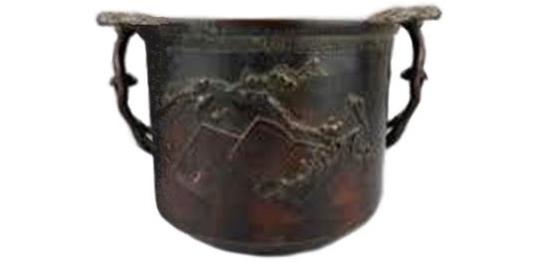
The menu for the kaiseki apparently would have consisted of hoshi-na saku-saku-jiru [干菜サク〰汁] (miso-shiru containing coarsely chopped dried greens -- usually the leaves of the daikon [大根] and kabura [蕪], Japanese turnip), ume-katsuo [梅鰹] (mashed ume-boshi mixed with the katsuo-boshi and kombu -- the latter cut into small pieces -- left over from making the miso-shiru), yu-namasu [柚膾] (a sort of raw salad made from julienned daikon, carrot, and slivers of yuzu rind, dressed with a mixture of rice vinegar, soy sauce, and mirin); with fu-no-yaki [麩の焼] and grilled, salted shiitake [椎茸] as the kashi.
__________
*In the chakai on which the present one is based, Rikyū tried a new arrangement by placing the futaoki in the middle of the mat. This derived from a practice associated with the old 1.5-mat room that had fallen into disuse along with that setting.
†In other words, the second day of the Ninth Month of Tenshō 15 (October 3, 1587). The post describing that gathering is entitled Nampō Roku, Book 2 (50): (1587) Ninth Month, Second Day, Night.
The URL URL for the post that details that chakai is:
https://chanoyu-to-wa.tumblr.com/post/184419990291/namp%C5%8D-roku-book-2-50-1587-ninth-month
‡With respect to the kane-wari: the toko held the kakemono, and so was han [半]; the room had the kama in the ro, and so was also han [半]; and the tana supported the kōgō and habōki, arranged side by side (with each contacting a different kane), and so was chō [調]: han + han + chō is chō.
**As for the kane-wari: the bokuseki remained hanging in the toko, with the chabana arranged on the floor of the toko in front of it, and so was chō [調]; the room had the kama in the ro, the mizusashi, with the chaire and chawan arranged in front of it, and the futaoki (with the hishaku resting on it) associated with the central kane, making the room han [半]; the tana was apparently empty, and so would be counted as chō [調]: chō + han + chō is han.
††Consisting, apparently, of a single chrysanthemum flower and its leaves.
‡‡This hanaire was also known as Tsuru no hashi [鶴ノ波子].
It was placed on top of a shin-nuri usu-ita (of the variety now known as the yahazu-ita [矢筈板]), which measured 1-shaku 3-sun 2-bu by 9-sun 2-bu.
***The chaire was arranged on a “maru-bon” [丸盆] – a round tray. Unfortunately, the tray that was paired with this chaire was destroyed in the (Edo) Great Fire of 1829, so its make and dimensions have been lost**.

For the sketch I assumed it was a Japanese-made tray, paired with this chaire by Rikyū (and so 2-sun larger than the chaire on all four sides) -- though a tray of the sort favored by Jōō (which would have been 3-sun larger on all four sides) would also have been possible, especially during the daytime (larger trays of this sort would make problems at night, since the tray would get in the way of the feet of the te-shoku [手燭] -- the long-handled candlestick used to provide light to the temae-za).
That said, in light of the tori-awase employed by Rikyū (specifically the large katatsuki-chaire coupled with a large ido-chawan), the size of the tray (whether based on Rikyū's preferences, or Jōō's) would have made displaying the chawan next to the bon-chaire impossible. Hence, the same kind of temae that Rikyū had been doing with the maru-tsubo chaire arranged on the (Jōō-sized) square ebony chaire-bon would have been used.
◎ This is something that is frequently ignored by the commentators: once Rikyū did something that was unusual, and he found a way to make it “work,” he often continues to use the same (or similar) arrangements, in order to habituate himself to the procedure. This is no different from what any experienced chajin would do today -- and serves to remind us that Rikyū was, indeed, an experienced chajin, rather than an all-knowing "tea god" as many make him out to be. He was as human as any of us, and his methods were exactly the same, too.
If for no other reason, the study of Rikyū's kaiki reveals to us the man behind the myth.
†††The futaoki was placed to the left of, and near the far end, of the mukō-ro, with the hishaku resting on top of it -- as seen in the sketch (above). These things were associated with the central kane (which means that the futaoki would have to rest on top of the kane, if only by a little); and the handle of the hishaku extending no farther forward than the front edge of the ro (again, as shown in the sketch), so it would not enter the yū-yo [有余].
———————————————————————————————————
The reader should understand that the above notes apply equally to the following two chakai (which essentially replicate this one) as well.
1 note
·
View note
Text
Nampō Roku, Book 2 (51): (1587) Ninth Month, Thirteenth Day, Midday.

51) Ninth Month, Thirteenth Day; Midday¹.
◦ O-nari [御成]².
◦ Kuchi-kiri [口切]³.
◦ Two-mat room⁴.
Sho [初]⁵.
﹆ A portrait of Rinzai zenji [臨濟禪師]⁶.
◦ Kama ito [釜 糸]⁷.
◦ On the tana: kan ・ habōki [クハン ・ 羽帚]⁸.
▵ Shiru saku-saku [汁 サク〰]⁹.
▵ Gan ・ shō-rō [鴈 ・ 松露]¹⁰.
▵ Yu-miso [柚ミソ]¹¹.
▵ Fu-no-yaki ・ kawa-take [フノヤキ ・ 川茸]¹².
[Go [後].]¹³
﹆ In the kuchi-hiro hanaire [口廣花入], a single chrysanthemum blossom¹⁴.
﹆ On the tana: maru-tsubo [丸ツホ], on a hō-bon [方盆]¹⁵.
◦ Mizusashi Shigaraki [水指 シカラキ]¹⁶.
◦ Hishaku ・ hikkiri [ヒシヤク ・ 引切]¹⁷.
Su [ス]¹⁸.
◦ Chawan Soto-no-hama [茶碗 外濱]¹⁹.
After tea was finished, [Hideyoshi] amused himself by arranging the charcoal²⁰.
_________________________
¹Ku-gatsu jū-san-nichi, hiru [九月十三日、晝].
The date was October 14, 1587, in the Gregorian calendar.
²O-nari [御成].
This means to receive a visit from ones lord -- in this case, Toyotomi Hideyoshi. On this occasion, it seems that Hideyoshi participated in the chakai unattended -- an indication of the level of trust that he was now placing in Rikyū.
³Kuchi-kiri [口切].
Rikyū waited until Hideyoshi's visit to open the first jar of the new tea -- which had been harvested between April 27, and May 17 (May 7 was the 88th day of the Lunar Year, and the feast day of Bhaiṣajyaguru, the Buddha, or Bodhisattva, of Healing -- Yakushi Nyorai [藥師如來] in Japanese -- so no processing of tea leaves was done on that day).
Rikyū does not mention which of his cha-tsubo was used on this occasion (it is possible that he only had one, though his rising position in Hideyoshi’s household would suggest otherwise) -- though it would have been the jar that contained the best tea of the year.
⁴Nijō shiki [二疊敷].
The two-mat room in Rikyū's official residence.
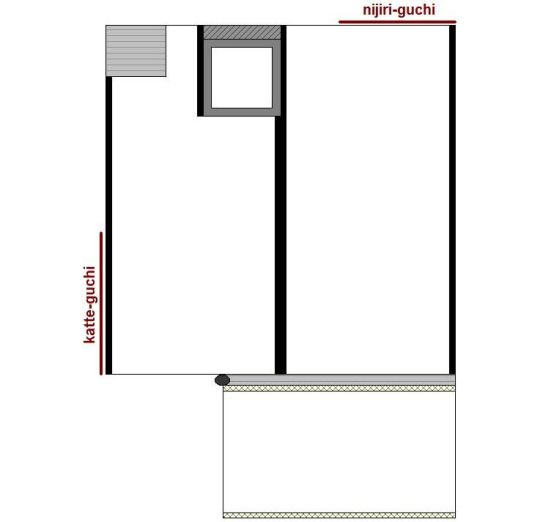
⁵Sho [初].
The shoza.
With respect to the kane-wari:
- the toko contained the kakemono, and so was han [半];
- the room had nothing but the kama in the ro, and so was han [半] as well;
- and the tana held the kan and habōki (arranged side by side, with each touching a different kane), and so was chō [調].
Han + han + chō is chō, which is appropriate for the shoza of a gathering held during the daytime.
⁶Rinzai zenji zō [臨濟禪師像].
Though Rikyū mentions nothing but the subject matter*, this appears to be the painting, by the fourteenth century Japanese artist Soga Jasoku [曾我蛇足; his dates of birth and death are not known], shown below.

While most of the details of Jasoku's career have been lost to history, it is said that he studied Zen under Ikkyū Sōjun [一休宗純; 1394 ~ 1481]. Furthermore, various commentators add that Ikkyū, in turn, seems to have learned painting from Jasoku.
Though the Soga family, which was one of the famous painting families of the Edo period, claimed descent from Soga Jasoku, in fact it appears that the the line had been broken, and that they had no actual connection with him (other than the shared -- or, perhaps, appropriated -- name).
The kakemono is marked with a red spot in the Enkaku-ji manuscript of Book Two of the Nampō Roku, indicating that it was the featured utensil during the shoza.
__________
*Possibly, because this was a domestic work, rather than one imported from the continent, such details were considered common knowledge, and so not important to mark down in his kaiki (which, after all, was a document intended purely for his own, personal reference).
⁷Kama ito [釜 糸].
The designation should be ito-me [絲目 or 糸目]. Either Rikyū abbreviated the reference (perhaps because he was in a hurry to get all of the details down before he forgot them), or the original manuscript had begun to deteriorate by the time it came (briefly) into Tachibana Jitsuzan’s hands.

This kama, which is described as being an “old Ashiya kama” [古蘆屋釜], was owned (and perhaps designed by) Jōō.
⁸Tana ni kan ・ habōki [棚ニクハン ・ 羽帚].
In addition to his bronze kan (which he seems to have used when suspending the kama over the fire from the ceiling), Rikyū also owned a pair that was made of iron. This type of kan is known as sasage-kan [大角豆鐶], because the undulating surface resembles the seed-pods of this bean (which is an auspicious symbol).

A pair of sasage-kan is shown above, arranged on a tsuri-dana together with a go-sun-hane, as described in this kaiki. (Notice that the opening of the kan is turned in the direction of the kama.)
⁹Shiru saku-saku [汁 サク〰].
This was miso-shiru, containing coarsely chopped greens from the kitchen garden. The greens were put into the soup just before it was served, so they would still be fresh and crisp when eaten.
¹⁰Gan ・ shō-rō [鴈 ・ 松露].
Gan [鴈 – more commonly written 雁] is the wild goose. The goose would have been provided to Rikyū by Hideyoshi's hawkers.
Shō-rō [松露], which means pine-dew, refers to the Japanese native “false truffle” (Rhizopogon species), which are found growing in pine barrens near the sea. The immature fruiting bodies (sporocarps), which are white inside, are preferred.
While Rikyū does not specify how these two foods were served, perhaps it was in a clear soup* (with the goose mashed and formed into dango [團子] -- meatballs).
__________
*Made by boiling the flesh and bones of the goose together with pieces of daikon and, in this case, the sliced truffles.
¹¹Yu-miso [柚ミソ].
Yu-miso [柚味噌], as has been mentioned before, is actually the name of a dipping sauce -- that seems to have been one of Rikyū’s personal favorites, especially during the early winter when the yuzu had just ripened*.
A small yuzu† is taken and the top end (where the stem was attached) is cut off like a cap. Then the flesh is carefully removed, leaving the skin intact like a bowl. This is filled with miso, and then placed beside or below a charcoal fire (the heat should come from the side, or above, rather than from below) until the outside of the yuzu begins to char lightly. The heat causes the flavor and aroma of the yuzu to permeate the miso.
This miso, then, was served with various raw vegetables (usually “crunchy things” like cucumbers and carrots, and other vegetables that could be cut into small “spears”). The guest selected his vegetable and dipped the end into the miso before eating it‡.
While on many occasions when he served this dish Rikyū mentioned that it was accompanied by sanshō [山椒] (“Japanese pepper”), nothing of the sort is said here, so it is unclear whether this spice was included or not**.
___________
*Even today, flavored miso is a popular dipping sauce for raw vegetable spears in Korea – though usually the miso contains crushed garlic, sesame oil, and crushed Korean red pepper paste today, since something like yu-miso is too troublesome to prepare (because it can only be made in small quantities), and, of course, it would be limited to the season when yuzu are available.
†The size is probably not too important, so long as it is not overly large (a large yuzu will begin to char on the outside before the middle of the miso is even hot; and the farther away from the skin the miso is, the less yuzu taste and smell will be imparted).
In Edo period Japan, the preference was to give each guest his own little yuzu filled with miso, into which he dipped his vegetables. But there is nothing to indicate that Rikyū served it this way: the yu-miso could just as easily have been scooped out onto several small dishes from one larger yuzu, with one dish offered to each guest, since it was the flavored miso that was important.
‡It is also possible that a selection of vegetable spears was arranged on a small plate, and the yu-miso was drizzled over them.
If it was included, a separate dish of crushed sanshō (”Japanese pepper”) would then have been offered together with the vegetables, so that the guest could spice the food to his taste.
**Perhaps Hideyoshi was averse to spicy tastes? (The upper classes were said to prefer more delicate flavors, so perhaps Hideyoshi was intent on avoiding anything that might call attention to his plebeian origins.)
¹²Fu-no-yaki ・ kawa-take [フノヤキ ・ 川茸].
Fu-no-yaki [麩の焼] are small wheat-flour crêpes, thinly spread with (naturally sweet) white miso, and then rolled or folded into bite-sized pieces.
Kawa-take [川茸] is a kind of freshwater seaweed that grows in flowing water. It would seem that Rikyū preferred to serve it raw, since he only served kawa-take during those times of the year when the rivers would be flowing with clean water (during the rainy season; and after the weather had turned cold) – so as to avoid the danger of enteric diseases that might result from using kawa-take collected from contaminated water.
¹³This word (go [後], meaning the goza) is not found in the Enkaku-ji manuscript of Book Two of the Nampō Roku. Nevertheless, it is clearly implied from the context.
As for the kane-wari:
- the toko held the chabana, and so was han [半];
- in addition to the kama, the room also had the mizusashi, and the hishaku, resting on the futaoki (these on the mat to the left of the mukō-ro, in association with the central kane, as shown in the sketch, below), making the room han [半];
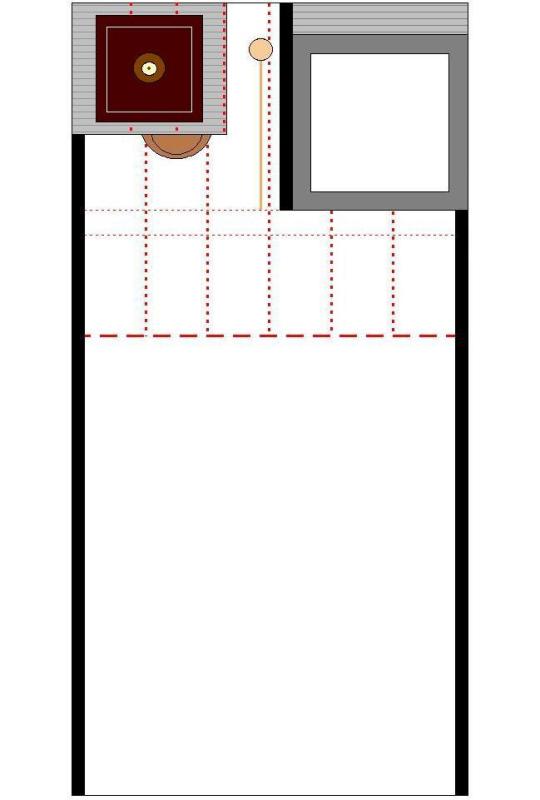
- and the tsuri-dana supported the bon-chaire, and so was han [半] as well.
Han + han + han is han, as appropriate for the goza of a chakai that is given during the daytime.
¹⁴Kuchi-hiro hanaire ni kiku ichi-rin [口廣花入ニ 菊一輪].
This was the large bronze hanaire now usually referred to under the name Kine-no-ore [杵のをれ]. It is in the Tokugawa collection.
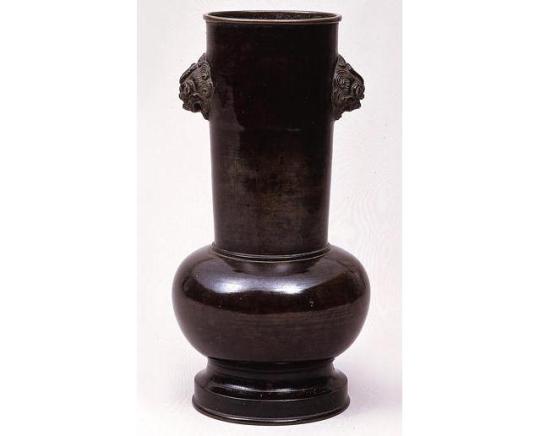
The hanaire would have been placed, on an usu-ita*, in the middle of the floor of the toko.

The flower was a single chrysanthemum flower, with its leaves. Since this chakai was held during the daytime, the flower could have been of any color, including white blushed pink by the frosts.
The chabana (along with the chaire) is marked with a red spot in the Enkaku-ji manuscript. This indicates that the hanaire was one of the featured utensils used during the goza.
Both Shibayama Fugen and Tanaka Senshō importantly include a reference to the passage in Book One that begins “ko-zashiki no hana ha kanarazu ichi-iro wo ichi-eda ka ni-eda ka roku ike-taru ga yoshi...” [小座敷の花は必らず一色を一枝か二枝かろくいけたるがよし]† -- though this passage really is not especially enlightening, or revealing, with regard to Rikyū’s chabana here.
They also devote considerable space to discussing what kind of chrysanthemum might have been displayed -- all while studiously avoiding any discussion of the kane-wari‡.
__________
*As usual, this was what is now called a yahazu-ita [矢筈板], measuring 1-shaku 3-sun 2-bu from side to side, and 9-sun 2-bu from front to back. It was painted with shin-nuri.
†Which I translated “with respect to the flowers for the small room, without exception only one kind [of plant material] should be used; and it is best if a single stem -- or perhaps two -- is placed [into the container] without any sort of manipulation.” The full text of this passage, along with my commentary, may be found in the post entitled Nampō Roku, Book 1 (7): Flowers for the Small Room; and Flowers for the 4.5-mat Room.
The URL for that post is:
https://chanoyu-to-wa.tumblr.com/post/175182365610/namp%C5%8D-roku-book-1-7-flowers-for-the-small
‡If one is ignorant of the possibility that the hishaku and futaoki can be displayed immediately to the left of the mukō-ro (this practice was morphed into placing the hishaku on the ro-buchi by Sōtan, which resulted in people forgetting the original precedent on which his arrangement was based), then it will be impossible to understand how Rikyū managed to satisfy the demands of kane-wari with the selection of utensils entered in the kaiki on this occasion.
This kind of arrangement originally appeared in the ichijō-han [ 一 疊半] room.
¹⁵Tana ni maru-tsubo hō-bon ni [棚ニ丸ツホ 方盆ニ].
This is the chaire that is now known as the Rikyū maru-tsubo [利休丸壺] -- on account of its appearance in this kaiki. This is a karamono chaire, measuring 2-sun 4.5-bu in diameter.

The karamono koku-dan hō-bon [��物黒壇方盆]* shown in the photo (below) -- which seems to have been provided by, or in conformity with the teachings of, Jōō -- measures approximately 8-sun 5-bu in diameter‡.
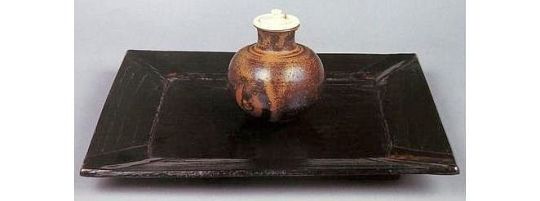
As mentioned above, the chaire was also marked with a red spot, indicating that this, too, was one of the featured utensils. Rikyū uses it several times more before the end of this kaiki, and then it seems to disappear from his collection. Some have suggested that this repeated use indicates that Rikyū wanted to sell the chaire, and was angling for buyers.
With respect to the temae, things would have been done in the same way as described under footnote 13 (and its sub-notes) in the previous post†.
___________
*Koku-dan [黒壇] is ebony.
†To describe things briefly, the chawan and koboshi would have been brought out and placed in their usual temporary seats on the left side of the mat, respectively. Then the bon-chaire would have been lowered from the tana, and placed in front of the mizusashi (with the chaire located within the temae-za). Then the futaoki and hishaku would have been moved to the right side of the mat, as usual, followed by the sō-rei.
After folding the fukusa and placing it in the futokoro of his kimono, the host would attend to the bon-chaire. Only after it was safely in its usual place on the left side of the temae-za would the chawan be moved in front of the host’s knees, the chashaku cleaned with the fukusa and rested on the tray (to the right of the chaire), and so forth.
‡All of the old “karamono higashi-bon” [唐物干菓子盆] of the various shapes (these are all between 8-sun and less than 9-sun in diameter) were originally imported from the continent (during Jōō’s middle period) for use as chaire-bon for the large katatsuki (which were the most popular tea containers at this time, due to the fact that the usual number of guests was originally 10 -- though later reduced to 5 or 6 people on account of the logistics of serving both one bowl of koicha and up to two bowls of usucha to each guest -- based on the pattern of the Shino family’s kō-kai [香會]). These trays lost their purpose after people began to imitate Rikyū's use of the smaller chaire-bon (which were supposed to be 2-sun larger on all four sides, rather than the three-sun on all four sides preferred by Jōō); and, being prized (and so expensive) antiques, these trays were “repurposed” as higashi-bon during the Edo period, once the service of these kashi immediately prior to the drinking of usucha began to become commonplace (when, with the availability of already-ground matcha began to become common, which fell in with the government’s encouragement of the service of usucha using a different kind of matcha -- and a different set of utensils -- from the koicha). This is a reflection of how Rikyū, and his teachings and practices, began to vanish at the very hands of the people (the Sen family under Sōtan, and the Tokugawa bakufu that recognized Sōtan as Rikyū’s official heir) who were supposed to be keeping his memory alive.
While Sōtan recognized that a “small tray” was preferred for used as a chaire-bon, he apparently never understood the way that its size was supposed to be calculated based on the diameter of the chaire that would be used on it. Thus any small tray was used with any chaire; and this remains the case, according to the teachings of the modern schools, even today. Even trays that were selected by Rikyū are rarely encountered in association with the chaire for which they were chosen today: the old chaire having been broken, the tray was reused with something else -- and that chaire rarely had the same diameter as the piece to which Rikyū had originally matched the tray. (Thus we can find “orphaned trays” described in the catalogues of Rikyū’s utensils -- a happenstance that would have struck Rikyū himself as extremely odd, if not actually repulsive.)
¹⁶Mizusashi Shigaraki [水指 シカラキ].
This was Rikyū’s Shigaraki mizusashi.
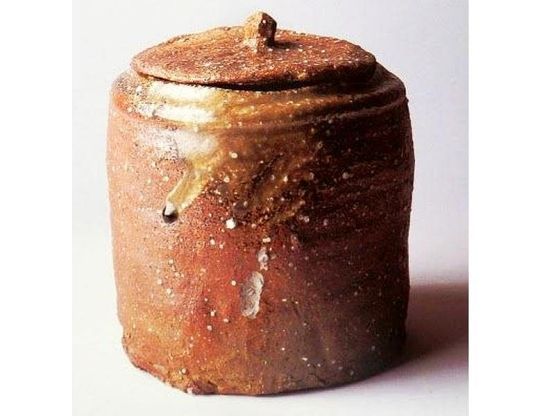
¹⁷Hishaku ・ hikkiri [ヒシヤク ・ 引切].
The hishaku was one of Rikyu’s take-wa [竹輪].

As shown below, the futaoki was placed near the far left corner of the mukō-ro, and the hishaku was rested on top of it (so that the handle, which runs parallel to the edge of the ro, would not extend into the yū-yo [有余]).

¹⁸Su [ス].
This means that the utensils described hereafter were brought out at the beginning of the temae (rather than being arranged in the tearoom beforehand).
¹⁹Chawan Soto-no-hama [茶碗 外濱].
This was Rikyū’s personal ido-chawan; and the bowl is usually referred to as Soto-ga-hama [外ヵ濱] – the name of the place (at the northern tip of Honshū) where the chawan was recovered from the site of an old shipwreck – today.
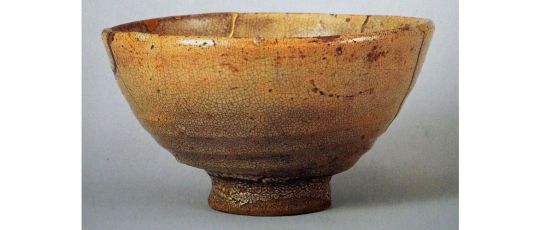
And though nothing is said in this kaiki, Rikyū would also have used an ori-tame [折撓] of his own making as the chashaku, which would have been resting on the chawan (as usual), and brought into the tearoom together with it.

And the koboshi would have been a mentsū [面桶], the usual kind of koboshi traditionally used in this setting, even though it is not mentioned here.
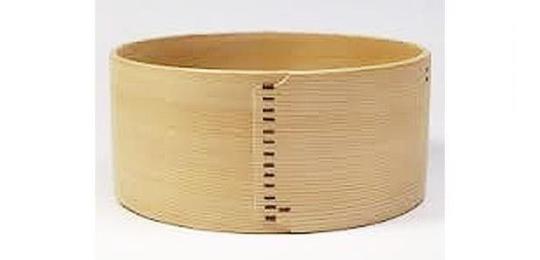
²⁰Cha sugite o-sumi asobasaru [茶過テ御炭被遊].
This entry means that Hideyoshi decided to arrange the charcoal with his own hands after Rikyū’s temae was finished. It seems to have been almost a sort of informal lesson -- he may have been curious about how to repair the fire under these circumstances.
It is unclear (from the text of this kaiki) why Hideyoshi wanted to arrange the charcoal. Perhaps he then proceeded to make a bowl of usucha for Rikyū -- which, since he was the only recipient, Rikyū would have felt unnecessary to mention (there would really have been no other reason to rebuild the fire except if Hideyoshi intended to make a bowl of tea -- since the fire was beginning to decline, as it was supposed to do at the end of a wabi gathering: according to Rikyū, the measure of a chajin’s mastery is that he can build a fire that returns the kama to a boil efficiently, keeps it boiling strongly until the service of tea is finishing, and then begins to decline during the haiken that concludes the temae...yet the kama must not fall completely silent while the guests are still present in the tearoom).
On the other hand, Hideyoshi was probably aware that Rikyū was going to host another gathering that night, so perhaps he wanted to help by arranging the charcoal (this would have had to be done at dusk, about the time that this chakai was ending) -- and, since the guests were important chajin, perhaps Hideyoshi was also hoping to make a good impression on them with the way he rebuilt the fire (the action would have struck them as both doing them a great honor, as well as demonstrating Hideyoshi’s skill as a chajin).
If this was the latter case, as is customary at dusk, Rikyū probably emptied and cleaned out the ro, spreading a layer of fresh shimeshi-bai, and then adding some of the larger embers from the earlier fire. It would have been around these that Hideyoshi laid his charcoal.
In this case -- since the kama is usually emptied and then refilled with cold water (that had been kept, since dawn, in the large water-jar in the mizuya) during the sumi-temae that is performed at dusk -- Hideyoshi would have left after concluding his sumi-temae without preparing a bowl of tea for Rikyū (since the water in the kama would have been nowhere near hot enough at that time).
1 note
·
View note
Text
Nampō Roku, Book 2 (4): (1586) Tenth Month, Fifth Day, Evening; Fu-ji [不時].

4) Tenth Month, Fifth Day, Evening¹; fu-ji [不時]².
◦ 4.5-mat [room]³.
◦ [Guests:] Amano Hikosuke [天野彥右]⁴, Ueda Hayato [上田準人]⁵.
Sho [初]⁶.
﹆ From Lord Hino [I received] a chrysanthemum from today's Court Banquet, to which was tied a tanzaku. This was arranged in a basket and hung up in the toko just as it was⁷.
◦ Kama ・ unryū [suspended over the ro on a bamboo] jizai [釜・雲龍 自在]⁸.
◦ On the fukuro-dana [袋棚]⁹:
◦ kōgō ・ Chōjirō kaki [香合・長二郎 カキ]¹⁰;
◦ habōki [羽箒]¹¹;
◦ mizusashi ・ Shigaraki [水サシ・シカラキ]¹².
Su [ス]
◦ The charcoal [was brought out] in a na-kago [菜籠]¹³.
▵ Charcoal-roasted hoshi-sakana [干肴]¹⁴, [accompanied by] two rounds of sake¹⁵.
▵ Mizu-kuri [水栗]¹⁶.
Go [後]¹⁷.
◦ The toko was left just as it was.
◦ On the fukuro-dana:
﹆ chaire ・ nasubi [茶入・ナスヒ]¹⁸, temmoku [天目]¹⁹, these two things, on a naka-bon [中盆]²⁰;
◦ hishaku [ヒシヤク];
◦ futaoki ・ in [蓋置・印]²¹;
◦ mizusashi ・ the same as before.
Su [ス]
◦ Kae-chawan ・ e [カヘ茶碗・繪]²²;
◦ chashaku ・ ori-tame [茶杓・折タメ]²³;
◦ koboshi ・ Bizen [コホシ・備前]²⁴.
_________________________
¹Jū-gatsu itsuka, yū [十月五日、夕].
The date was November 14, 1586 in the Gregorian calendar.
Yū [夕] means evening, dusk. As this was an impromptu gathering (apparently given to honor the chrysanthemum that Rikyū received from Hino Terusuke [日野輝資] as a souvenir of the Imperial Court Banquet that was held earlier that day), it seems likely that Rikyū invited the two guests to his home as they were leaving Hideyoshi’s audience chamber.
²Fu-ji [不時].
Fu-ji [不時] means unplanned, impromptu. Due to its having been completely unscheduled, the refreshments are minimal, with the host making use of the kinds of things that would likely be on hand to serve his guests.
³Yojō-han [四疊半].
This was the 4.5-mat room in Rikyū’s residence.

⁴Amano Hikosuke [天野彥右].
Though he is also mentioned as a guest in the Rikyū Hyakkai Ki [利休百會記], Amano Hikosuke has not been identified with any certainty.
⁵Ueda Hayato [上田準人].
This seems to refer to the bushō [武将] (military man) Tsuda Hayato [津田準人; ? ~ 1593]. It appears that Rikyū confused him, or at least his surname, with Ueda Satarō [上田左太郎].
Tsuda Hayato was a relative of Oda Nobunaga. Originally he served as a member of Nobunaga's cavalry (he held the position of sa-ma no suke [左馬允], third officer of the cavalry's left division), eventually rising to be the protector (or guardian) of Nobunaga's puppet-shōgun Ashikaga Yoshiaki [足利義昭; 1537 ~ 97]*. After Nobunaga's death, he served Hideyoshi in various capacities.
Tsuda Hayato was also actively involved with chanoyu.
__________
*Yoshiaki was the fifteenth and last shōgun of the Ashikaga family. He was essentially deposed by Nobunaga in 1573, by being driven out of Kyōto, though he never officially relinquished his title. Thereafter he shaved his head and took the Buddhist name Shōzan Dōkyū [昌山道休].
Some time after Nobunaga's death, Hideyoshi invited Yoshiaki to return to the throne -- on the condition that he adopt Hideyoshi as his heir (so Hideyoshi could become the sixteenth Ashikaga shōgun), but Yoshiaki refused.
⁶Sho [初].
The details of the sho-za [初座] begin here.
⁷Hino-dono yori kyō [no] gyoen no kiku to te, o-tanzaku musubite dasare sōrō wo, kago ni te toko kakeoki-sōrō sono mama [日野殿ヨリ今日御宴ノ菊トテ、御短尺ムスヒテ被下候ヲ、籠ニテ床ニカケ置候其儘].
Rikyū received a chrysanthemum (with a tanzaku* tied to it) as a gift from Lord Hino†. In order to display it so that the guests could also read the poem without difficulty, Rikyū decided to arrange the flower in a hanging basket hanaire.
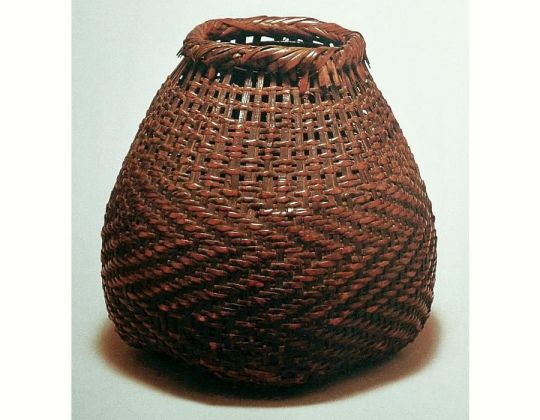
Rikyū's Katsura-kawa kago [桂川籠], which he used as a kake-hanaire, is shown above.
Kakeoki-sōrō sono mama [カケ置候其儘]: Rikyū just put the chrysanthemum in the hanging basket, without manipulating it in any way: he was not “arranging” the flower; he was simply displaying it as it was received from Lord Hino.
___________
*At court banquets, it was the custom for the high noblemen to compose congratulatory poems, which were written on tanzaku (a piece of paper 2-sun wide and 1-shaku 2-sun long, that had a hole in the center near the upper edge, by means of which they were tied to a seasonally auspicious floral offering -- in this case, a chrysanthemum -- and so presented to the Emperor; the flowers were arranged in front of his seat, and after the conclusion of the banquet the authors were apparently allowed to reclaim their flower and poem as a souvenir).
†Hino dono [日野殿] refers to Lord Hino Terusuke [日野輝資; 1555 ~ 1623], a kuge [公家] (a court noble -- a hereditary nobleman, rather than someone who had been elevated to the rank of courtier from the military caste), who was the Gon-dainagon [権大納言] or (supernumerary) Chief Counselor of State (senior grade of the Second Rank).
⁸Kama ・ unryū jizai [釜・雲龍 自在].
This was the second small unryū-gama [小雲龍釜] with matsu-kasa kantsuki [松笠鐶付] (shown below) and an iron lid, that Rikyū had ordered from Yoshirō after presenting the original kama (along with the large Temmyō kimen-buro) to Hideyoshi, for use in the Yamazato-maru tearoom in the boathouse of Ōsaka castle.
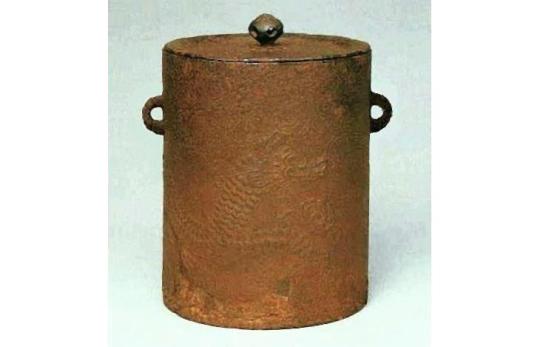
This small kama* was suspended over the ro on Rikyū’s abura-dake jizai [油竹自在]†, using his bronze kan [鐶] and tsuru [弦] (both of which are shown below).

___________
*Rikyū used the small unryū-gama because it would boil quickly. This was an impromptu chakai, and using this kama would allow Rikyū to prepare fresh water for the tea (rather than using water that had been boiling all day, or else changing the water in the large ro-gama and then waiting for it to come to a boil -- with nothing to distract the guests, since preparing a full kaiseki without prior notice would have been impossible).
†Abura-dake [油竹], which means “oily bamboo” (oil-stained bamboo) is usually called susu-dake [煤竹] (smoky-bamboo; smoke-stained bamboo) today. Both names refer to the 1-sun diameter bamboo poles taken from the underside of a farmhouse kitchen when the building was repaired or rebuilt, that have been stained by exposure to years of oil-filled cooking smoke. As a result, the bamboo becomes a dark brown-purple in color (though the color is mottled, rather than being uniform as in the case of artificially dyed bamboo).
⁹Fukuro-dana ni [袋棚ニ].
This refers to the fukuro-dana that was created by Jōō (shown below), based on the similar tana that was used by the Shino family at their incense and tea gatherings.
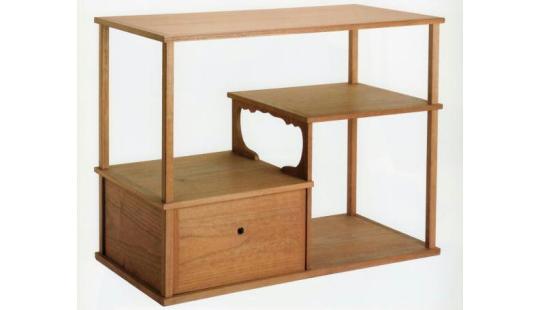
The Shino-dana [志野棚] has a pair of hinged doors, with a locking mechanism (to keep the host’s collection of kyara [伽羅] incense wood, that was stored in the ji-fukuro, safe); Jōō replaced the pair of locking doors with a single lift-out door -- and he also changed the procedures so that the guests were encouraged to open the ji-fukuro to inspect its contents each time they entered the tearoom (the shōkyaku was responsible for opening the door, while the last guest was charged with closing it again before the host entered for the temae).
Jōō’s famous Daikoku-an poem refers to this fukuro-dana.
◎ While Jōō originally taught that the fukuro-dana should be placed on the right side of the mat (so that its right edge sat on top of the right heri of the utensil-mat), after Rikyū entered Hideyoshi’s service (if not before) he began to center the fukuro-dana on the utensil mat (just as is done with all of the other oki-dana [置棚] during the ro season).

◎ At the beginning of the sho-za, the habōki and kōgō were arranged together on the naka-dana (the shelf above the mizusashi), with the mizusashi below.
¹⁰Kōgō・ Chōjirō kaki [香合・長二郎 カキ].
There appears to be an error in this entry. All of the manuscripts of the Nampō Roku (apparently including Jitsuzan’s original version which he copied with the original Shū-un-an documents in front of himself) -- with the exception of the presentation copy that Tachibana Jitsuzan gave to the Enkaku-ji -- read kōgō ・ Chōjirō-yaki [香合・長二郎ヤキ]*. Only the Enkaku-ji version reads kōgō ・ Chōjirō kaki [香合・長二郎 カキ].
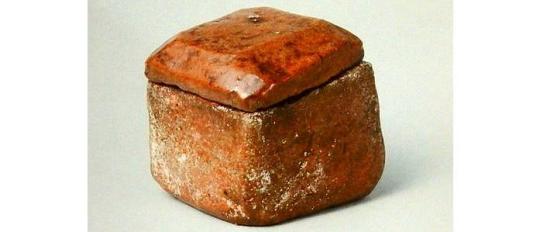
The issue can best be addressed in this way. Chōjirō [長次郎] (to use the currently accepted representation of his name) had been employed by Hideyoshi to create the (unglazed) sculptures that would decorate the roofs of his Juraku-tei [聚樂第] palace (which entered the initial stages of construction earlier the same year -- 1586). Making glazed pottery for Rikyū was a side-job, almost more like a hobby. Chōjirō appears to have been familiar with the basic technology (which was similar to pottery techniques used in the kilns at Masan, in Korea -- though in that case they coated the raw clay with white slip before glazing, while Chojiro was using a slip colored with red iron-oxide), though it seems that he had never used it before in his own craft. Since he was not a professional potter who worked with glazes, he was still in the experimental stage in the autumn and winter of 1586, thus his bowls and other pieces from this early period are generally very simple and regular in shape (since he was still learning how the clay body interacts with glaze, and how both respond to the heat in the kiln). Chōjirō, as a professional sculptor, would certainly have been capable of modeling a kōgō that resembled a persimmon (or, indeed, an even more elaborate shape); but the other pieces fired at this time suggest that he did not do so because he was still learning how to make glazed pottery.
The error likely crept in because the katakana for ka [カ] is similar to the katakana for ya [ヤ] -- and the similarity may be even more pronounced in handwritten documents (and especially if the writing was done quickly, as appears to have been the case when Jitsuzan copied the Shū-un-an documents -- since he was apparently given only limited access to them). When Jitsuzan got around to writing out the presentation copy, he may have forgotten what he had originally seen, and interpreted his notes through contemporary knowledge -- that the pottery was referred to as Raku-yaki (not Chōjirō-yaki), even when speaking about pieces made by Chōjirō; and because the Raku family was, in his day, making kōgō in all sorts of shapes, including persimmons, copied from the so-called “katamono kōgō” [型物香合] that had been imported from the continent†.
The cube-shaped kōgō shown above was made by Chōjirō during the early part of his career as a Raku potter‡. Indeed, this seems to be the earliest kōgō-like piece associated with his name. Thus, it may either be the kōgō that Rikyū used on this occasion**, or a sibling fired around the same time.
___________
*Some second-generation manuscripts, which were copied from the earlier versions, unambiguously read Chōjirō-yaki [長二郎燒] -- meaning that this word is being used as the name for the early Raku-ware created for Rikyū by Chōjirō [長次郎].
†As an example, here is a modern Korean copy of a classical Korean container (used as a seal-ink case), and a modern Raku kaki-kōgō.

The latter was clearly inspired by the prototype of the former, even if it was not copied directly.
‡Both the unstable quality of the glaze, and the fact that the piece had partly collapsed from the heat of firing attest to its early date.
**The imperfect quality of this piece (which mirrors the same sort of imperfection in both glaze and shape seen in Chōjirō’s mizusashi that was used during the first two chakai described in this kaiki from 1586~7) seems to be just the sort of thing that Rikyū appreciated; and its use on the (finely crafted) fukuro-dana would have been characteristic of his tastes as well.
¹¹Habōki [羽箒].
Rikyū does not mention the kind of feathers used for this habōki -- probably because habōki were replaced frequently*, and so did not demand special notice.
Because Rikyū is using an o-dana [大棚] in a 4.5-mat room, the habōki is of the larger size (with feathers around 9-sun long) -- the kind most commonly seen today†.

Because the chakai was taking place at night, it seems logical that he would have used some sort of light-colored feathers, such as those from a swan (haku-chō [白鳥]), shown above.
Rikyū seems to have gotten his feathers from the birds taken by Hideyoshi’s hawkers, and a quick glance back at the Rikyū Hyakkai Ki will give the reader an idea of the possibilities.
___________
*Some people during his period actually used them only once -- which is why we have very few authentic examples of habōki from Rikyū’s day.
†Because they were changed frequently, few habōki survived from Rikyū’s day (or before) into the Edo period. And, curiously, those that did were all habōki made from especially beautiful feathers from the earlier period (when a 4.5-mat room was always used -- in a room of 4.5-mats and larger, the “utensil mat” is considered to be a maru-jō, a full-sized mat; thus a larger habōki was used to clean it).
Lacking (or perhaps closing their eyes to) other examples, the machi-shū schools argued that the surviving habōki with feathers that average 9-sun in length were the only kind that were acceptable for use -- even in the small room, and even on the daime (and so directly opposed to Rikyū’s own teachings on the matter).
This is why the go-sun-hane [五寸羽] that were preferred by Rikyū for use in the small room (where the utensil mat is always considered to be a daime -- whether it is actually a daime-tatami or a full-length mat) are rarely seen and almost unknown today.
¹²Mizusashi ・ Shigaraki [水サシ・シカラキ].
This was Rikyū’s Shigaraki mizusashi, the same one he used during the chakai recorded in the Rikyū Hyakkai Ki.

In the sixteenth century (as had always been the case), the potters were primarily making things for home and commercial use, not for chanoyu. For the most part, they made tea utensils only on commission -- though it was from around this time (the last quarter of the sixteenth century) that some potters did occasionally make things that could be used for chanoyu without their being pre-ordered, and fired them when there was space in the kiln.
While some pieces were fired only once (like this one), others -- such as the hanaire and mizusashi that were heavily encrusted with natural ash deposits that were favored by Oribe -- usually went through multiple firings (it seems these pieces were simply left in the kiln when the utilitarian objects were removed for sale, in accordance with the feedback that the potters had received from people like Rikyū and Sōshitsu).
Because of the still relative rarity of such things, when a chajin acquired a piece that fulfilled his needs (aesthetic as well as practical), he was unlikely to think about replacing it.
¹³Na-kago [菜籠].
The original na-kago [菜籠]* were shallower than this sumi-tori, made with a square bottom and somewhat flaring, circular mouth, and intended to display produce in the wet market (generally the price quoted by the merchant was for the contents of one basket).
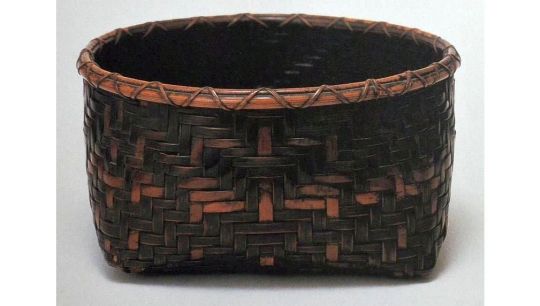
This kago was made for Rikyū, probably to his design, and intended to be used as a sumi-tori†. The kind of bamboo that was used was referred to as abura-dake [油竹] (oily bamboo) in Rikyū’s period‡, and was salvaged from the underside of the roofs of farmhouses when they were rebuilt. Rikyū liked this kind of bamboo because of its mellow, aged appearance. Because the bamboo that was used to line the roofs was usually just 1-sun in diameter (this kind of bamboo was commonly available everywhere in Japan), with thin walls, it was suitable only for use when making something like a jizai [自在], for the so-called “purple” chasen and chashaku, or split and used in basketry, as here.
___________
*The kanji can also be pronounced sai-ro [菜籠].
†While Jōō‘s rule was that basket sumi-tori were to be used with the furo, and fukube sumi-tori were to be used with the ro, Rikyū occasionally used a basket with the ro. Aside from aesthetics, Rikyū’s usage may simply reflect the fact that tea utensils were increasingly being made specifically for use in chanoyu (and thus something like a basket could be made whatever size the person ordering it preferred), whereas in Jōō’s day people used pre-existing things that they found in the market (and na-kago, as the usual way to display produce, were both ubiquitous, and of a uniform size -- and that size was too small to hold a whole day’s supply of charcoal the way a fukube could), and so their preferences were limited to what they could find. In fact, this was how it had been since the beginning of chanoyu. Making things specifically for chanoyu was really a revolutionary idea, one that began with Furuta Sōshitsu -- and it was one of Oribe’s greatest contributions to the way that chanoyu evolved thereafter.
‡It is usually called susu-dake [煤竹] (smoke-stained bamboo) today, probably because the word abura-dake (especially when thinking about chasen) makes people think that it will damage the taste of the tea.
¹⁴Hoshi-sakana aburite [干肴 アフリテ].
Hoshi-sakana [干し肴] means “dried fish;” aburu [炙る] means to roast or char over a charcoal fire. Hoshi-sakana aburite is shown below.
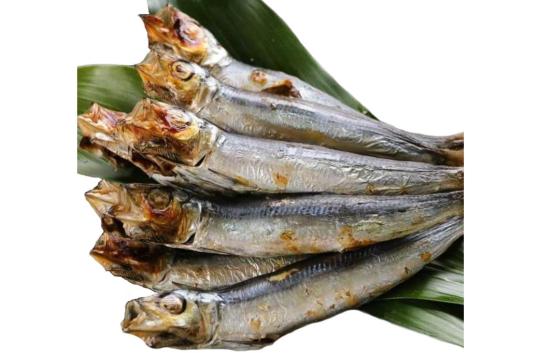
The most common fish served in this way is the ma-iwashi [真鰯] (Sardinops melanostictus), known as the Japanese pilchard (a kind of “sardine”). It is also known in Japanese as nanatsu-boshi [七つ星] (”seven stars”), which name was explained as being a reference to the fact that usually seven of the dried fish (which are silver-gray in color) are tied together with a rice straw cord, and so sold in the market (the above photo, perhaps coincidentally, shows seven fish). Usually fish between 5- and 6-sun in length that were air-dried are served in this way.
This kind of food is a typical side-dish served together with sake [酒] -- even today.
¹⁵Sake ni kaeshi [酒 二返].
Kaesu [返す] means to come back, return. In the traditional drinking custom, the host drinks with each guest (he pours for the guest, and then the guest returns the sakazuki [盃] to the host, and pours him a drink of sake).
¹⁶Mizu-kuri [水栗].
The “water chestnut” (the English name is a translation of one of its Chinese kanji names) is the corm of the sedge known as shiro-guwai [白慈姑] (Eleocharis dulcis) in Japan. While often sweetened today by boiling the corms for a short time in honeyed water, they can also be grilled over charcoal, or even eaten raw. It is not clear from the kaiki how Rikyū prepared the mizu-kuri on this occasion.
However, both Tanaka Senshō and Shibayama Fugen quote a different explanation: according to their source, raw chestnuts are shelled, and then the pellicle (the thin, brown “skin” that covers the creamy-white flesh) is scraped away from one half of each fruit in a comma-like shape (”,”), so that each fruit resembled a 3-dimensonal futatsu-tomoe [二つ巴] (the “Yin-Yang” symbol). Because the pellicle is extremely bitter, the fruit must then be soaked in water for several hours to leech out the bitterness, after which the mizu-kuri can be served.
While their information is surely historically accurate, so far as this way of preparing raw chestnuts is concerned, the problem with their idea is that this was a fu-ji [不時] -- impromptu -- chakai. If Rikyū had sufficient forewarning to prepare a snack that required several hours of soaking, he would have had adequate time to cook and serve a kaiseki.
¹⁷Go [後].
This refers to the go-za [後座], the description of the arrangements for which follows.
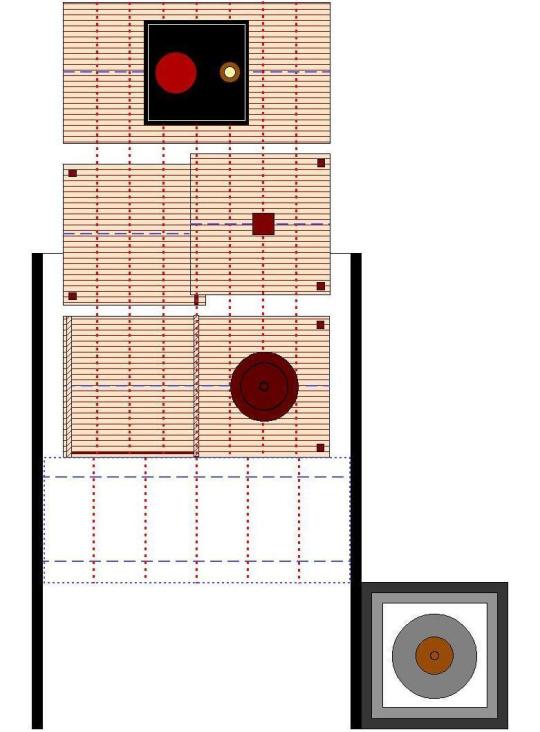
◎ At the beginning of the go-za, the, the chaire and chawan were arranged together on a naka-bon [中盆], displayed on the tei-ita of the fukuro-dana, and the meibutsu futaoki was displayed alone on the naka-dana (the shelf above the mizusashi). The mizusashi remained as it was during the sho-za.
¹⁸Chaire ・ nasubi [茶入・ナスヒ].
This seems to be the nasu chaire now known as the Rikyū ko-nasu [利休小茄子] -- because the other “nasu-chaire” associated with Rikyū -- the Konoha-zaru [木ノ葉猿] -- would be too large to be arranged on a naka-bon together with Rikyū’s temmoku. The Rikyū ko-nasu is between 1-sun 9-bu and 2-sun in diameter; the Konoha-zaru chaire is 2-sun 5-bu in diameter.
Rikyū is said to have presented this chaire to Hideyoshi sometime after the present chakai.
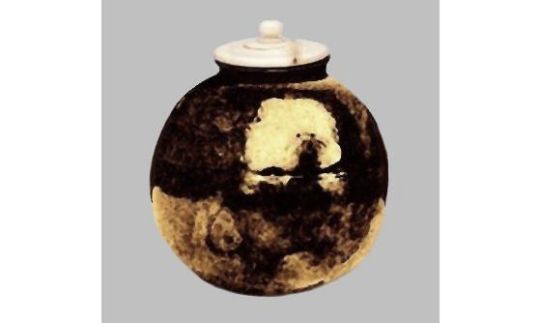
This chaire is rarely seen today -- indeed, the above photo from the beginning of the 20th century, is the only one I could find. This chaire is considered to be a kan-saku karamono [カン作唐物 = 韓作唐物], which means it was made in Korea during the first half of the fifteenth century.
The small size means that it can only hold enough tea for two guests* (if both koicha and usucha will be served).
___________
*This is, in fact, usual with respect to the ko-tsubo chaire. In the old days, ko-tsubo were used when serving tea to a nobleman (originally, to the image of the Buddha). Thus only a single bowl of koicha would be made during the temae (the fact that the chaire held more than enough tea was a precaution; and filling the chaire fully also helped to protect the tea from contact with the air, which would cause it to degrade).
¹⁹Temmoku [天目].
This was Rikyu’s temmoku chawan, which he sometimes referred to as an ake-temmoku [朱天目], which is a sub-variety of the nogime-temmoku [禾目天目] that has an especially reddish-toned glaze. It appears that this chawan was actually produced at the Seto kilns; though what Rikyū knew or believed about its origins is unclear from the records that he left*.

This chawan measures 4-sun in diameter.
On this occasion, the (empty) temmoku was displayed on the naka-bon without its shifuku†. The temmoku-dai (if one was used‡) would have been put inside the ji-fukuro prior to the temae.
___________
*Rikyū clearly seems to have handled it as if it were a karamono temmoku.
†Rikyū actually seems to have disliked this classical practice, considering that the cloth of the shifuku would trap dust, which could fall into the chawan as lint, and make it dirty. He preferred to rinse the chawan in the mizuya, and then leave it without a covering -- whether or not the chakin, chasen, and chashaku were placed in it (though the absence of the shifuku is an invitation for the host to do this, too).
‡Nothing is said in the kaiki regarding this point. The temmoku-chawan could not have been displayed on the naka-bon together with the chaire if it were resting on its dai: the naka-bon is too small for this kind of arrangement.
Rikyū generally seems to have felt that a dai should be used only when serving a nobleman (what the modern schools usually call kijin-date [貴人立て, or 貴人點] today). And while it could be argued that Hosokawa Yūsai might be so treated, because this gathering was taking place at night (when it is generally more difficult to do things), the setting itself would argue against its use.
²⁰Naka-bon [中盆].
While both Shibayama Fugen and Tanaka Senshō say this refers to the round naka-maru-bon [中丸盆] that was one of the six meibutsu trays that were used with the daisu, the larger size of that tray would have made it more difficult to manage at night, when the room was dark. Consequently, the square naka-bon seems more likely.
The shi-hō naka-bon [四方中盆] was not one of the original six meibutsu trays that were used with the daisu. Nevertheless, its use dates at least from the fifteenth century. It is also described in Book Six (“Sumi-biki” [墨引き]) of the Nampō Roku (along with the other six trays).

This shi-hō naka-bon measures 1-shaku square.
___________
*Rikyū’s personal preference for smaller trays also argues for the 1-shaku square shi-hō naka-bon. Also, Rikyū preferred square trays to round ones -- since square trays can be oriented with greater accuracy.
The naka-maru-bon measures 1-shaku 2-sun 3-bu in diameter -- slightly larger than the space available in front of the fukuro-dana. Something else that would have chafed on Rikyū’s sense of propriety.
²¹Futaoki ・ in [蓋置・印].
This was the meibutsu Rinzai-in [臨濟印] (a square bronze name-seal, purportedly made by order of the Emperor of China, that was used by the Tang period Chán monk Línjì Yìxuán [臨濟義玄; ? ~ 866]).
This name-seal had formerly belonged to the great dōbō [同朋] Nōami [能阿彌; 1397 ~ 1471]; and its use as a futaoki is generally credited to him.
Rikyū follows Nōami’s precedent at this chakai.
The Rinzai-in would have been displayed in the middle of the naka-dana (the shelf above the mizusashi) of the fukuro-dana, with the hishaku placed on the kō-dana (the shelf that forms the roof of the ji-fukuro).
²²Kae-chawan ・ e [カヘ茶碗・繪].
This chawan dates to the middle of the Ming dynasty, and was probably imported from the continent around the middle of the sixteenth century.
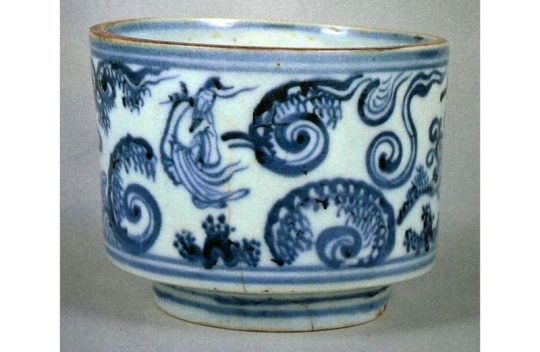
The bowl seems to have been made as an ordinary rice bowl, rather than for any special purpose.
This chawan is now known by the name of Ki-mi-i-dera [紀三井寺], which is a (perhaps fanciful) reference to the painting that decorates the face of the bowl; it is also said to have been one of the first sometsuke [染付] bowls to be used as a chawan in Japan.
The chakin, chasen, and chashaku were brought into the room arranged in the kae-chawan. It may also have been used to help facilitate the serving of usucha afterward.
²³Chashaku ・ ori-tame [茶杓・折タメ].
This would have been a chashaku that Rikyū made to be used with the ko-nasu chaire [小茄子] that is shown above -- albeit in consideration of the fact that it would be rested on a naka-bon (which means that the chashaku had to be longer than if the chaire were being used with a smaller chaire-bon).

²⁴Koboshi ・ Bizen [コホシ・備前].
The Bizen-yaki koboshi shown below was apparently recovered from the site of Rikyū’s former residence (in the Ima-ichi area of Sakai, near the entrance to the Nanshū-ji). The irregular coloring is due to the fact that it was recovered in fragments, and the missing pieces were replaced without attempting to obscure the fact.

This piece may be the actual Bizen koboshi that Rikyū used during this chakai.
1 note
·
View note
Text
Appendix: the Rikyū Hyakkai Ki, Part 32: (1591) Intercalated First Month, Thirteenth Day, Evening.
92) Intercalated First Month, Thirteenth Day; Evening¹.
○ Uraku sama [有樂樣]², Ryūami [立阿彌]³.
○ 4.5-mat [room]⁴.
○ Hairyō gama [拜領釜]⁵;
◦ seitaka chawan [せい高茶碗]⁶;
◦ chaire ・ Konoha-zaru [茶入・木の葉ざる]⁷;
◦ Seto mizusashi [瀬戸水さし]⁸;
◦ usucha ・ Tenka-ichi [うす茶・天下一]⁹;
◦ hirai Seto mizu-koboshi [平イせと水こぼし]¹⁰.
○ Koi no yaki-mono [鯉ノやき物]¹¹;
◦ konowata [このわた]¹²;
◦ koma-koma jiru [こまゝゝ汁]¹³;
◦ meshi [めし]¹⁴.
○ Hikite [引て]:
◦ dengaku [でんがく]¹⁵.
○ Kashi [菓子]:
◦ fu-no-yaki [ふのやき]¹⁶;
◦ yaki-guri [やきくり]¹⁷.
_________________________
¹Urū-shōgatsu jūsan-nichi ・ ban [閏正月十三日・晩].
The Gregorian date of this chakai was March 8, 1591.
An evening chakai generally began shortly after sunset (so that the guests could come to the host’s house without the inconvenience of needing to light their way with a lantern), so the sky would have still been reasonably bright when the guests first entered the room for the sho-za. Thus auxiliary lighting was usually kept to a minimum* at this time. It would be quite dark when they went out for the naka-dachi, however, and so the artificial light had to be increased starting around the time that the kaiseki was served†.
__________
*Generally a paper-shrouded oil lamp sufficed to welcome the guests at the beginning of the sho-za.
†Usually by bringing out a paper-shrouded candlestick to illuminate the shōkyaku's zen.
The flames in the stone lanterns in the roji were lit as the sho-za came to an end, and an andon [行燈] was placed in the genkan near the guests' entrance so they could light their way through the roji to the koshi-kake for the naka-dachi. On their return, the paper shades would have all been removed from the oil lamp and candle that gave light to the interior of the tearoom.
²Uraku sama [有樂樣].
This was the daimyō-nobleman Oda Nagamasu [織田長益; 1547 ~ 1621], a younger brother of Oda Nobunaga. He originally served as an Imperial Chamberlain (jijū [侍従], for which he received the junior grade of the Fourth Rank). He converted to Christianity (taking the name of John) in 1588, and was known as Urakusai [有樂齋] after he retired from public life in 1590.
Urakusai was also a chajin, and had been a close personal friend of Rikyū’s since when Nobunaga was alive. He was also one of the few people whom Hideyoshi treated with perpetual deference.
³Ryūami [立阿彌].
This refers to the man known as Ise-ya ・ Ryūami [伊勢屋・立阿彌], who was a machi-shū chajin from Kyōto.
A letter written to him by Rikyū dated the Thirteenth Day of the Fourth Month suggests that he also held an official position at Juraku-tei – perhaps as one of Hideyoshi’s sadō [茶頭]. Thus he was also an individual who might have private access to Hideyoshi, at least occasionally.
Ryūami’s name is found in a number of other documents from this period, such as the Tennōji-ya Kai Ki [天王寺屋會記] and Tsuda Sōkyū’s diary of his own gatherings (the Tsuda Sōkyū Ji-kaiki [津田宗及自會記]), showing that he was indeed a serious practitioner of chanoyu. He also appeared as a guest at another of Rikyū’s gatherings (that is described in the Rikyū Hyakkai Ki), in the morning of the 20th day of the Eleventh Month of Tenshō 18.
⁴Yojō-han [四疊半].

⁵Hairyō gama [拜領釜].

This small kama (which had originally been made as a kiri-kake gama for use on a large teteu-buro) was suspended over the ro on a bamboo jizai (shown below in an Edo period sketch),

using Rikyū's bronze kan [鐶] and tsuru [弦].

⁶Seitaka chawan [せい高茶碗].

This is the same kuro-chawan that Rikyū received from Chōjirō at the end of the previous year.
⁷Chaire ・ Konoha-zaru [茶入・木の葉ざる].

While this karamono nasu-chaire [唐物茄子茶入] is usually depicted resting on a karamono tsui-koku chaire-bon [唐物堆黒茶入盆] today, the tray was not paired with this chaire until the Edo period, and so has nothing to do with Rikyū’s tastes or preferred usage (though the opposite is generally implied in the presentations). Rikyū, in fact, used this chaire without a tray, with the chashaku resting on the lid as usual.

He thus would also have used an ordinary ori-tame [折撓] with this chaire (though the chashaku is not mentioned in the kaiki), one that he had made by himself.
⁸Seto mizusashi [瀬戸水さし].

⁹Usucha ・ Tenka-ichi [うす茶・天下一].

Tenka-ichi [天下一] refers to Hideyoshi's lacquer artist Tenka-ichi ・ Seiami [天下一・盛阿彌].
This lacquered nakatsugi seems to have been an exact copy of the original shin-nakatsugi that was used by Shukō, hence Rikyū's esteem.
Serving usucha in a separate temae* was not Rikyū’s usual way of doing things, and he probably did so on this occasion as a way to encourage the guests to linger and discuss something -- something very important or perhaps urgent -- as night deepened†.
___________
*When Rikyū served usucha during the same temae -- what is now known as tsuzuki-usucha [續き薄茶] -- he always did so using the tea remaining in the chaire from the service of koicha. Preparing a separate container of matcha for usucha meant that this tea was served during a separate temae.
†Given the timing of this chakai -- the gathering that Rikyū hosted for Tokugawa Ieyasu (at which he was supposed to poison Ieyasu on Hideyoshi’s orders) -- was only 10 days away, Rikyū was probably looking for moral support (if not advice) from two men who were trustworthy friends. That Rikyū, of course, did not murder Ieyasu, implies that he was looking for some way to get out of the order (rather than looking for the resolve necessary to do the deed).
¹⁰Hirai Seto mizu-koboshi [平イせと水こぼし].
This entry seems to contain an error, probably the result of Rikyū's dyslexia*.
This would have actually been the same Shigaraki kame-no-futa koboshi that Rikyū had been using in recent days.

In addition to which he would have used an ordinary take-wa [竹輪] as his futaoki, as usual.

___________
*Rikyū usually wrote the individual entries his kaiki in a very specific order, as his sort of dyslexia seems to incorporate ritualized behavior as a sort of comfort device:
◦ the room,
◦ kama,
◦ mizusashi,
◦ chawan,
◦ chaire,
◦ chashaku,
◦ futaoki,
◦ koboshi,
◦ cha-tsubo, and,
◦ kakemono or hanaire.
The fact that, on this occasion, he seems to have forgotten the mizusashi, and then added it later, implies that he was extremely stressed. Writing Seto (the kamamoto where the mizusashi had been made) rather than Shigaraki, could be another manifestation of his condition, and might provide insights into his deteriorating mental state at this time.
As the plans for Hideyoshi's invasion of the continent (which Rikyū seems to have strongly opposed) began to assume their final form -- and as Hideyoshi was now demanding that Rikyū assassinate Tokugawa Ieyasu (during a chakai, no less) -- Rikyū was becoming increasingly agitated, and his frustrated impotence to do anything that could counter Hideyoshi’s will (and still preserve his life) in the face of these pending crises is beginning to show.
It is possible that the next entry in this translation of the kaiki (which, as the first of the record of the kaiseki, would have been entered into the kaiki during the chakai itself, or immediately thereafter) also contains a similar sort of solecism.
¹¹Koi no yaki-mono [鯉ノやき物].
Koi no yaki-mono [鯉の焼物] means charcoal-grilled carp.
While it is possible to grill carp, this generally was not done*. Thus, while Rikyū wrote koi, it is possible that he actually served sea bream (tai [鯛]), a fish much more suitable for preparation in this way. Perhaps this entry represents another dyslectic mistake on Rikyū’s part.
__________
*This is because of the small bones that the flesh contains. When carp is prepared as sashimi, it is possible to carve the fillets to remove the bones. But grilling requires a thicker portion of the fillet with the skin intact, and the bones (which can not be extracted) makes this style of preparation difficult (and potentially dangerous -- especially at night, when the guest would be even less likely to be able to spot the bones).
¹²Konowata [このわた].
The salted entrails (mainly the gonads and their contents) of the sea cucumber.
¹³Koma-koma jiru [こまゝゝ汁].
This seems to be what is now known as atsume-jiru [集め汁], a version of miso-shiru in which vegetables (daikon, gobō, bamboo shoots, taro petioles known as zuiki [芋茎], and other vegetables that remain fairly crisp after cooking), momen-tōfu, and things like dried fish (including kushi-awabi), are served in a stew-like mixture.
This kind of dish would provide a more substantial offering than just miso-shiru, and Rikyū likely chose it because a gathering held at this time of day included the evening meal.
According to the Hisada-bon [久田本] version of the Rikyū Hyakkai Ki, ko-tori [小鳥]* were added to the soup (rather than something like dried fish).
__________
*Ko-tori [小鳥] is a generic name that refers to the various sparrows and finches that were often taken by the hawkers.
The cleaned birds were probably chopped up into small pieces (with at least the larger bones removed) and then boiled before being added to the miso-shiru.
¹⁴Meshi [めし].
Steamed rice.
¹⁵Dengaku [でんがく].
Dengaku [田樂] is a general name for a cooking style in which grilled food is painted with a miso-based glaze* while it is cooking. This was originally a folk dish that had only recently been adopted by the upper classes. Dengaku, then, would have been an interesting and quite novel dish to serve as the hiki-mono.
Rikyū does not say precisely what sort of food was used, but pieces of momen-tōfu [木綿豆腐] threaded onto bamboo skewers seems a likely candidate, since the same tōfu would also have been included in the miso-shiru that was served earlier.
__________
*A mixture of miso (white or red, or a blend of both, according to preference and the food that is being cooked), sugar, mirin, and sake [酒]: traditionally roughly one part each of sake, mirin, and sugar are combined with two parts of miso to make the dengaku glaze (though the amount of sugar may be increased or decreased to taste -- in Rikyū’s day blocks of sugar resembling tallow were imported from China, and so this commodity was both costly and rare, and consequently used sparingly: if a sweeter taste was preferred, one used freshly made white miso, which is naturally sweet, though it begins to loose its sweetness several days after being made).
The pasty glaze is painted onto the upper side, and the tōfu is not turned over until after the paste has dried (so that it will not drip off). It is cooked for a short time with the glazed side facing the fire, until the sugar in the miso-glaze begins to caramelize, and should be served immediately after while it is still hot.
¹⁶Fu-no-yaki [ふのやき].
Rikyū's wheaten crêpes, spread with sweet white miso or miso-an, and then rolled or folded into bite-sized pieces.
¹⁷Yaki-guri [やきくり].
Roasted chestnuts.
4 notes
·
View notes
Text
Rikyū Chanoyu Sho, Book 6 (Part 18): Rikyū’s Hyaku-kai Ki, (1590) Tenth Month, the Last Day of the Month; Morning.
18) The same [month], the Last Day of the Month; Morning [同晦日・朝]¹.
○ Guests: Naizen [内膳]², Hizen [肥前]³, Tō-sa [藤左]⁴, Gorō-u [五郎右]⁵.
○ 4.5-mat [room]⁶.
○ Shi-hō-gama [四方釜]⁷;
◦ Seto mizusashi [瀬戸水指]⁸;
◦ chaire: Shiri-bukura [茶入 ・ 尻ぶくら]⁹;
◦ Ko-mamori chawan [木守茶碗]¹⁰;
◦ Kankyo no tsubo [閑居のつほ]¹¹;
◦ [ori-tame [をりため]¹²;]
◦ hito-fushi no tsutsu [一ふしの筒]¹³.
○ Yaki-mono (sake) [焼物 (さけ)], kurome [くろめ], soup (daikon [大こん]), rice.
○ Hiki (soshite) [引(而)]: sashimi (koi) [さしみ ・ こい].
○ Kashi: fu-no-yaki [ふのやき], shiitake [しいたけ].
_________________________
◎ The guests at this gathering were four men who held high government and military positions, and who were probably in Juraku-tei to consult with Hideyoshi.
This chakai was probably a semi-official function, giving the men something to do while waiting for their audience with Hideyoshi.
¹Onaji misoka ・ asa [同晦日・朝].
Onaji [同じ] refers to the same month -- that is, the Tenth Month. Misoka [晦日] is the last day of the month.
²Naizen [内膳].
This refers to the daimyō and nobleman Kasuya Takeyori [糟屋武則; 1562 ~ ?]*. His court title was Naizen no kami [内膳正]† (he was the official in charge of the Naizen-shi [内膳司], the office that provided the Emperor's meals; which gave Takeyori the junior grade of the Fifth Rank), hence the form of Rikyū's entry in this kaiki.
Kasuya Takeyori was also one of Hideyoshi's closer associates -- and had been nicknamed one of the Seven Spears of Shizugatake (Shizugatake no shichi-hon yari [賤ヶ岳の七本槍])‡.
__________
*The name Kasuya [糟屋] is also written Kasuya [賀須屋] -- perhaps with hentai-gana.
†The nomenclature is confusing, since a different title (Buzen [奉膳]) was originally accorded to members of the two families (the Takahashi [高橋] and Azumi [安曇] families) who traditionally held the post in olden days. Naizen-no-kami [内膳正] was subsequently used for officials who came from different families.
‡Kasuya Takeyori was the only one of these seven renowned retainers to side with Ishida Mitsunari [石田三成; 1559 ~ 1600] during the battle at Sekigahara; the other six sided with Tokugawa Ieyasu (and so betrayed Hideyoshi's confidence, since the Sei-gun [西軍], or Western Army, lead by Ishida Mitsunari, was the force defending Hideyoshi's son, Toyotomi Hideyori).
³Hizen [肥前].
This seems to refer to Kawajiri Hidenaga [河尻秀長; ? ~ 1600], daimyō and Governor of Hizen (Hizen no kami [肥前守]), on the island of Kyūshū. He was another faithful retainer of Toyotomi Hideyoshi, who died fighting for the Western Army (Sei-gun [西軍]) at the Battle of Sekigahara.
__________
*In some versions of the kaiki, this individual is incorrectly referred to as Oka-hizen dono [阿肥前殿]. This is a miscopying for Kawa-hizen dono [河肥前殿], Kawa being a contraction of his surname Kawajiri [河尻]. (This device was commonly used in informal records at this time, a combination of the first kanji of their family name with an abbreviation of their title -- Furuta Oribe [古田織部], for example, is usually referred to as Furu-ori [古織], or Ko-ori.)
⁴Tō-sa [藤左].
Miyagi Tōzaemon [宮木藤左衛門; dates unknown]. Given the form of his name, he seems to have been of the samurai caste, and considering the company, he must have been a man of importance.
The commentary found in the Sadō Ko-ten Zen-shu [茶道古典全集] version of the Rikyū Hyakkai Ki, places the kanji jō [尉] (meaning "inspector," the third highest administrative rank) after his name*, but in which department he served is not mentioned in their notes.
Elsewhere, other than rare references that appear to confirm the existence of a person of this name in the late sixteenth century, other biographical information seems to be entirely lacking.
___________
*Miyagi Tōzaemon jō [宮木藤左衛 尉].
⁵Gorō-u [五郎右].
This seems to refer to Funakoshi Kagenao [船越景直; 1540 ~ 1611], a general, daimyō, and personal retainer (kashin [家臣]) of Toyotomi Hideyoshi, who was commonly known as Gorōemon [五郎右衛門]. He had participated in Hideyoshi's siege of Odawara the previous summer.
In chanoyu, he was closely associated with Furuta Oribe (who was his teacher) and Kobori Enshū (perhaps Kagenao’s fellow-student).

The meibutsu-gire known as Funakoshi kantō [舟越カントウ] (a piece of the original, approximately life-size*, is shown above) was originally owned by Funakoshi Kagenao.
___________
*The vast majority of meibutsu-gire reproductions have the patterns miniaturized (so that they look better when used to make shifuku for chaire) -- and usually they are woven in brighter colors as well (to appeal, it is said, to young girls). In reality, most are much larger and bolder -- since they were made for clothing people. Most of the cloths known generically as kantō [カントウ = 韓渡] were made in Korea.
⁶Yojō-han [四疊半].

⁷Shi-hō-gama [四方釜].
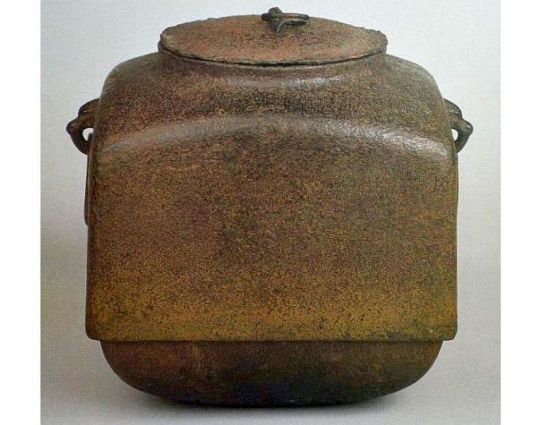
⁸Seto mizusashi [瀬戸水指].

⁹Chaire: Shiri-bukura [茶入 ・ 尻ぶくら].
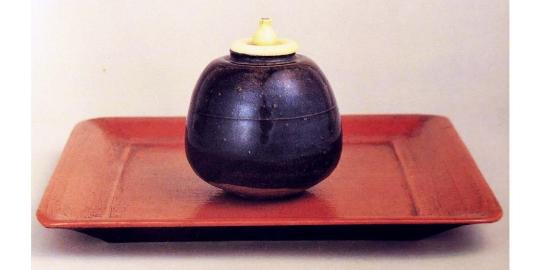
¹⁰Ko-mamori chawan [木守茶碗].

¹¹Kankyo no tsubo [閑居のつほ].
This cha-tsubo was destroyed in a fire during the time of Sen no Sōtan.
¹²Ori-tame [をりため].
As always, this would have been a chashaku that Rikyū made to be used together with the Shiri-bukura chaire on its red karamono shi-hō-bon.

The chashaku is not mentioned in the kaiki as it was published in the Rikyū Chaonyu Sho. Since it is included in the other versions of this entry, however, I have added it here.

Furthermore, neither the koboshi nor the futaoki are described in any of the surviving manuscript sources. It is likely, then, that these were very ordinary things -- probably a take-wa and a mentsū.
¹³Hito-fushi no tsutsu [一ふしの筒].
Probably this take-zutsu was used as an oki-zutsu [置き筒] -- that is, placed on an usu-ita on the floor of the toko.

Seasonal flowers available at this time of year that were suitable for arranging in an oki-zutsu* would include the suisen [水仙]† and the kan-giku [寒菊]‡ -- though the smaller varieties of the camellia (tsubaki [椿]) might also be arranged in a hanaire that is resting on the floor of the toko.
___________
*The first of Rikyū’s seven principals (Rikyū shichi soku [利休七則]) is hana ha no no hana no yō ni [花ハ野ノ花ノヤウニ] -- “with respect to the flowers, [they should be arranged] like the flowers in the wilds” -- which, according to the scholar Nishibori Ichizō [西堀一三; 1903 ~ 1970] (who was considered the top expert regarding the floral arrangements of Rikyū and his period), means that flowers that bloom on trees (i.e., the flowers are encountered above eye-level in nature) should be arranged in a hanging hanaire, while those that bloom below eye-level should be arranged in an oki-hanaire.
Flowers suitable for being arranged in an oki-tsutsu, then, would be those that naturally bloom near to the ground. Suisen and kan-giku are low herbaceous plants, while the shrubby camellias also bloom below eye-level. However varieties of camellia that grow into large trees would be better arranged in a kake-hanaire suspended on the back wall, or at the side, of the tokonoma.

†Suisen [水仙] (above), Narcissus tazetta, was originally a Mediterranean native narcissus that was introduced in antiquity to China (via the Silk Road), and thence to Korea and on to Japan, becoming more or less naturalized in each of these countries.

‡Kan-giku [寒菊](above) is a single to semi-double nearly wild form of Chrysanthemum morifolium with rather small white flowers that blush pink starting in early winter. The late-blooming varieties, which open around the time of the winter solstice, were especially prized in Rikyū’s day, both for their flowers and for their leaves, which also tend to color late in the year.
¹⁴Yaki-mono ・ sake, kurome, shiru ・ daikon, meshi [焼物 ・ さけ、 くろめ、 汁 ・ 大こん、 めし].
The food served on the zen:
- charcoal-grilled salmon (as the yaki-mono);
- kurome [黒布] is a kind of edible seaweed, which is served raw (after reconstituting it by soaking in water in places far from the sea), dressed with a thin sauce made of rice vinegar, sesame oil, soy sauce, sugar, salt, and ginger juice;
- daikon-shiru [大根汁] is a homely sort of miso-shiru with sliced daikon and daikon leaves* cooked in the soup;
- and steamed rice.
___________
*While young leaves could be used fresh, older leaves were usually dried and then added to the boiling broth. To dry the leaves, the upper end of the daikon room is cut off 5-bu or so below the crown, and the leaves are suspended from this piece upside down in a cool shady place to dry. This is still done in Korea, but not so much in Japan nowadays.
¹⁵Hiki soshite ・ sashimi koi [引 而 ・ さしみ ・ こい].
Koi sashimi was described in detail in the previous post. The season for koi sashimi was early to mid-winter, when the fish are most fatty.
¹⁶Kashi ・ fu-no-yaki, shiitake [菓子 ・ ふのやき、 しいたけ].
Both of these kinds of kashi -- fu-no-yaki [麩の焼] (red-bean-paste filled crêpes) and charcoal-grilled shiitake -- have been described before.
It is unclear how Rikyū may have prepared the shiitake for service as kashi, but grilling them with a sweet miso-based sauce painted on the upward-facing underside of the caps (this way of cooking is called dengaku [田樂]) was a recent (and increasingly popular) addition to the genteel cooking methods of his day*, and so perhaps he prepared them in this way as well. The method is discussed in the previous post.
___________
*Dengaku is said to be based on a style of cooking that originated in the deep countryside.
3 notes
·
View notes
Text
Nampō Roku, Book 3 (18.13): Two Final (and Likely Spurious¹) Arrangements for the Fukuro-dana.

18.13) Two final (and probably spurious) arrangements for the fukuro-dana: the first showing another variation on the kōro kazari [香爐飾]; and the second indicating the way the chawan and chaire (along with the other utensils) are arranged on the fukuro-dana in a room where the ro has been cut on the host’s left.

[The writing reads: (to the right of the upper sketch) hatsu no kō (初ノ香)²; (to the left of the upper sketch) kono kazari kane ku-den (此カサリカネ口傳)³; (to the right of the lower sketch) kore ha gyaku-gamae no tana, betsu-gi nashi (コレハ逆カマヘノ棚、別義ナシ)⁴.]
_________________________
¹These two sketches appear to be spurious, at least in so far as Jōō’s original densho is concerned. The reasons for this supposition are:
- While the first of the two shows the utensils arranged on the fukuro-dana apparently according to the system of five kane, this is anachronistic, especially if we consider that Jōō’s original densho was written during his middle period*. This is the only sketch in the series that is so marked; and this system does not seem to have been employed until years after Jōō's death -- certainly it was not in place at the time when the densho upon which these sketches are based was written†.
- As for the second of the two sketches shown on this page, here we are treated to an excellent illustration of the Senke's misunderstanding of the ideas of hon-gatte [本勝手]‡ versus gyaku-gatte [逆勝手], as it relates to the positions occupied by the chawan and chaire when displayed on the tana**, and the assertion that everything must be reversed because the room is reversed.
__________
*In his commentary, Tanaka Senshō states that it was his belief that this arrangement was based on Rikyū’s teachings. Yet the authentic version of Rikyū’s kōro kazari [香爐飾] arrangement -- taken from the densho that he presented to Nambō Sōkei, no less -- which is reproduced below, is rather different in virtually all of its details from what is shown in Book Three of the Nampō Roku.

[Rikyū’s writing on this sketch reads (from right to left, above, and then below) kōgō (香合) habōki (羽箒); ue ni (上ニ) kōro (香炉). Ue ni apparently refers to “on top of (the tray).”]
It would appear that someone, who was only vaguely aware of Rikyū’s version of the kōro kazari that is shown in this sketch (though unclear regarding the details) interpreted their (mis)understanding through the authentic Jōō sketches that precede this page (perhaps intentionally, to make this sketch appear to “fit in” with the rest of the collection). Given that the second sketch on this page depicts an anachronistic (and historically erroneous) Senke teaching, it is probably safe to conclude that the same person responsible for that sketch (and the incorporation of sundry Senke teachings into Book One and several other books of the Nampō Roku) added this one (and, as a matter of fact, probably most, if not all, of the sketches that follow the two shown on this page) as well. (The fact that we have apparently reached the end of Jōō’s original collection would make these additions all the easier, since this would simply mean tacking additional sheets of paper onto the original set. Since kiri-kami [切紙] were usually held together with stitching along one side, it would not be too difficult to unstitch the original set and then bind the new leaves together when the thread was reinserted into the holes; it would have been even easier to insert these additions -- since the original documents have been lost since the Shū-un-an was looted and then burned down by agents of the Imperial Army early in the 20th century, we really do not know if the separate sheets were bound together, or loose leaf -- if Jōō’s original series had not been bound in this way.)
†While the commentators have called upon the five-kane system in their attempts to explain several of the earlier arrangements, it is, in fact, not necessary to do so. Furthermore, nothing on any of the original versions of the previous sketches demands the interpolation of such an explanation.
Neither is it necessary to posit this five-kane system to explain Rikyū's arrangements for the tsuri-dana (which he derived from the naka-dana of the fukuro-dana) -- as the Nampō Roku does later on in Book Six -- since these arrangements are also better interpreted according to the (original) seven-kane system.
‡Sometimes referred to as jun-gatte [順勝手]. Jun [順] means “correct” (literally, “obedient to propriety”); hon [本] means “original” or “orthodox.”
**Their arguments seem to turn on the historically erroneous belief that the arrangement of the room where the guests are seated on the host's right is the original or orthodox form. Unfortunately, it appears that this kind of room became standard only at the insistence of Hideyoshi (meaning sometime in the 1580s, and probably closer to the second half of the decade than the first), since the opposite orientation (where the guests are seated on the host’s right) makes it more difficult for the shōkyaku to see what the host is doing (Hideyoshi was paranoid about being poisoned, a method of assassination allegedly preferred by the members of the Amidist Ikkō-shū [一向宗] -- with which most of the tea masters, and machi-shū of Sakai and Hakata, since before the appearance of Shukō, were affiliated: Hideyoshi’s lingering distrust of Rikyū, and his other tea masters from Sakai, seems to have been associated with this kind of apprehension).
²Hatsu no kō [初ノ香].
“Incense [is appreciated] first.” As in the previous instance, this means that mon-kō [聞香] takes place at the beginning of the chakai, before the host performs the sumi-temae -- as is confirmed by the kane-wari count of the tana (which is han [半]*).
This statement is missing from the Enkaku-ji manuscript (though found in all of the other versions of Book Three of the Nampō Roku). It can be inferred, however, from the kane-wari (if the reader is sufficiently sensitive to such things).
___________
*Only after the kō-bon is removed -- at the conclusion of mon-kō -- will the tana be chō [調], as is appropriate for the beginning of the chakai proper.
In fact, as mentioned in the previous post, it is likely that the guests would leave the room for a brief recess between the conclusion of the appreciation of incense and the host’s sumi-temae.
³Kono kazari kane ku-den [此カサリカネ口傳].
While Shibayama Fugen states that the ku-den relates to how the various objects on the tray relate to the five-kane system (the kōro and kōgō, on the left and right, being associated with yang-kane, while the taki-gara-ire rests on the yin-kane in between the other two*); Takaka Senshō goes to the opposite extreme and says that, rather than attempt a summary, the reader should read the entire explanation of kane-wari in Book Six (Sumi-biki [墨引]), since that is the ku-den to which this statement refers†.
In fact, since the sketch itself is spurious, it is as likely as not that this sentence was added to make the page appear to fit in with what has gone before -- something that a competent “editor”‡ would be sure to consider.
___________
*He gives three different versions of how this might be possible. And while this all looks nice on paper, it ignores the fact that these objects have specific, physical sizes, and could not fit on the tray in the manner his sketches suggest.
†Shibayama Fugen’s argument that most, if not all, of the notes written on the sketches were not found on the original sketches should always be kept in mind.
The explanation of kane-wari (as it relates to the fukuro-dana) that follows this page of sketches was probably added in its entirety by Jitsuzan, who decided to interpolate many of these details from Book Six into Book Three, in an effort to make the sketches comprehensible. Perhaps, because he was simply restating things that were present elsewhere, he did not feel that it was necessary to make not of this fact here. (Jitsuzan’s goal was apparently to preserve the teachings -- that he presumed derived from Rikyū -- in as fully intelligible a manner as possible, not to make an exact copy that was limited to a facsimile of the Shū-un-an documents. The secrecy that surrounded this material, once it had been archived in the Enkaku-ji, probably was a reflection of Sōkei’s decision to secret his own copies away in a locked wooden chest -- coupled with a desire to protect the teachings from potential corruption by the Senke and their adherents. Hopefully, with the publication of the Sen no Rikyū Zen-shu [千利休全集], the tea world will have moved beyond such fears -- though the ignorant attacks on Suzuki Keiichi’s efforts in the post-War period also suggest that Jitsuzan was well advised to limit access to these documents as much as possible.)
‡We must remember that Jitsuzan believed that all of the documents found in Nambō Sōkei’s (locked) wooden chest were authentic, and dated from some time before Sōkei’s death. Since the language of some of them clearly suggests otherwise, however, it would seem that the interpolated, spurious material must have appeared, to his eyes, to be authentic -- implying deliberate artifice on the part of the person(s) responsible for the inclusion of these pages.
⁴Kore ha gyaku-gamae no tana, betsu-gi nashi [コレハ逆カマヘノ棚、別義ナシ].
“This [shows] the tana [used] when the enclosure is reversed; there are no other special matters [to consider]”
Betsu-gi [別義] is usually written betsu-gi [別儀] today. The expression means something that demands special attention.
Again, as mentioned above, the concept of hon-gatte [本勝手], the original or orthodox orientation, and gyaku-gatte [逆勝手], the reverse orientation, was changed as a result of Hideyoshi insistence, though this definition seems to have been articulated only years later, in the Edo period.
More will be said on this below.
==============================================
I. The first arrangement.

According to the title written on the original sketch of this arrangement*, this is a kōro kazari for the case of hatsu no kō [初の香] (meaning where mon-kō [聞香] will precede the sumi-temae). However, aside from the title (which indicates when incense will be appreciated) and the note that the kane are dealt with in a ku-den†, nothing more is said.
The three red dots marked along the right side of the ten-ita are interpreted as representing the kane -- in this case, apparently of the five kane (rather than the usual seven-kane) system‡.
The hoya** is placed on the middle of these three kane, though, rather than its being arranged as a mine-suri [峰摺り] as in Jōō’s previous arrangements, here it appears either to be placed so that it overlaps the kane by one-third or (perhaps more reasonably -- not that the person who incorporated this sketch appears to have been concerned with being reasonable) rests upon the kane, though not squarely so (the reader will recall that this is how an “ordinary” karamono chaire was arranged in several of Jōō’s sketches).
As for the objects on the kō-bon, these are (from right to left) the kōgō, the taki-gara-ire, and the kōro, with the kyōji (ebony chopsticks used to handle the pieces of kyara incense) placed horizontally in front of the kōgō and taki-gara-ire.
According to Shibayama Fugen, the kōgō and kōro rest on yang-kane, while the taki-gara-ire rests on the yin-kane that lies between the other two. Precisely how the utensils are aligned with their respective kane (whether resting on the kane, or overlapping it by one third) apparently depends on the size of the kō-bon (though none of Shibayama’s sketches seem to be realistic, in terms of the actual sizes of any of the objects vis-à-vis the space available on the kō-dana).
As this arrangement does not fit with either Jōō‘s, or Rikyū’s, teachings, but was apparently created by the machi-shū and/or Senke, and inserted into Book Three in an attempt to validate their way of doing things, it would seem to be best for the reader to ask these institutions for their understanding of the details.
___________
*As mentioned above, this title is not present in the Enkaku-ji manuscript.
†The specific details of which everyone seems to be ignorant.
‡While Tanaka Senshō seems to accept that all of the previous sketches have been rendered using the seven-kane system (and gave up trying to explain the kane-wari of the arrangements almost from the beginning of this part of Book Three), Shibayama Fugen has been regularly using the five-kane system to explain all of the arrangements that he was unable to explain using Jōō’s original seven-kane. More will be said on this in the next post, which deals with a comparison of the two systems.
**It is rather odd that a futaoki that resembles (or is nominated as being) a kōro would be displayed simultaneously with an actual kōro. The redundancy would certainly have annoyed Jōō’s sense of balance; and it is difficult to imagine that Rikyū -- with his general dislike of affectation -- would have sanctioned such a device (even on the daisu, he preferred to use a take-wa [竹輪] except in the special case of nanatsu-kazari [七つ飾] -- when, indeed, the hoya was placed on the left side of the furo). All of which leads to the conclusion that this arrangement was concocted during the Edo period (perhaps by combining elements of the kōro kazari with that of the hoya kazari which immediately precedes Jōō’s three arrangements for the kōro in his original densho), when the display of expensive utensils was the modus operandi of chanoyu.
In his densho, Jōō covered all three possible cases when mon-kō might be performed -- following the sumi-temae, preceding the sumi-temae, and after the service of tea had been concluded -- and this is yet another indication that the present arrangement is superfluous.
——————————————–———-—————————————————
II. The second arrangement.

The person responsible for this sketch apparently was not informed that, taking his precedent from the daisu*, Jōō held that the objects arranged on the ten-ita of the fukuro-dana are always supposed to be placed in the same way, regardless of whether the ro is on the host’s left, or his right†.
The hishaku on the naka-dana is arranged correctly -- and this should have informed the artist that the other things should have been arranged as usual as well‡.
What has to be understood clearly is that -- contrary to what the modern schools teach -- the case where the katte is on the host’s right (and so the ro -- and the guests -- is on his left) is, historically speaking, the original way the room was arranged. It was for that setting, in other words, that all of the original arrangements were created (Ashikaga Yoshimasa’s shoin is shown in the sketch, below).
While apparently inspired by the arrangement of the images on the altar of Amidist temples (in Korea), in practical terms, the creation of the arrangements was based on a valid understanding of the movement of the air in the tearoom during the chakai (and these arrangements took the form that they retain down to the present based on the setting where the guests are seated on the host’s left, simply because that was the way the room was originally arranged). As has been explained before, the chaire was always kept on the right because, in the original setting (which is now called the inverted or reversed setting -- gyaku-gamae [逆構] or gyaku-gatte [逆勝手] -- and that moniker is at least partly responsible for the confusion), that is the cleanest place in the room (as one moves closer to the part of the room in which the guests’ seats are located, the amount of dust in the air that is inadvertently stirred up by their movements increases; while the heat and steam rising from the fire tends to buffer this effect on the opposite side of the room -- though only once the fire has caught and the kama has begun to boil). This is why, on the daisu, the mizusashi was on the right side as well (since, in the original setting, that was the place farthest away from the guests), while the furo was on the left (between the chaire and mizusashi, and the guests’ seats). When the room was flipped, it was not possible to rearrange the daisu (due to the damage which use invariably inflicts on it); but when Jōō introduced the fukuro-dana, he accepted that the orientation of the tana must be reversed (this tana was new, so there was no question of respecting its antiquity or past usage; and, in any case, since it was not collapsible, a different version had to be manufactured for each orientation); yet, as a nod to orthodoxy (as he understood it, in relation to the daisu), this change affected only the mizusashi and the naka-dana (and kō-dana), but not the ten-ita**.

The logic behind these arrangements (the reader should refer to Book Five for the classical daisu arrangements, many of which have been handed down from Yoshimasa) can be understood clearly from the Dōjin-sai shoin [同仁齋書院] (shown above with the mats in their original configuration††: in this sketch, the chigai-dana is in the lower right corner, with the dashi-fu-zukue [出し文机] -- the “tsuke-shoin” or built-in writing desk -- extending from it toward the left, and the bank of fusuma through which the host enters from the katte on the right side of the room). The “most pure” position is toward the right side of the ten-ita (or ji-ita, for that matter), with purity decreasing as one moves farther toward the left. Thus the chaire is almost always‡‡ found to the right of the chawan.
To repeat yet again, when the daisu was moved to the opposite side of the room, it was impossible to reverse things appropriately*** (even though the people who originally instituted this change acknowledged that they really should be reversed as well) because the daisu itself is unavoidably damaged by use (and antique utensils were always preferred to newly made ones). Since most of the early daisu could not be disassembled, this reinforced the idea that the arrangement of the utensils on the ten-ita should, likewise, remain unchanged (even though this meant that the “most pure” position was now the part of the ten-ita closest to the guests -- which smacks of a deliberate nonconformity with, if not a direct challenge to, the traditional reasoning, even if due to a certain ignorance of the original arguments). As time passed, people became desensitized to, and finally accepting of, these new positions, and the fact that the arrangements had been created when the daisu was placed on the right side of the room forgotten.
Once the terms hon-gatte [本勝手] (“true katte”) and gyaku-gatte [逆勝手] (“reversed katte”) appeared in common usage††† in the Edo period, logic would seem to dictate that when the room was reversed (gyaku [逆]), then all of the utensils should have their positions reversed as well. This (rather than any old tradition that had been handed down from Rikyū -- or anyone else for that matter) seems to have been the source of the Senke’s teaching on this matter.
Once again, since this arrangement is not part of the orthodox practice, it is impossible to explain it according to the orthodox teachings. Thus, the reader who is desirous of acquiring this information should apply to the entities that champion this kind of arrangement, for their explanation of how it is to be used‡‡‡.
___________
*The daisu is always arranged in the identical manner, regardless of whether it is on the right side of the room (with the guests seated on the host’s left), or on the left side (with the guests seated to his right). While this is most obviously necessary because the heat from the furo damages the ji-ita beneath it, it applies equally to the things arranged on the ten-ita, for much the same reason -- even though, in this case, the damage is much more subtle.
†Since the mizusashi must always be located adjacent to the ro, the tana shown in this sketch is the version made to be used when the ro is on the host’s left.
‡Or, conversely, the handle of the hishaku should extend to the left, if their reversed arrangement of the chawan and chaire is correct.
**Because the placement of those things arranged on the ten-ita of the fukuro-dana is derived directly from the way they are arranged on the daisu (Jōō, in this case, simply adorned the fukuro-dana as if it were the daisu, since, at that point in time, the daisu was the only precedent in existence). If one wished to avoid having to follow this precedent, one simply did not put anything on the ten-ita -- and this is why Rikyū taught that it was better for tea utensils not to be placed there. (Putting non-tea things -- such as a packet of writing paper and a suzuri-bako on the ten-ita of the fukuro-dana appeared, as a convention, in the Edo period, apparently under the logic that a tana should not be left empty.)
Another way to look at this question: when the host carries the chawan and the chaire into the room together, the chawan is always carried in the left hand, and the chaire always in the right. All of the modern schools agree on this.
Yet in a room arranged in the “gyaku-gate” manner (that is, with the ro, and the guests, on the host’s left), since the modern schools also teach that these things are put down on the mat in front of the mizusashi simultaneously, the host would have to cross his arms one over the other in order to put the things down in their “correct” places, according to this logic. Even suggesting that he do so, however, would be nonsensical. (The schools get around this conundrum by simply ignoring it -- and focusing on the case where the chaire is already present on the mat in front of the mizusashi, or the usu-ki is present on the tana, so that the tea container is simply moved to the side first, and then the chawan is placed beside it -- or changing the rules by stating that, in this case, the chaire should be put down first, while holding the chawan aloft until the right hand has released the chaire.)
††It is rare to actually see the mats arranged in this manner in photos. That is because the various schools replace the mats with new ones prior to taking these photos (all publications in present-day Japan are connected with one school or another -- even if the connection is not publicly known or acknowledged), and, of course, they make sure that the arrangement agrees with their teachings (so, for example, if often seems as if the daisu is supposed to be set up in front of the dashi-fu-zukue [出し文机], the built-in writing desk, rather than in the single corner of the room that is enclosed on both sides by plastered walls -- yet that corner is the only safe place in the room, the only place where there is no danger of someone walking in through sliding doors without looking, and so bumping into the daisu).
‡‡The exception (though even this is encountered infrequently) being when a high nobleman will be served from a temmoku tied in its shifuku.
This exception can certainly not be claimed in the present case, where an ordinary chawan is placed to the right of the chaire.
***This change was introduced by certain influential machi-shū practitioners during the first half of the sixteenth century, whose orthodoxy -- or whose understanding of the reasons behind the orthodox way of doing things -- may not have been as strong as it might have been. Some of this may have, in fact, been a(n over)reaction to the secrecy maintained by the followers of the orthodox tradition, regarding the reasons that underpinned the way that things had traditionally been done.
†††The earliest references to the orientation of the room seem to be found in terms related to the tokonoma -- hon-doko [本床] versus shita-za toko [下座床] -- and definitions of the location of the katte based on the host’s seat (migi-gatte [右勝手] for the case where the katte is on the host’s right, and hidari-gatte [左勝手] for the opposite arrangement). Importantly, the distinction regarding the orientation of the toko was based on the treasured scroll that was owned by the host, and nothing more.
The difference is, however, that hon-gatte versus gyaku-gatte seems to include a judgement on the propriety of the arrangement, since the kanji gyaku [逆] includes a nuance of opposition, a disobedience of propriety, or rebellion against what is normal. This is still found in the general disapproval that the modern schools hold to rooms arranged with the utensil mat on the right and the guests’ seats on the host’s left. (Which ignores the fact that, at least since the Edo period, the choice of orientation is more commonly the result of the setting -- it is impossible to locate the mizuya and katte on the opposite side of the room -- rather than the host’s desire to do things in a rebellious manner.)
‡‡‡This blog is concerned with the elucidation of Rikyū’s teachings, only. Things that are taught by others, based on alternate lines of reasoning (even if certain actors have placed those arguments into Rikyū’s mouth), are beyond the scope of my approach. Unfortunately, it is not possible to speak of Rikyū‘s chanoyu and modern chanoyu in the same breath.
0 notes
Text
Nampō Roku, Book 2 (50): (1587) Ninth Month, Second Day, Night.

50) The same night¹.
◦ Two-mat room².
◦ [Guests:] Sōkyū [宗及]³, Jōrin [紹林]⁴.
Sho [初]⁵.
The same as previously⁶.
▵ Shiru hoshi-na saku-saku [汁 干菜 サク〰]⁷.
▵ Ume-katsuo [梅カツホ]⁸.
▵ Yu-namasu [柚ナマス]⁹.
▵ Fu-no-yaki ・ shiitake [フノヤキ ・ 椎茸]¹⁰.
Go [後]¹¹.
﹆ Chaire Shōzan [茶入 松山], [on a] round tray¹².
Outside of this, everything was the same as before¹³.
_________________________
¹Onaji yoru [同夜].
The same night. The date was the Second day of the Ninth Month of Tenshō 15 -- October 3, 1587 in the Gregorian calendar.
The time at which this chakai began is not mentioned, though the lightness of the kaiseki suggests that it may have started several hours after the guests took their supper elsewhere -- the meal is closer to a midnight snack, than a repast (even when compared with the simplicity of Rikyū’s ordinary kaiseki), and of the sort that might have encouraged everyone present (the guests were two of Rikyū’s intimate friends) to enjoy the sake freely.
The Ninth Lunar Month was traditionally known as Kiku-zuki [菊月] -- the Month of Chrysanthemums. For this reason Rikyū may have decided to display a chabana even though it was late at night. (Perhaps he was playing on the name of the month, since kiku [菊] is a chrysanthemum, and tsuki [月] is literally the moon: thus his flower may have made up for the absence of a moon on the second night of the lunar month.)
²Nijō-shiki [二疊敷].
The two-mat room in Rikyū's residence.
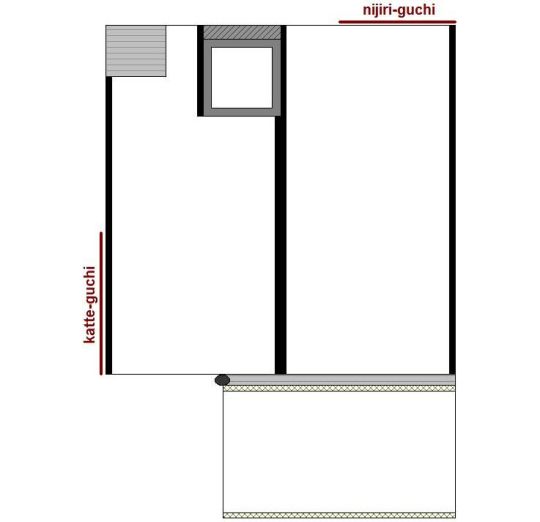
³Sōkyū [宗及].
This was Tsuda Sōkyū [津田宗吸; ? ~ 1591] (he is also known as Tennōji-ya Sōkyū [天王寺屋宗吸]), one of Rikyū's closest friends, and perhaps the man whose sensitivity and taste in chanoyu he most admired among all of his contemporaries. It is perhaps indicative of his delight in this man that, over the course of their lifetimes, Sōkyū's name is mentioned more often than any other in the guest lists of Rikyū's gatherings. And as for the passage in which Rikyū describes Sōkyū’s tea (preserved in Book Seven of the Nampō Roku), it is nothing short of gushing in its praise*.
Sōkyū, together with Rikyū, and (Rikyū's nemesis) Imai Sōkyū [今井宗久; 1520 ~ 1593], were considered the three greatest chajin of the period.
__________
*Some have questioned why, if Sōkyū’s chanoyu was truly as wonderful as Rikyū describes, he had not been better dealt with by history. And the simple fact is that, while Sōkyū built up the wealth of the Tennōji-ya house under Nobunaga’s patronage, he fell in with Akechi Mitsuhide after Nobunaga’s seppuku. And while Hideyoshi seemed to forgive him, and retained his services as one of his sa-dō [茶頭], this unfaithfulness toward their lord left a bad taste in Hideyoshi’s mouth, for which Sōkyū paid with his reputation.
⁴Jōrin [紹林].
All that can be said for certain about Tateishi* Jōrin [立石紹林; his dates of birth and death are not known] is that he was a chajin from Sakai -- who had apparently studied chanoyu with Jōō (as his name suggests).
That said, he seems to have been a personal friend of Rikyū†: his name appears occasionally as a guest in Rikyū's various kaiki: and on each of these occasions the arrangements suggest a personal (rather than professional, or official) connection‡.
___________
*This is the most likely pronunciation for his surname. Other possibilities include Tachi-ishi, Tateshi, Tateiwa, and Tatsuishi; and it is not possible to know which of these Jōrin preferred.
†Some scholars argue that he was one of Rikyū's students -- though Jōrin's name suggests that they were, rather, co-disciples of Jōō.
‡Sometimes Jōrin appears alone, and sometimes together with other chajin who are known to have been among Rikyū's intimate friends -- such as Tsuda Sōkyū, on the present occasion.
⁵Sho [初].
The shoza.
With respect to the kane-wari:
- the bokuseki was hanging in the tokonoma, with a te-shoku [手燭]* resting on the mat in front (as shown in the sketch) making the toko chō [調];

- the room had the kama in the ro, and a kake-tō-dai [掛燈臺] suspended on the wall near the ro†, so the room was han [半];
- and the habōki and kōgō were placed side by side on the tana, with each of them contacting a different kane: consequently, the tana was chō [調].
Chō + han + chō is han, which is appropriate for the shoza of a chakai that is being held after dark.
___________
*A te-shoku [手燭] is a long-handled candlestick. The guests would pick it up (by the handle) and move up into the toko to inspect the scroll closely.
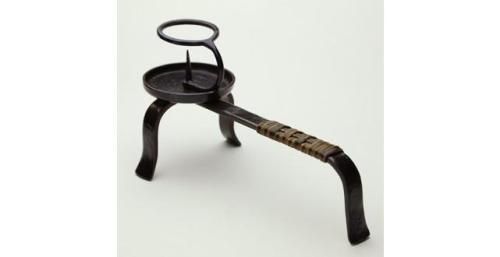
†The kake-tō-dai was suspended near the heri, and so would have been counted as chō -- thus not changing the count for the room as determined from the utensil mat.
⁶Migi dō-zen [右同前].
The utensils used during the shoza were the same as at the afternoon's chakai. However, it is important to understand that, because the utensils were the same, the gathering was not conducted in exactly the same way -- since, after dark, various kinds of artificial illumination would have been needed, and these would impact the kane-wari.
The utensils used during the shoza, according to the afternoon’s kaiki, were:
◦ the Yoku-ryō-an bokuseki [欲了庵墨跡];
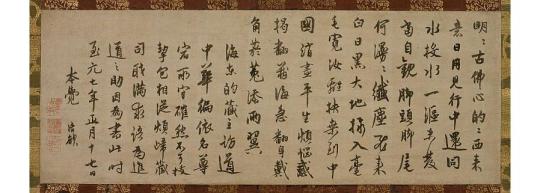
◦ Rikyū's ko-arare uba-guchi kama [小霰姥口釜];
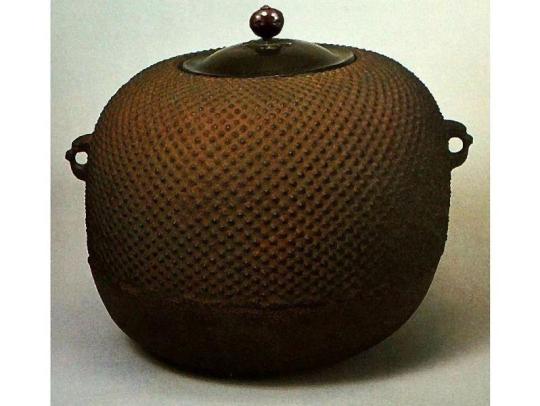
◦ and Rikyū's ruri-suzume kōgō [瑠璃雀香合] and a go-sun-hane [五寸羽].

⁷Shiru hoshi-na saku-saku [汁 干菜 サク〰].
This was miso-shiru.
Hoshi-na [干菜] refers to the dried leaves of the various brassicaceous greens -- especially those of the “root vegetables” daikon [大根] and kabura [蕪] (the Japanese turnip), which usually go to waste.
People -- especially the poor* -- would cut the leaves off the root along with a small part of the crown (which holds the leaves together in a bunch), and drape them over a rope strung under the eves (with the crown of the root above the rope, and the leaves dangling underneath) to dry. The dried leaves provided a source of greens during the lean winter season, when vegetables were scarce.
While saku-saku is onomatopoeiac (suggesting the sound of eating crunchy vegetables), Rikyū here seems to be using the word to mean “coarsely chopped” greens -- in this case, he is referring to the dried leaves (which would have been rehydrated by soaking in water before being chopped).
The chopped greens were added to the miso-shiru just before it was served.
___________
*Since drying gives the leaves a unique taste, the practice was also adopted by the upper classes, to provide a novel flavor to their soups.
⁸Ume-katsuo [梅カツホ].
Tanaka Senshō says this means katsuo that is added to (mashed) ume pulp -- though he appears unsure of precisely how it is made*.
Ume-katsuo refers to a paste made by mashing ume-boshi (salt-pickled Japanese “ume“ -- plums), and then adding katsuo-boshi and finely chopped kombu (both of which were first used to make the dashi for the miso-shiru†) to the paste -- the quantities of each of these being determined simply by taste. The katsuo-bushi and kombu (which had already been boiled to make dashi, hence were quite mild in taste) reduce both the sourness and the saltiness of the ume-boshi.
The ume-katsuo would have been served in a small bowl, perhaps along with raw vegetable spears, to accompany several rounds of sake.
__________
*Shibayama Fugen only writes “this subject needs further research.”
†Commercially prepared ume-katsuo is generally prepared with dry katsuo-bushi. This means it has a much stronger flavor.
The commercial product is generally eaten with rice -- often being added to things like o-nigiri and maki-sushi. However, it seems that the homemade version, which used the kombu and katsuo-bushi left over from making dashi, would have had a sufficiently mild taste, so the paste could be eaten by itself.
⁹Yu-namasu [柚ナマス].
Namasu [膾] is a sort of raw salad, made primarily from julienned daikon and carrot, dressed with a mixture of rice vinegar, soy sauce, and mirin. Here, in addition to the daikon and carrot, the namasu also contained slivers of the skin of the yuzu [柚子], to give the dish a citron flavor.
¹⁰Fu-no-yaki ・ shiitake [フノヤキ ・ 椎茸].
These were the kashi.
Fu-no-yaki [麩の焼] are small wheat-flour crêpes, thinly spread with (naturally sweet) white miso, and then rolled or folded into bite-sized pieces.
The shiitake [椎茸] mushrooms would have been grilled on skewers over a charcoal fire, while being lightly dusted with salt.
¹¹Go [後].
The goza.
As for the kane-wari:
- the chabana was displayed on the floor of the toko*, and the kake-tō-dai was hung on the toko-bashira, making the toko han [半];

- the room had the kama in the ro, plus the mizusashi (with the bon-chaire arranged on the mat in front of it), the chawan placed on the left side of the mat (adjacent to the heri), and the futaoki (possibly with the hishaku resting on it, as shown above†) also placed on the left side of the mat -- and a te-shoku arranged in the middle of the mat so that it contacted the central kane: therefore the room was han [半];
- and the tana was empty, making it chō [調].
Han + han + chō is chō, which is correct for the goza of a gathering that is held at night.
__________
*The scroll would have been removed if the chabana was arranged in the toko, because the chabana would have made it impossible for the guests to move into the toko to inspect the scroll.
Furthermore, the light from a te-shoku (which would be necessary if the scroll remained hanging) would have made the chabana look unnatural, since the light would have been coming from a source too close to the mat.
†While the sketch shows the hishaku resting on the futaoki (only the handle is visible projecting from beneath the tana), it is also possible that the futaoki was displayed alone, near the back edge of the yū-yo [有余]. See footnote 13, below, for additional comments -- and more detailed sketches of the utensil mat (without the tana obstructing the view), which illustrate these two possibilities.
¹²Chaire Shōzan* maru-bon [茶入 松山 丸盆].
This was a meibutsu chaire that had been made in Korea† during the early fifteenth century. The four shifuku that accompany this chaire are shown below‡.



The chaire was arranged on a “maru-bon” [丸盆] -- a round tray. Unfortunately, the tray that was paired with this chaire was destroyed in the (Edo) Great Fire of 1829, so its make and dimensions have been lost**. For the sketch I assumed it was a Japanese-made piece, paired with this chaire by Rikyū††.
The chaire is marked with a red dot in the Enkaku-ji version of this kaiki, implying that it was the featured utensil -- a rare treasure (probably newly added to Hideyoshi’s collection) for three good friends and chajin to inspect and enjoy.
__________
*Note that the name of this chaire is traditionally pronounced Shōzan katatsuki [松山肩衝].
There is a different chaire known as Matsuyama [松山] -- the kanji used for the name are the same -- that was fired at the Karatsu kilns. This other chaire was named by Kobori Masakazu (Enshū). The reader is cautioned not to confuse the two.
†A kan-saku karamono chaire [韓作唐物茶入]. These chaire usually conform closely to the demands of kane-wari -- as is true in this case. The Shōzan katatsuki, for example, measures 2-sun 5-bu in diameter, which is the size of the prototypical “large katatsuki.”
‡Several of the antique shifuku (dating from the sixteenth and seventeenth centuries) were destroyed in the fire of 1829, and the old cloth was rewoven in Japan so that replacements could be made (these replicas are the shifuku shown in the photo). It was circumstances such as this that ultimately resulted in the establishment of the “meibutsu-gire [名物裂] industry” in Japan.
**In other words, whether it had been selected according to Jōō's formula, or Rikyū's.
Jōō's trays were 3-sun larger than the chaire on all four sides, while Rikyū's were 2-sun larger on all four sides.
Jōō created the chaire-bon (and also introduced the idea of pairing a specific chaire with a specific tray). Prior to his time, the only trays commonly available for use under the chaire were copies of the earlier naga-bon [長盆] (and the other meibutsu trays from Ashikaga Yoshimasa's period), and the one-shaku-square naka-bon [中盆] (the immediate precursor of -- and perhaps the ultimate inspiration for -- Jōō's trays).
This chaire is frequently photographed on a red carved-lacquer (tsui-shu [堆朱]) Chinese tray. It was “paired” with this tray sometime after the 1829 fire (the tray is of late Ching dynasty make). Neither that tray, nor its dimensions, have anything to do with Jōō’s or Rikyū’s teachings.
††While a larger tray, of the sort preferred by Jōō, would have been used in the same way as is described below, its size would have made it more difficult to use at night (in addition to necessitating moving the mizusashi farther away from the host’s seat, the larger tray would have interfered with the placement of the te-shoku -- the long-handled candlestick -- next to the mukō-ro, which was the only light available on the utensil mat).
¹³Sono soto, migi dō-zen [其外、右同前].
Again, while the utensils used during this chakai were the same as at the afternoon’s gathering (apart from the chaire, as Rikyū notes), this does not mean that they were all used in exactly the same way.
As mentioned above (under footnote 11), it is likely that the kakemono was removed during the naka-dachi, since it would not have been possible for the guests to appreciate it properly with the chabana on the floor of the toko, while the chabana (for which Rikyū likely used a single white chrysanthemum blossom) was arranged in the Tsuru-no-hito-koe [鶴ノ一聲]* hanaire (which was standing on an usu-ita†) on the floor of the tokonoma.

And, while a white chrysanthemum touched with pink may have been displayed during the goza of the afternoon’s chakai, a pure white one would have been used at night.
Turning to the utensil mat, because a chaire-bon was used at this night gathering, it would have been impossible to place the chawan next to the bon-chaire in front of the mizusashi (not only as a consequence of the tray’s size, but likewise because the te-shoku was also present on the far side of the yū-yo [有余])‡.
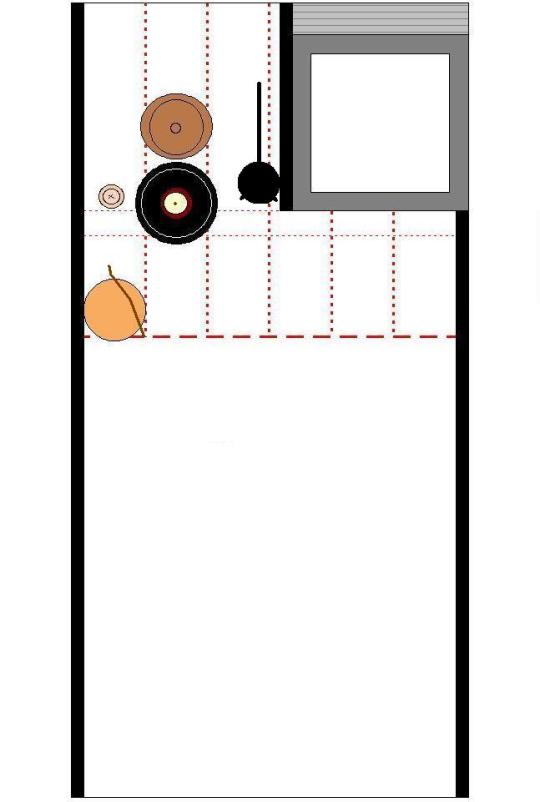
Therefore, if Rikyū wished to display the chawan in the room along with the chaire (which he may have done, since this would reduce the number of trips that the host would have to make back and forth between the temae-za and the katte-guchi), he would have had to place the chawan on the left side of the mat near his left knee, while the bon-chaire would have been centered on the mizusashi, as shown in the two sketches. In this case, the futaoki could have been placed by itself near the far side of the yū-yo (as shown above), or placed farther away, with the hishaku resting on top of it (below)**. It is important to note that the handle must stop short of the yū-yo, and should not project into this space.
It is also possible that Rikyū simply did not place the futaoki or hishaku on the utensil mat at all, bringing them in together with the koboshi.
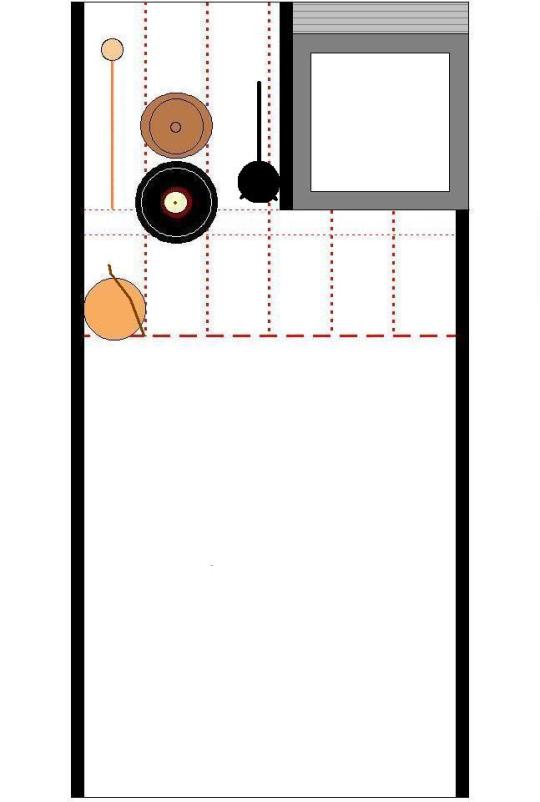
As for the rest of the tori-awase, in addition to the bon-chaire Rikyū used:
◦ his Shigaraki mizusashi [信樂水指], in front of which was arranged the bon-chaire;

◦ the chawan was Rikyū's Soto-ga-hama ido [外ヵ濱井戸],

◦ with an ori-tame [折撓] chashaku resting on it;

◦ the futaoki, regardless of whether it was actually displayed on the utensil mat or brought in with the koboshi at the beginning of the temae, was a take-wa [竹輪];

◦ and the koboshi was probably a bronze mimi-guchi [耳口] vessel.

However, since this was a night gathering, it is possible that the chabana was excluded††.
__________
*This hanaire was also known as Tsuru-no-hashi [鶴ノ波子], and occasionally it is referred to under this name (and so confusing to scholars).
†Rikyū’s usu-ita was what is called the yahazu-ita [矢筈板] today. It measured 1-shaku 3-sun 2-bu from side to side, and 9-sun 2-bu from front to back; and was painted with black lacquer.
‡This is because Rikyū used a large chawan together with a large chaire. While this kind of combination is possible when the chaire is placed directly on the mat, as during the afternoon’s chakai (in which case, the distance between the chawan and chaire was 1-sun 5-bu), when a chaire-bon is used, there is not enough space (since even Rikyū's smaller chaire-bon was 2-sun larger than the chaire on all four sides).
With respect to the temae, if all of the utensils were arranged on the utensil mat as shown, the host would only have to bring out the koboshi at the beginning of the temae. After placing it on the left, he would move the bon-chaire forward onto the temae-za (so that the chaire is to the right of the second kane, while touching the front edge of the yū-yo [有余] on the back side: moving the chaire onto the temae-za -- the space forward of the yū-yo and between the left-most and right-most of the kane -- constitutes the beginning of the temae); and, leaving the chawan on the left side of the mat for the nonce, move the futaoki to its place on the right side of the mat, rest the hishaku on top of it, and then everyone would bow together for the sō-rei [総礼]. This is the situation illustrated below.
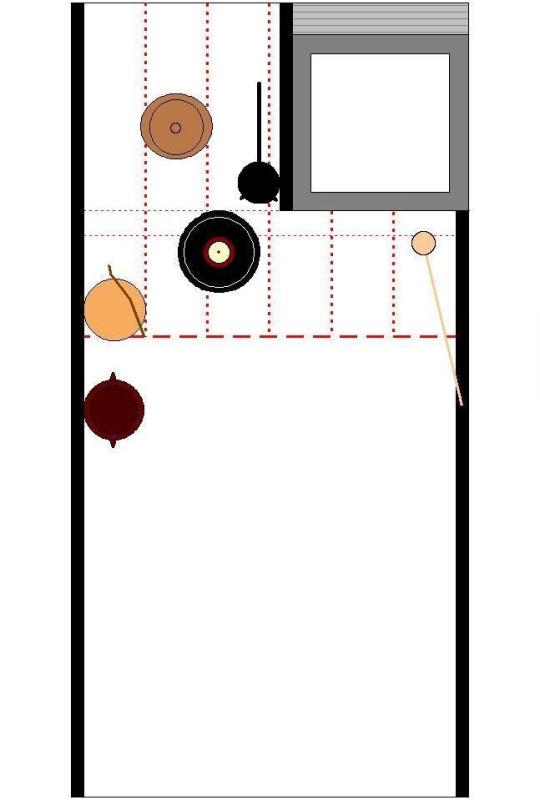
Immediately after the sō-rei, the host would remove his fukusa, fold it, and insert it into the futokoro of his kimono. Then, moving the chaire in front of his knees, he would remove its shifuku, and place the shifuku on the left side of the mat near the mizusashi. Then, taking his fukusa out, he would clean the chaire-bon, and then place it down on the left side of the mat (so that the chaire, when it is set on the tray, will be immediately to the right of the first kane, as usual). After that he would return the fukusa to his futokoro, pick up the chaire, remove the fukusa and clean it, return the fukusa to his futokoro, and then carefully place the chaire down on the chaire-bon.

Then the host would pick up the chawan and move it to the middle of the mat (so that its foot is immediately to the right of the central kane, as usual, and the far rim touches the front edge of the yū-yo -- as shown above). Taking out his fukusa, the host picks up the chashaku, cleans it, and rests it on the chaire-bon, to the right of the chaire.
When it is time for the first chasen-tōshi, the host moves the te-shoku forward immediately after he rests the chasen in the chawan -- so he had sufficient light to see what he is doing (since it will be needed not only while performing the chasen-tōshi, but also while measuring out and preparing the koicha).
After the chawan of koicha is offered to the guests, the te-shoku is also placed out next to it. The shōlyaku takes both the chawan and the te-shoku back to his seat, and keeps the candlestick there until the end of the temae.
The actual preparation of the koicha (and, possibly, the service of usucha using the tea remaining in the chaire) is performed as usual (when a bon-chaire is used).
At the end of the temae, after cleaning the chashaku with his fukusa and then resting it on top of the chawan again, the chawan would be picked up and moved to the left side of the mat (to rest in the same place shown in the upper sketch), so that the host would have room to deal with the cleaning of the chaire and the chaire-bon.
◎ The same procedure would have been used if the chaire-bon were of the larger size preferred by Jōō (i.e., 3-sun 5-bu larger than the chaire on all four sides).
**The futaoki, placed in associated with the central kane, is needed for the purpose of kane-wari. Whether it is placed by itself (near the front corner of the ro), or with the hishaku resting on top of it, is a matter of the host’s personal preference.
††Meaning that the futaoki would have been displayed in the middle of the mat, in contact with the central kane.
0 notes